Dissertation: Digital Banking and Customer Satisfaction at Rokel Bank
VerifiedAdded on 2022/10/19

DISSERTATION
Name of the Student
Name of the University
Author Note
Paraphrase This Document

Acknowledgement
I am using this opportunity to express my gratitude to everyone who supported me throughout
the course of this MBA project. I am thankful for their aspiring guidance, invaluably constructive
criticism and friendly advice during the project work. I am sincerely grateful to them for sharing
their truthful and illuminating views on a number of issues related to the project.
I express my warm thanks to Mr. [SURNAME] and Ms. [SURNAME] for their support and
guidance at [COMPANY NAME].
I would also like to thank my project external guide Mr. [SURNAME] from the [NAME]
company and Ms. [SURNAME] and all the people who provided me with the facilities being
required and conductive conditions for my MBA project.
Thank you,
Author
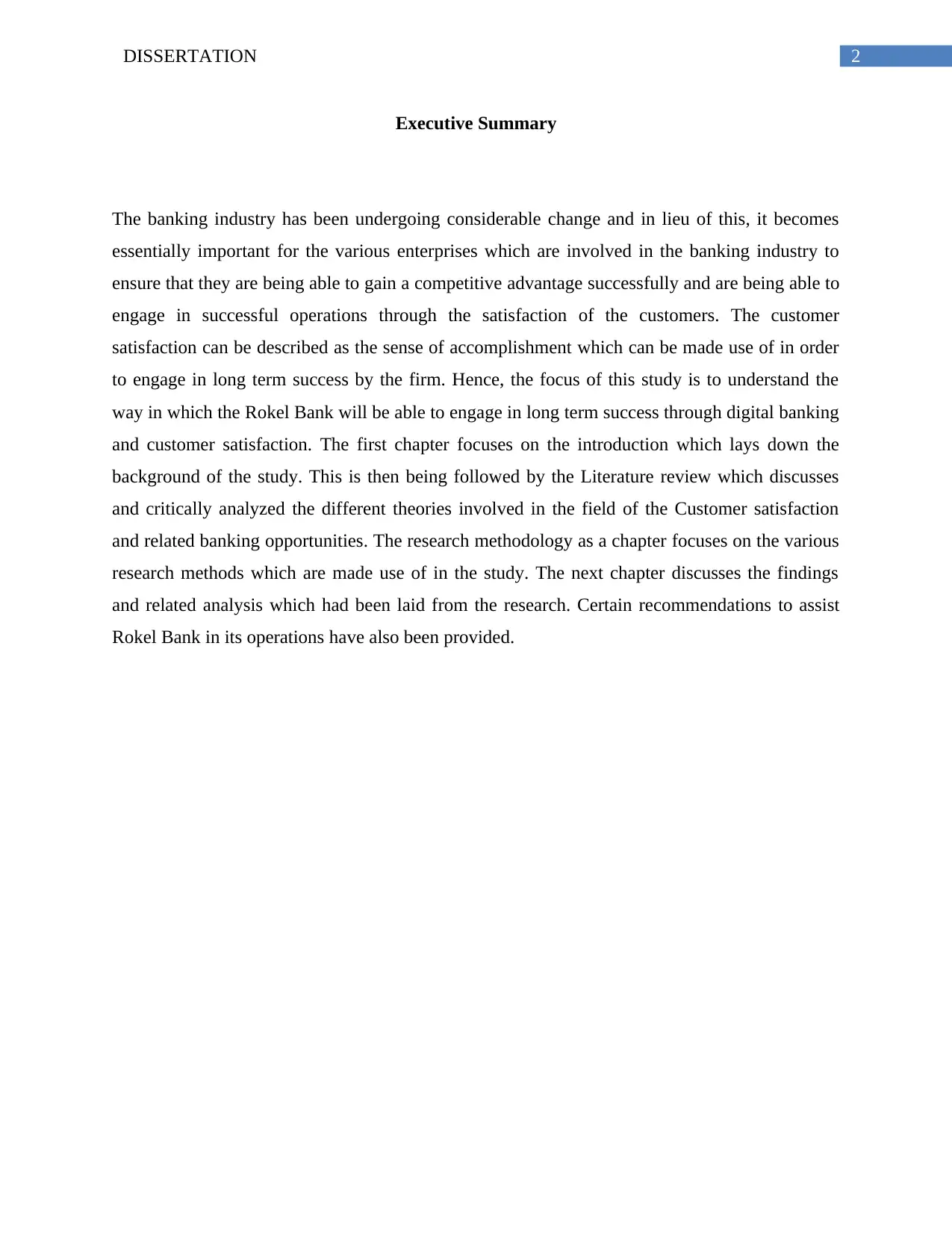
Executive Summary
The banking industry has been undergoing considerable change and in lieu of this, it becomes
essentially important for the various enterprises which are involved in the banking industry to
ensure that they are being able to gain a competitive advantage successfully and are being able to
engage in successful operations through the satisfaction of the customers. The customer
satisfaction can be described as the sense of accomplishment which can be made use of in order
to engage in long term success by the firm. Hence, the focus of this study is to understand the
way in which the Rokel Bank will be able to engage in long term success through digital banking
and customer satisfaction. The first chapter focuses on the introduction which lays down the
background of the study. This is then being followed by the Literature review which discusses
and critically analyzed the different theories involved in the field of the Customer satisfaction
and related banking opportunities. The research methodology as a chapter focuses on the various
research methods which are made use of in the study. The next chapter discusses the findings
and related analysis which had been laid from the research. Certain recommendations to assist
Rokel Bank in its operations have also been provided.
⊘ This is a preview!⊘
Do you want full access?
Subscribe today to unlock all pages.

Trusted by 1+ million students worldwide
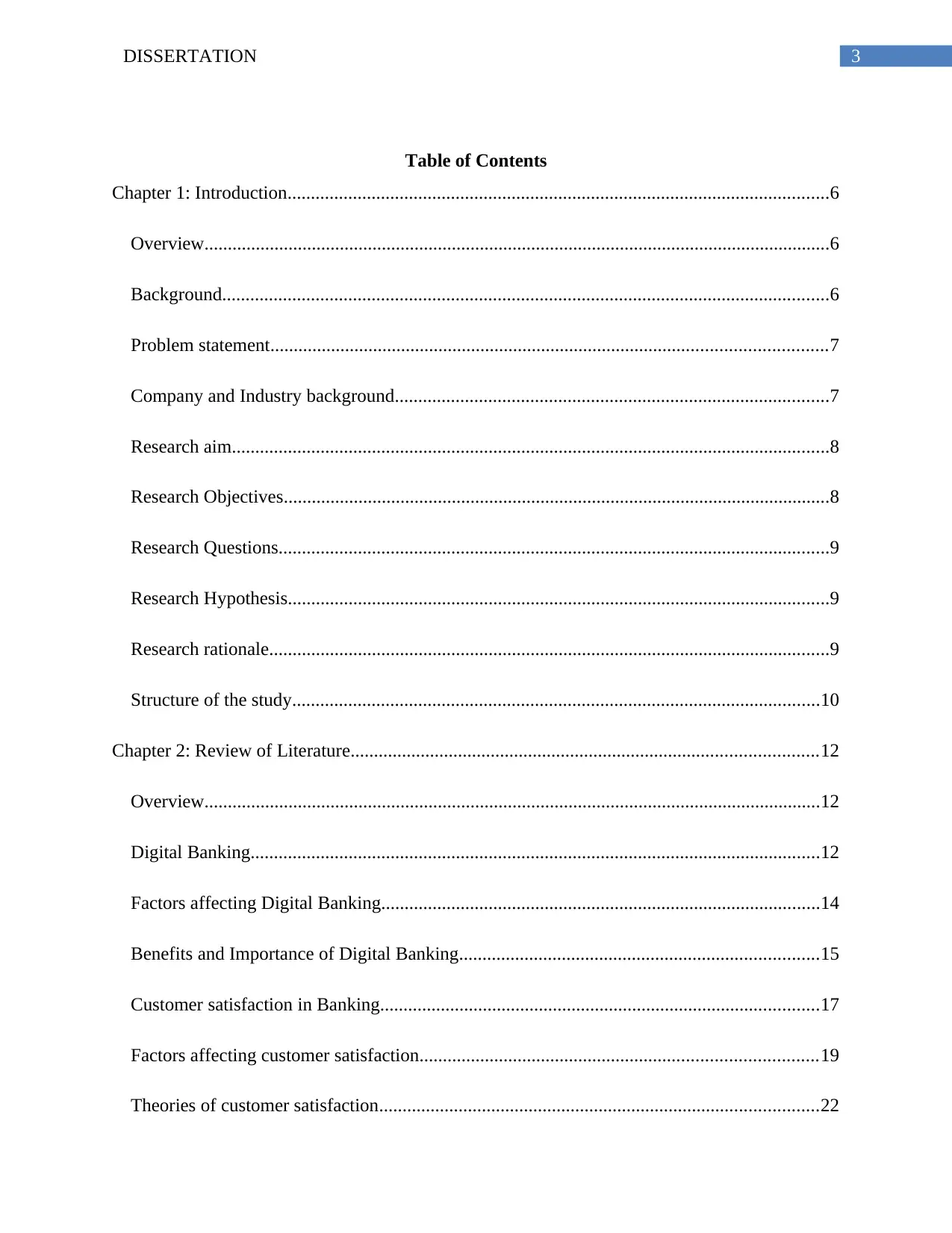
Table of Contents
Chapter 1: Introduction....................................................................................................................6
Overview......................................................................................................................................6
Background..................................................................................................................................6
Problem statement.......................................................................................................................7
Company and Industry background.............................................................................................7
Research aim................................................................................................................................8
Research Objectives.....................................................................................................................8
Research Questions......................................................................................................................9
Research Hypothesis....................................................................................................................9
Research rationale........................................................................................................................9
Structure of the study.................................................................................................................10
Chapter 2: Review of Literature....................................................................................................12
Overview....................................................................................................................................12
Digital Banking..........................................................................................................................12
Factors affecting Digital Banking..............................................................................................14
Benefits and Importance of Digital Banking.............................................................................15
Customer satisfaction in Banking..............................................................................................17
Factors affecting customer satisfaction.....................................................................................19
Theories of customer satisfaction..............................................................................................22
Paraphrase This Document
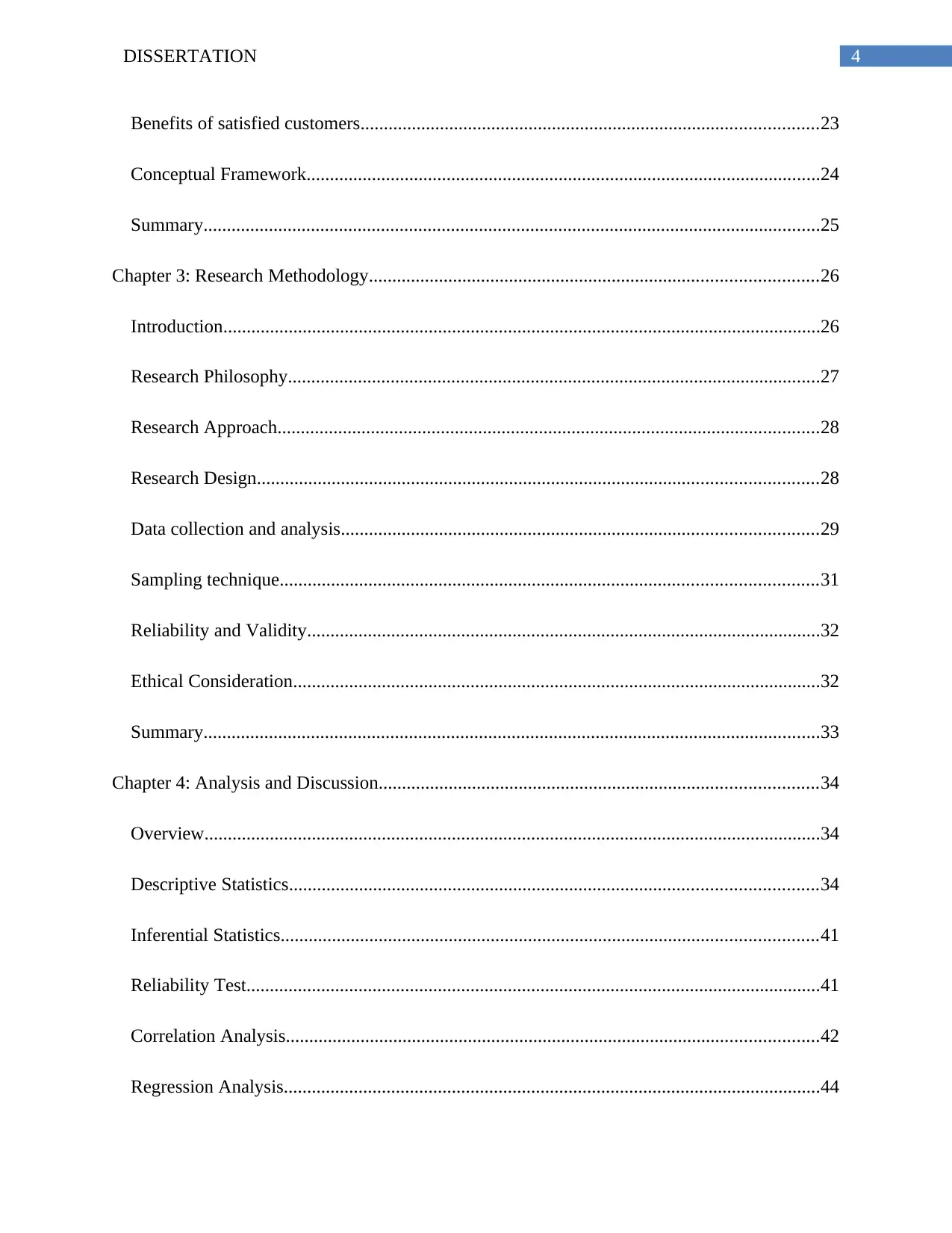
Benefits of satisfied customers..................................................................................................23
Conceptual Framework..............................................................................................................24
Summary....................................................................................................................................25
Chapter 3: Research Methodology................................................................................................26
Introduction................................................................................................................................26
Research Philosophy..................................................................................................................27
Research Approach....................................................................................................................28
Research Design........................................................................................................................28
Data collection and analysis......................................................................................................29
Sampling technique...................................................................................................................31
Reliability and Validity..............................................................................................................32
Ethical Consideration.................................................................................................................32
Summary....................................................................................................................................33
Chapter 4: Analysis and Discussion..............................................................................................34
Overview....................................................................................................................................34
Descriptive Statistics.................................................................................................................34
Inferential Statistics...................................................................................................................41
Reliability Test...........................................................................................................................41
Correlation Analysis..................................................................................................................42
Regression Analysis...................................................................................................................44
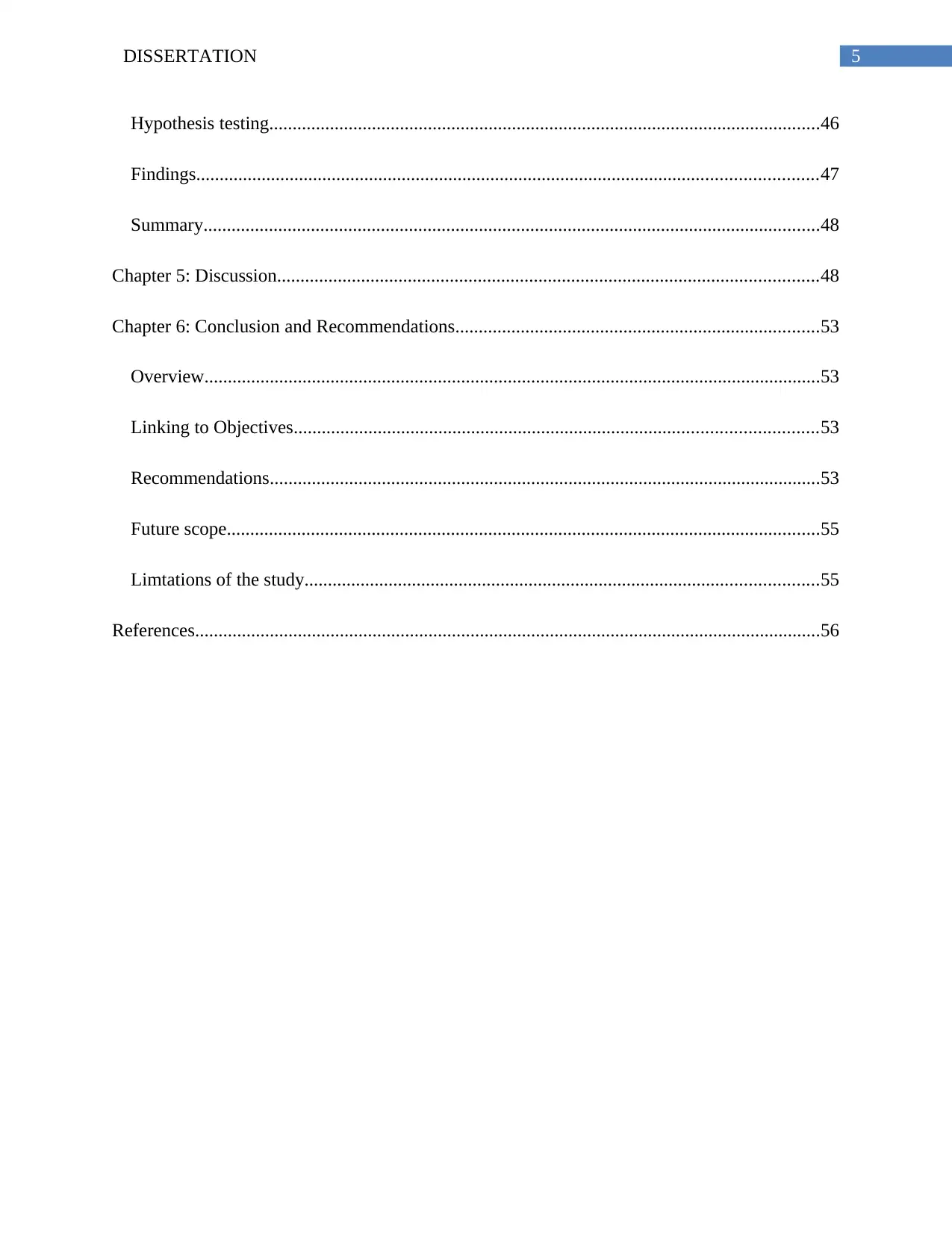
Hypothesis testing......................................................................................................................46
Findings.....................................................................................................................................47
Summary....................................................................................................................................48
Chapter 5: Discussion....................................................................................................................48
Chapter 6: Conclusion and Recommendations..............................................................................53
Overview....................................................................................................................................53
Linking to Objectives................................................................................................................53
Recommendations......................................................................................................................53
Future scope...............................................................................................................................55
Limtations of the study..............................................................................................................55
References......................................................................................................................................56
⊘ This is a preview!⊘
Do you want full access?
Subscribe today to unlock all pages.

Trusted by 1+ million students worldwide
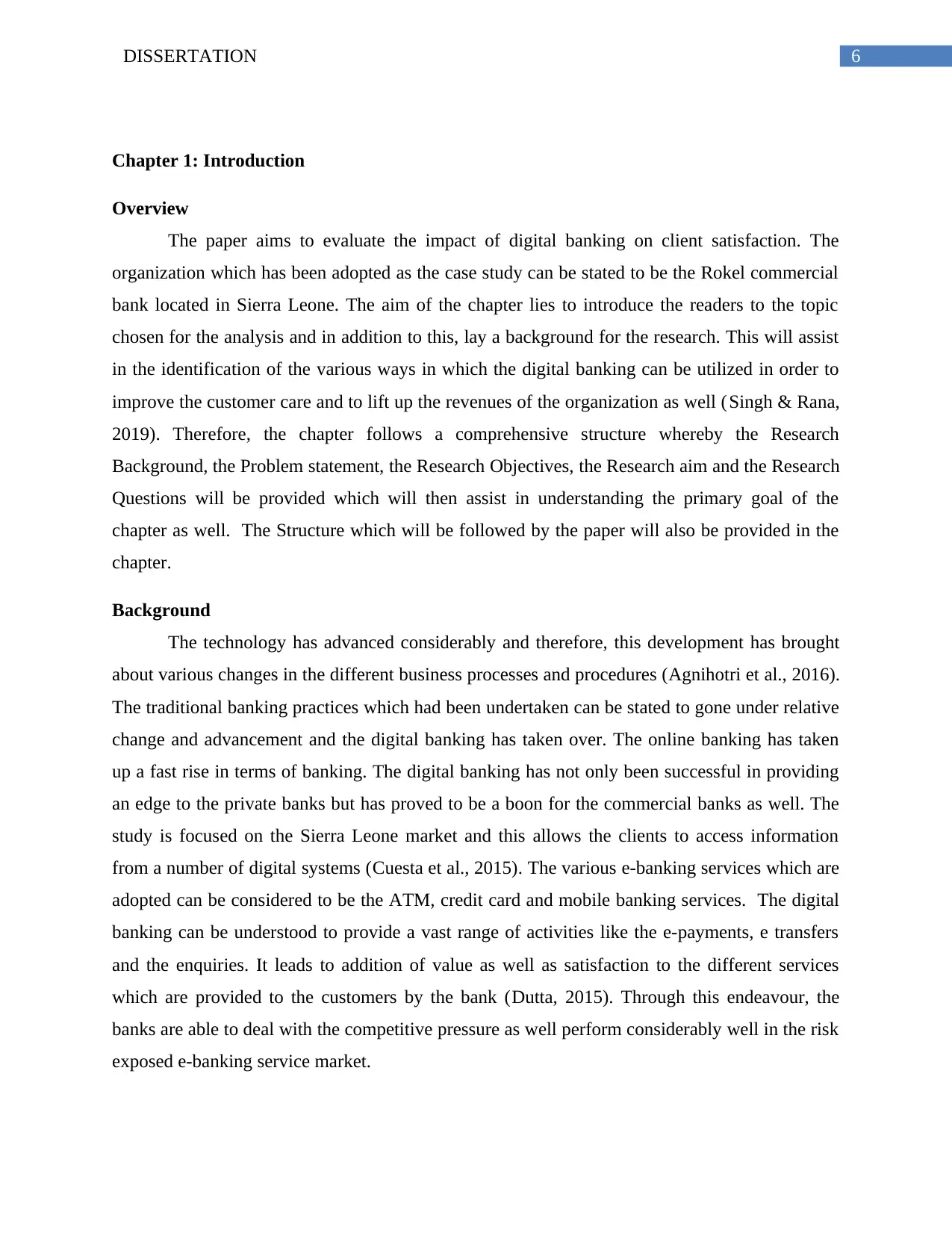
Chapter 1: Introduction
Overview
The paper aims to evaluate the impact of digital banking on client satisfaction. The
organization which has been adopted as the case study can be stated to be the Rokel commercial
bank located in Sierra Leone. The aim of the chapter lies to introduce the readers to the topic
chosen for the analysis and in addition to this, lay a background for the research. This will assist
in the identification of the various ways in which the digital banking can be utilized in order to
improve the customer care and to lift up the revenues of the organization as well ( Singh & Rana,
2019). Therefore, the chapter follows a comprehensive structure whereby the Research
Background, the Problem statement, the Research Objectives, the Research aim and the Research
Questions will be provided which will then assist in understanding the primary goal of the
chapter as well. The Structure which will be followed by the paper will also be provided in the
chapter.
Background
The technology has advanced considerably and therefore, this development has brought
about various changes in the different business processes and procedures (Agnihotri et al., 2016).
The traditional banking practices which had been undertaken can be stated to gone under relative
change and advancement and the digital banking has taken over. The online banking has taken
up a fast rise in terms of banking. The digital banking has not only been successful in providing
an edge to the private banks but has proved to be a boon for the commercial banks as well. The
study is focused on the Sierra Leone market and this allows the clients to access information
from a number of digital systems (Cuesta et al., 2015). The various e-banking services which are
adopted can be considered to be the ATM, credit card and mobile banking services. The digital
banking can be understood to provide a vast range of activities like the e-payments, e transfers
and the enquiries. It leads to addition of value as well as satisfaction to the different services
which are provided to the customers by the bank (Dutta, 2015). Through this endeavour, the
banks are able to deal with the competitive pressure as well perform considerably well in the risk
exposed e-banking service market.
Paraphrase This Document
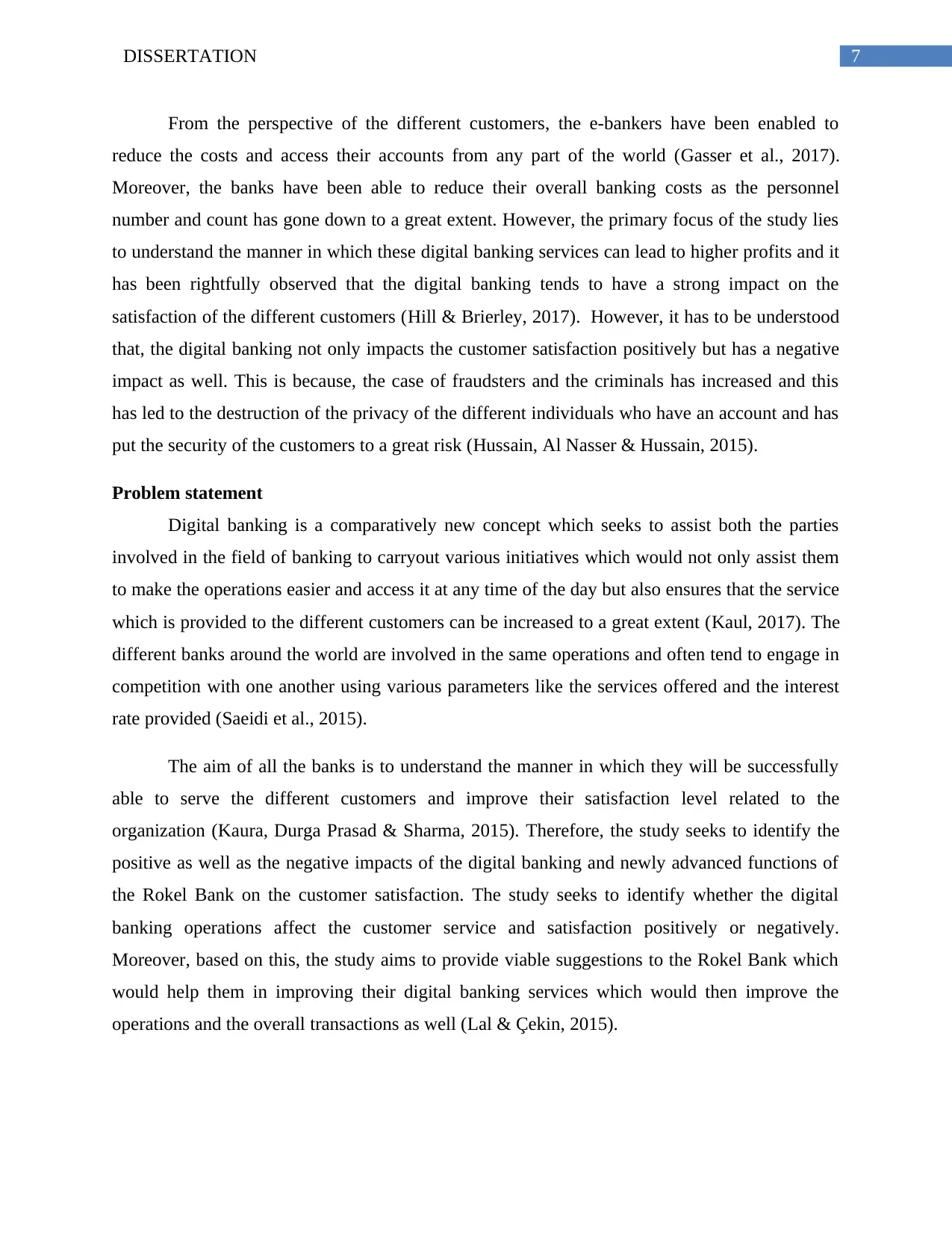
From the perspective of the different customers, the e-bankers have been enabled to
reduce the costs and access their accounts from any part of the world (Gasser et al., 2017).
Moreover, the banks have been able to reduce their overall banking costs as the personnel
number and count has gone down to a great extent. However, the primary focus of the study lies
to understand the manner in which these digital banking services can lead to higher profits and it
has been rightfully observed that the digital banking tends to have a strong impact on the
satisfaction of the different customers (Hill & Brierley, 2017). However, it has to be understood
that, the digital banking not only impacts the customer satisfaction positively but has a negative
impact as well. This is because, the case of fraudsters and the criminals has increased and this
has led to the destruction of the privacy of the different individuals who have an account and has
put the security of the customers to a great risk (Hussain, Al Nasser & Hussain, 2015).
Problem statement
Digital banking is a comparatively new concept which seeks to assist both the parties
involved in the field of banking to carryout various initiatives which would not only assist them
to make the operations easier and access it at any time of the day but also ensures that the service
which is provided to the different customers can be increased to a great extent (Kaul, 2017). The
different banks around the world are involved in the same operations and often tend to engage in
competition with one another using various parameters like the services offered and the interest
rate provided (Saeidi et al., 2015).
The aim of all the banks is to understand the manner in which they will be successfully
able to serve the different customers and improve their satisfaction level related to the
organization (Kaura, Durga Prasad & Sharma, 2015). Therefore, the study seeks to identify the
positive as well as the negative impacts of the digital banking and newly advanced functions of
the Rokel Bank on the customer satisfaction. The study seeks to identify whether the digital
banking operations affect the customer service and satisfaction positively or negatively.
Moreover, based on this, the study aims to provide viable suggestions to the Rokel Bank which
would help them in improving their digital banking services which would then improve the
operations and the overall transactions as well (Lal & Çekin, 2015).
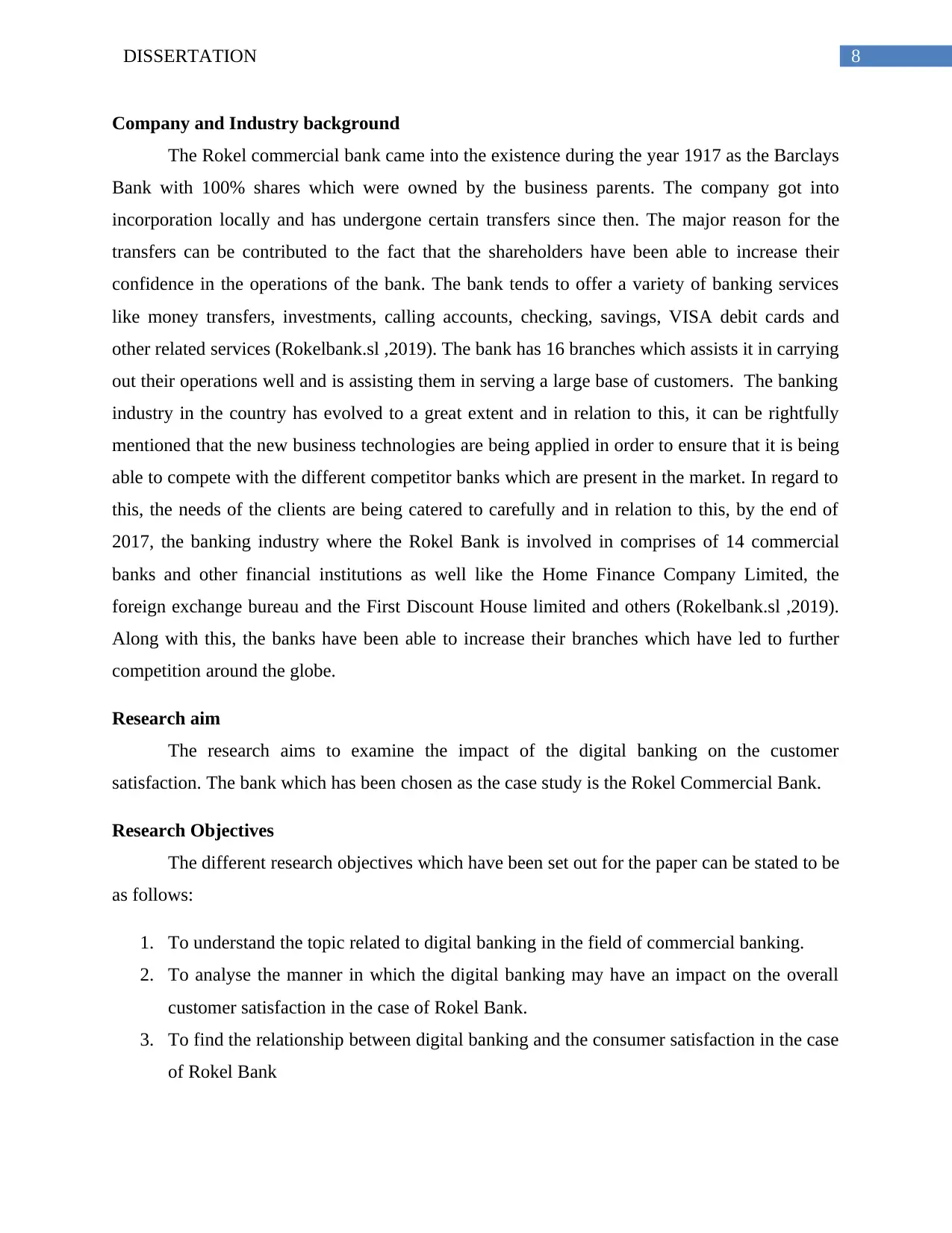
Company and Industry background
The Rokel commercial bank came into the existence during the year 1917 as the Barclays
Bank with 100% shares which were owned by the business parents. The company got into
incorporation locally and has undergone certain transfers since then. The major reason for the
transfers can be contributed to the fact that the shareholders have been able to increase their
confidence in the operations of the bank. The bank tends to offer a variety of banking services
like money transfers, investments, calling accounts, checking, savings, VISA debit cards and
other related services (Rokelbank.sl ,2019). The bank has 16 branches which assists it in carrying
out their operations well and is assisting them in serving a large base of customers. The banking
industry in the country has evolved to a great extent and in relation to this, it can be rightfully
mentioned that the new business technologies are being applied in order to ensure that it is being
able to compete with the different competitor banks which are present in the market. In regard to
this, the needs of the clients are being catered to carefully and in relation to this, by the end of
2017, the banking industry where the Rokel Bank is involved in comprises of 14 commercial
banks and other financial institutions as well like the Home Finance Company Limited, the
foreign exchange bureau and the First Discount House limited and others (Rokelbank.sl ,2019).
Along with this, the banks have been able to increase their branches which have led to further
competition around the globe.
Research aim
The research aims to examine the impact of the digital banking on the customer
satisfaction. The bank which has been chosen as the case study is the Rokel Commercial Bank.
Research Objectives
The different research objectives which have been set out for the paper can be stated to be
as follows:
1. To understand the topic related to digital banking in the field of commercial banking.
2. To analyse the manner in which the digital banking may have an impact on the overall
customer satisfaction in the case of Rokel Bank.
3. To find the relationship between digital banking and the consumer satisfaction in the case
of Rokel Bank
⊘ This is a preview!⊘
Do you want full access?
Subscribe today to unlock all pages.

Trusted by 1+ million students worldwide
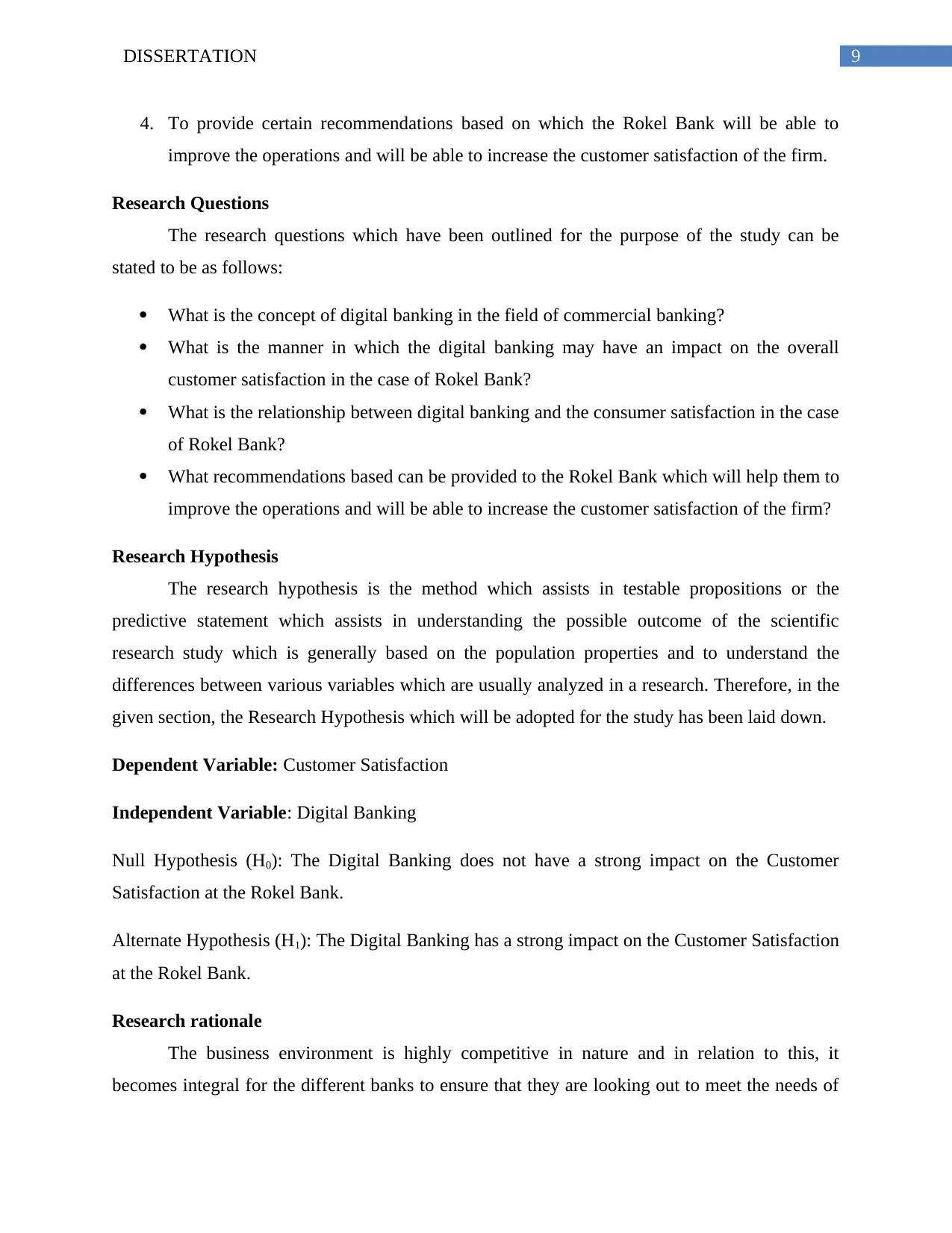
4. To provide certain recommendations based on which the Rokel Bank will be able to
improve the operations and will be able to increase the customer satisfaction of the firm.
Research Questions
The research questions which have been outlined for the purpose of the study can be
stated to be as follows:
What is the concept of digital banking in the field of commercial banking?
What is the manner in which the digital banking may have an impact on the overall
customer satisfaction in the case of Rokel Bank?
What is the relationship between digital banking and the consumer satisfaction in the case
of Rokel Bank?
What recommendations based can be provided to the Rokel Bank which will help them to
improve the operations and will be able to increase the customer satisfaction of the firm?
Research Hypothesis
The research hypothesis is the method which assists in testable propositions or the
predictive statement which assists in understanding the possible outcome of the scientific
research study which is generally based on the population properties and to understand the
differences between various variables which are usually analyzed in a research. Therefore, in the
given section, the Research Hypothesis which will be adopted for the study has been laid down.
Dependent Variable: Customer Satisfaction
Independent Variable: Digital Banking
Null Hypothesis (H0): The Digital Banking does not have a strong impact on the Customer
Satisfaction at the Rokel Bank.
Alternate Hypothesis (H1): The Digital Banking has a strong impact on the Customer Satisfaction
at the Rokel Bank.
Research rationale
The business environment is highly competitive in nature and in relation to this, it
becomes integral for the different banks to ensure that they are looking out to meet the needs of
Paraphrase This Document
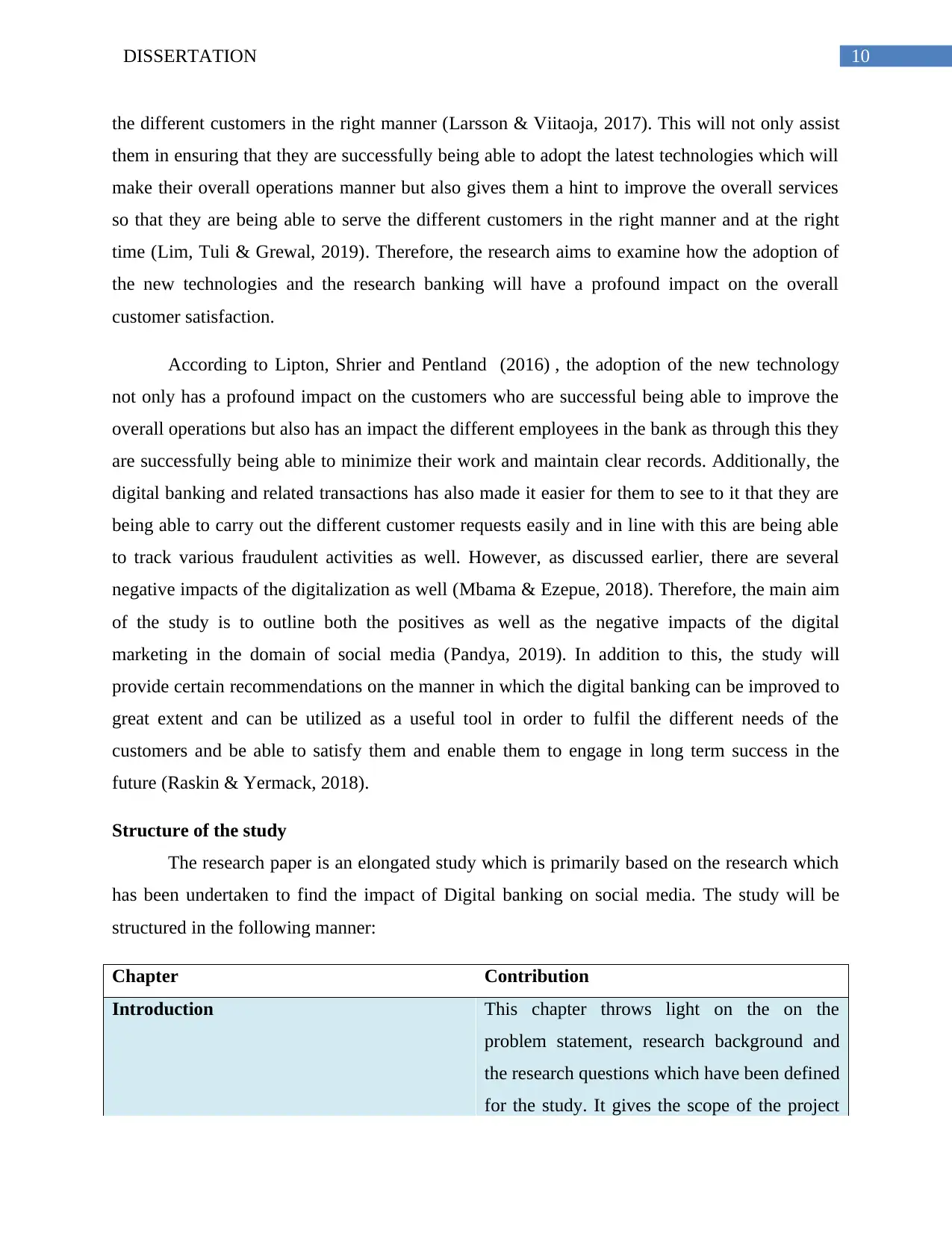
the different customers in the right manner (Larsson & Viitaoja, 2017). This will not only assist
them in ensuring that they are successfully being able to adopt the latest technologies which will
make their overall operations manner but also gives them a hint to improve the overall services
so that they are being able to serve the different customers in the right manner and at the right
time (Lim, Tuli & Grewal, 2019). Therefore, the research aims to examine how the adoption of
the new technologies and the research banking will have a profound impact on the overall
customer satisfaction.
According to Lipton, Shrier and Pentland (2016) , the adoption of the new technology
not only has a profound impact on the customers who are successful being able to improve the
overall operations but also has an impact the different employees in the bank as through this they
are successfully being able to minimize their work and maintain clear records. Additionally, the
digital banking and related transactions has also made it easier for them to see to it that they are
being able to carry out the different customer requests easily and in line with this are being able
to track various fraudulent activities as well. However, as discussed earlier, there are several
negative impacts of the digitalization as well (Mbama & Ezepue, 2018). Therefore, the main aim
of the study is to outline both the positives as well as the negative impacts of the digital
marketing in the domain of social media (Pandya, 2019). In addition to this, the study will
provide certain recommendations on the manner in which the digital banking can be improved to
great extent and can be utilized as a useful tool in order to fulfil the different needs of the
customers and be able to satisfy them and enable them to engage in long term success in the
future (Raskin & Yermack, 2018).
Structure of the study
The research paper is an elongated study which is primarily based on the research which
has been undertaken to find the impact of Digital banking on social media. The study will be
structured in the following manner:
Chapter Contribution
Introduction This chapter throws light on the on the
problem statement, research background and
the research questions which have been defined
for the study. It gives the scope of the project
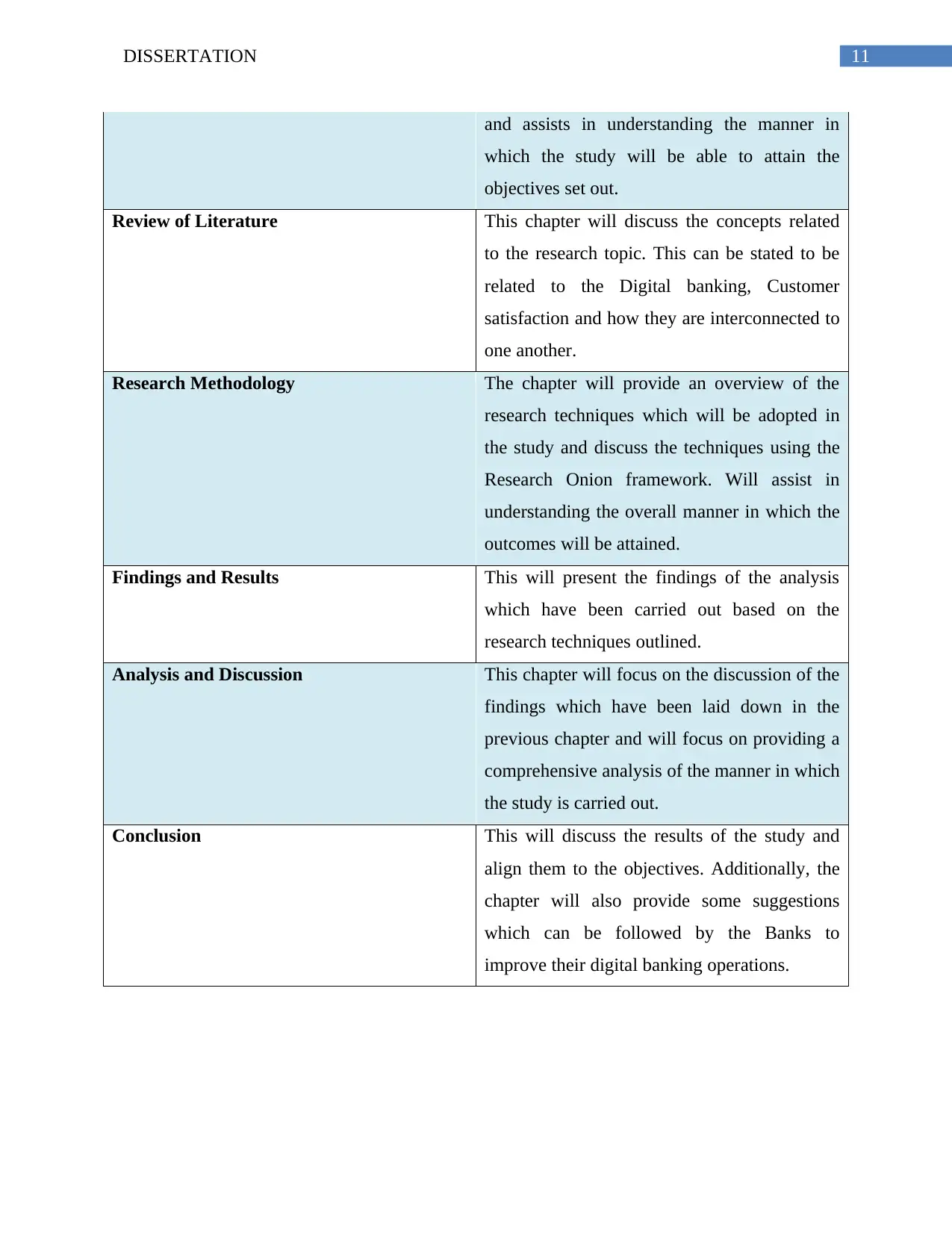
and assists in understanding the manner in
which the study will be able to attain the
objectives set out.
Review of Literature This chapter will discuss the concepts related
to the research topic. This can be stated to be
related to the Digital banking, Customer
satisfaction and how they are interconnected to
one another.
Research Methodology The chapter will provide an overview of the
research techniques which will be adopted in
the study and discuss the techniques using the
Research Onion framework. Will assist in
understanding the overall manner in which the
outcomes will be attained.
Findings and Results This will present the findings of the analysis
which have been carried out based on the
research techniques outlined.
Analysis and Discussion This chapter will focus on the discussion of the
findings which have been laid down in the
previous chapter and will focus on providing a
comprehensive analysis of the manner in which
the study is carried out.
Conclusion This will discuss the results of the study and
align them to the objectives. Additionally, the
chapter will also provide some suggestions
which can be followed by the Banks to
improve their digital banking operations.
⊘ This is a preview!⊘
Do you want full access?
Subscribe today to unlock all pages.

Trusted by 1+ million students worldwide
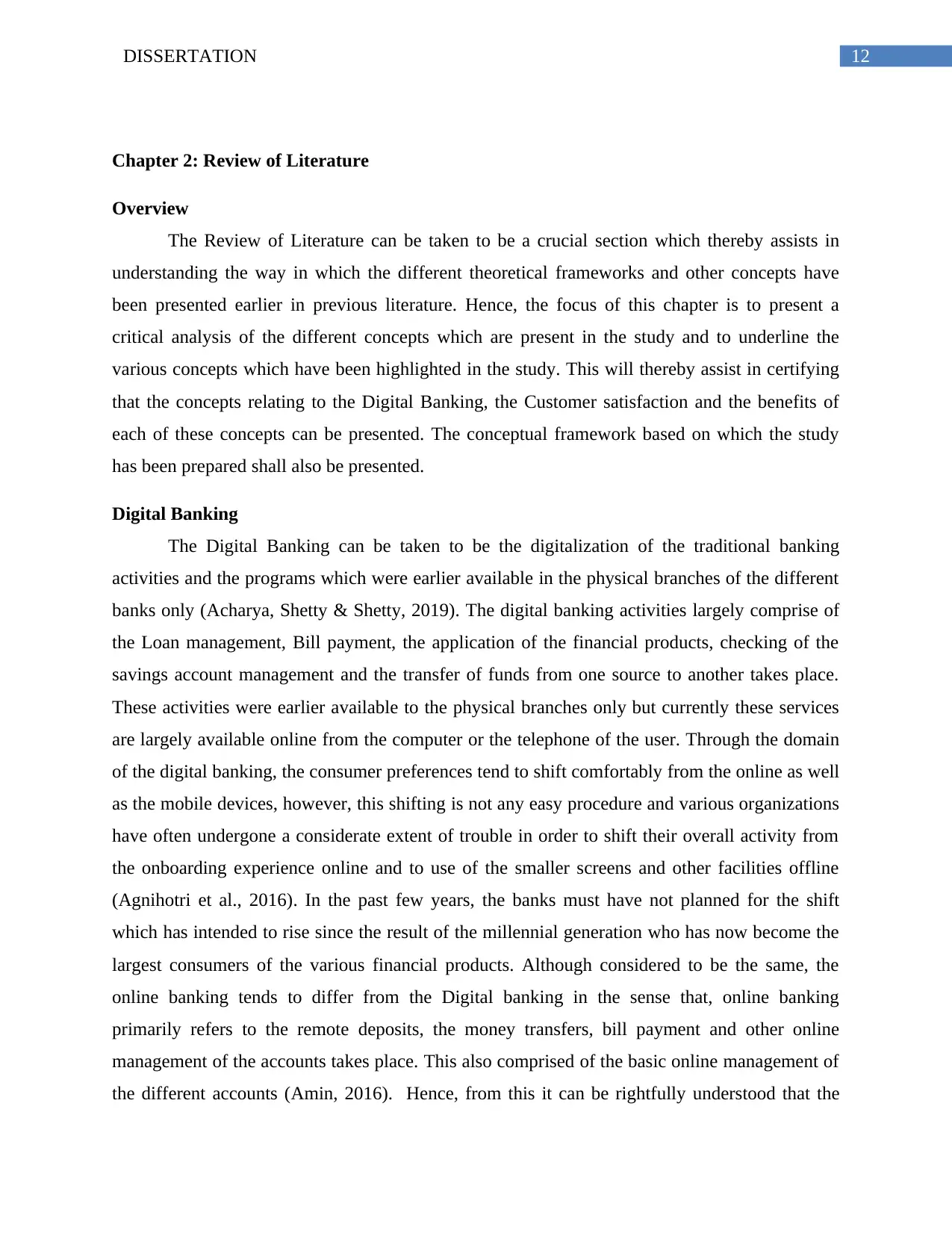
Chapter 2: Review of Literature
Overview
The Review of Literature can be taken to be a crucial section which thereby assists in
understanding the way in which the different theoretical frameworks and other concepts have
been presented earlier in previous literature. Hence, the focus of this chapter is to present a
critical analysis of the different concepts which are present in the study and to underline the
various concepts which have been highlighted in the study. This will thereby assist in certifying
that the concepts relating to the Digital Banking, the Customer satisfaction and the benefits of
each of these concepts can be presented. The conceptual framework based on which the study
has been prepared shall also be presented.
Digital Banking
The Digital Banking can be taken to be the digitalization of the traditional banking
activities and the programs which were earlier available in the physical branches of the different
banks only (Acharya, Shetty & Shetty, 2019). The digital banking activities largely comprise of
the Loan management, Bill payment, the application of the financial products, checking of the
savings account management and the transfer of funds from one source to another takes place.
These activities were earlier available to the physical branches only but currently these services
are largely available online from the computer or the telephone of the user. Through the domain
of the digital banking, the consumer preferences tend to shift comfortably from the online as well
as the mobile devices, however, this shifting is not any easy procedure and various organizations
have often undergone a considerate extent of trouble in order to shift their overall activity from
the onboarding experience online and to use of the smaller screens and other facilities offline
(Agnihotri et al., 2016). In the past few years, the banks must have not planned for the shift
which has intended to rise since the result of the millennial generation who has now become the
largest consumers of the various financial products. Although considered to be the same, the
online banking tends to differ from the Digital banking in the sense that, online banking
primarily refers to the remote deposits, the money transfers, bill payment and other online
management of the accounts takes place. This also comprised of the basic online management of
the different accounts (Amin, 2016). Hence, from this it can be rightfully understood that the
Paraphrase This Document
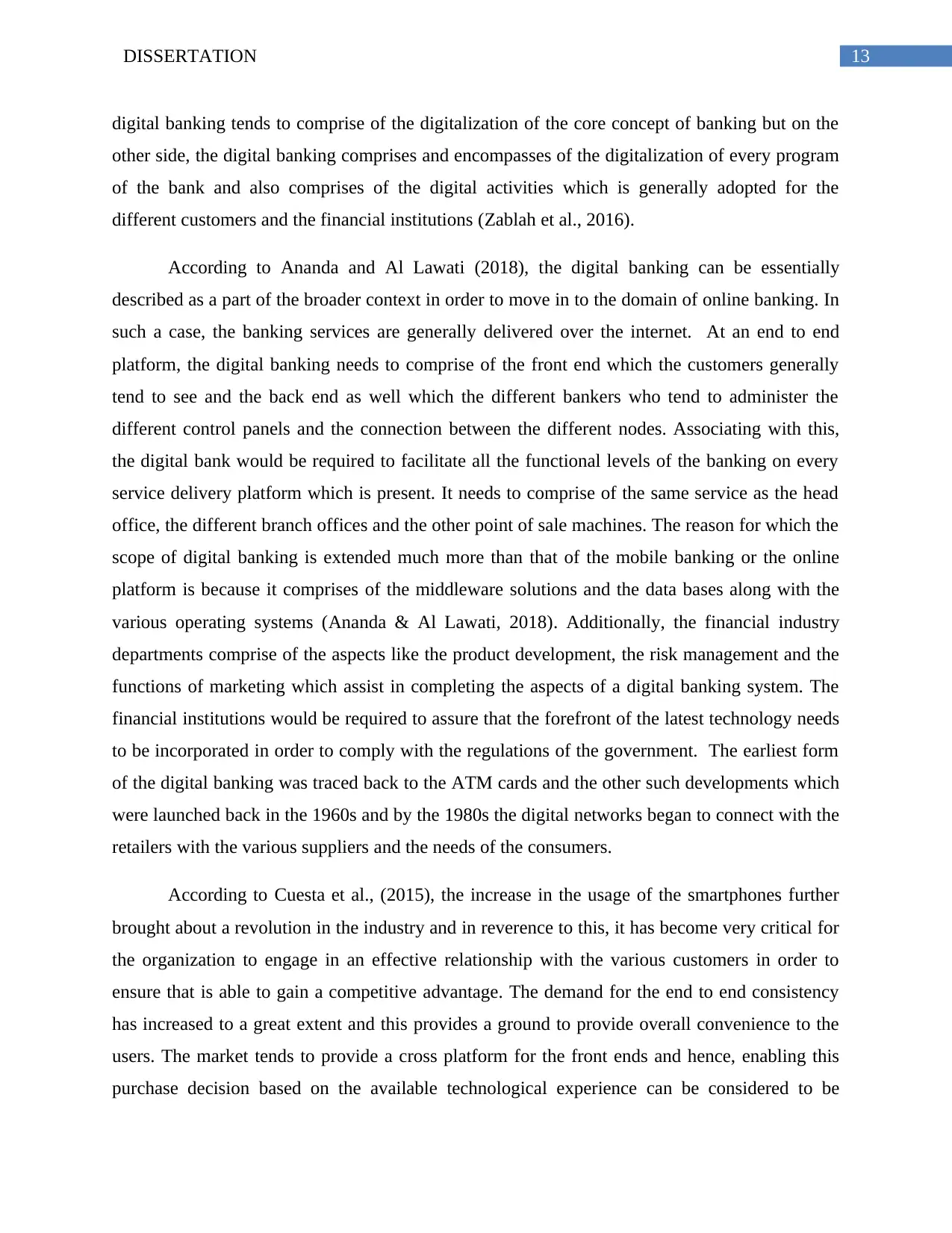
digital banking tends to comprise of the digitalization of the core concept of banking but on the
other side, the digital banking comprises and encompasses of the digitalization of every program
of the bank and also comprises of the digital activities which is generally adopted for the
different customers and the financial institutions (Zablah et al., 2016).
According to Ananda and Al Lawati (2018), the digital banking can be essentially
described as a part of the broader context in order to move in to the domain of online banking. In
such a case, the banking services are generally delivered over the internet. At an end to end
platform, the digital banking needs to comprise of the front end which the customers generally
tend to see and the back end as well which the different bankers who tend to administer the
different control panels and the connection between the different nodes. Associating with this,
the digital bank would be required to facilitate all the functional levels of the banking on every
service delivery platform which is present. It needs to comprise of the same service as the head
office, the different branch offices and the other point of sale machines. The reason for which the
scope of digital banking is extended much more than that of the mobile banking or the online
platform is because it comprises of the middleware solutions and the data bases along with the
various operating systems (Ananda & Al Lawati, 2018). Additionally, the financial industry
departments comprise of the aspects like the product development, the risk management and the
functions of marketing which assist in completing the aspects of a digital banking system. The
financial institutions would be required to assure that the forefront of the latest technology needs
to be incorporated in order to comply with the regulations of the government. The earliest form
of the digital banking was traced back to the ATM cards and the other such developments which
were launched back in the 1960s and by the 1980s the digital networks began to connect with the
retailers with the various suppliers and the needs of the consumers.
According to Cuesta et al., (2015), the increase in the usage of the smartphones further
brought about a revolution in the industry and in reverence to this, it has become very critical for
the organization to engage in an effective relationship with the various customers in order to
ensure that is able to gain a competitive advantage. The demand for the end to end consistency
has increased to a great extent and this provides a ground to provide overall convenience to the
users. The market tends to provide a cross platform for the front ends and hence, enabling this
purchase decision based on the available technological experience can be considered to be
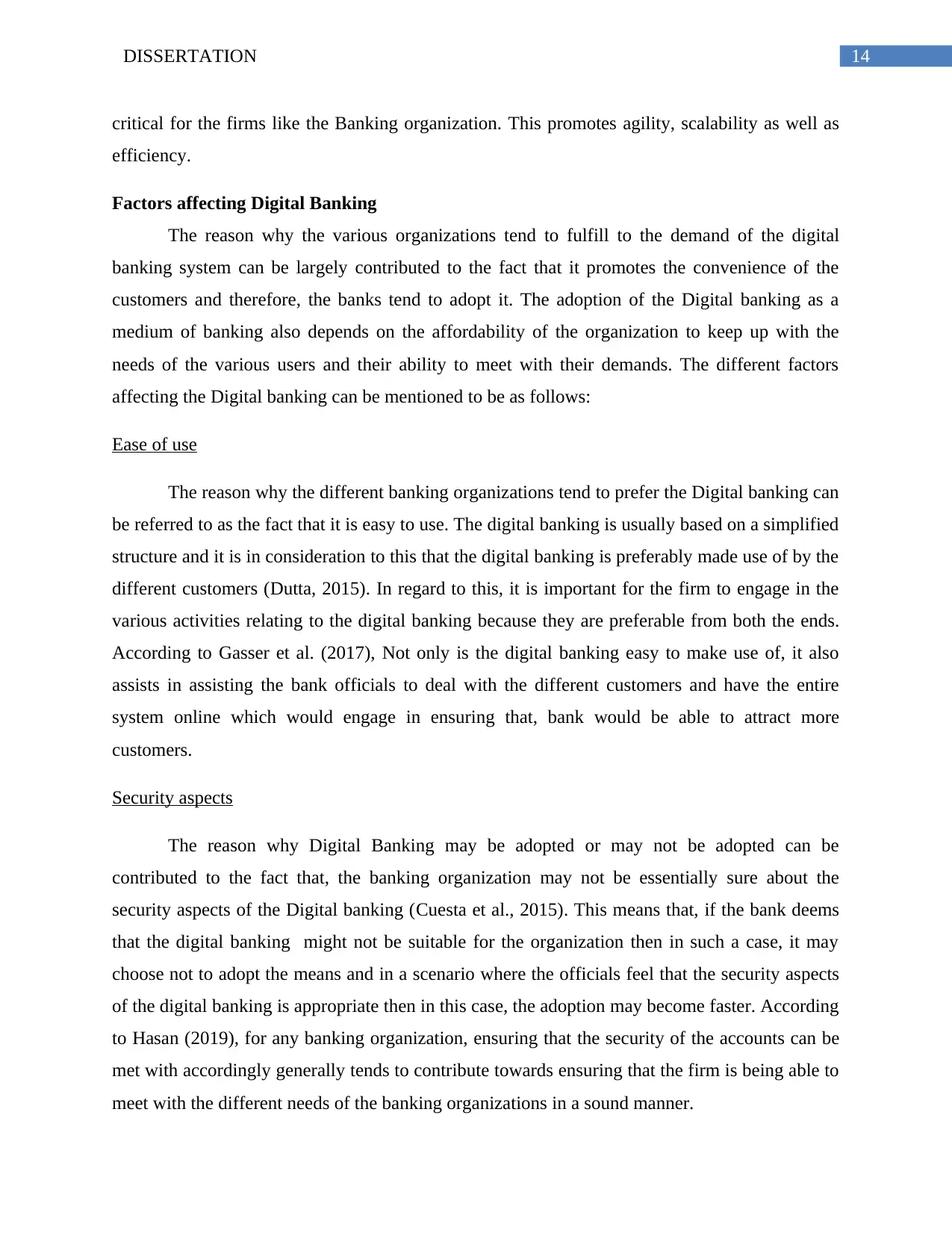
critical for the firms like the Banking organization. This promotes agility, scalability as well as
efficiency.
Factors affecting Digital Banking
The reason why the various organizations tend to fulfill to the demand of the digital
banking system can be largely contributed to the fact that it promotes the convenience of the
customers and therefore, the banks tend to adopt it. The adoption of the Digital banking as a
medium of banking also depends on the affordability of the organization to keep up with the
needs of the various users and their ability to meet with their demands. The different factors
affecting the Digital banking can be mentioned to be as follows:
Ease of use
The reason why the different banking organizations tend to prefer the Digital banking can
be referred to as the fact that it is easy to use. The digital banking is usually based on a simplified
structure and it is in consideration to this that the digital banking is preferably made use of by the
different customers (Dutta, 2015). In regard to this, it is important for the firm to engage in the
various activities relating to the digital banking because they are preferable from both the ends.
According to Gasser et al. (2017), Not only is the digital banking easy to make use of, it also
assists in assisting the bank officials to deal with the different customers and have the entire
system online which would engage in ensuring that, bank would be able to attract more
customers.
Security aspects
The reason why Digital Banking may be adopted or may not be adopted can be
contributed to the fact that, the banking organization may not be essentially sure about the
security aspects of the Digital banking (Cuesta et al., 2015). This means that, if the bank deems
that the digital banking might not be suitable for the organization then in such a case, it may
choose not to adopt the means and in a scenario where the officials feel that the security aspects
of the digital banking is appropriate then in this case, the adoption may become faster. According
to Hasan (2019), for any banking organization, ensuring that the security of the accounts can be
met with accordingly generally tends to contribute towards ensuring that the firm is being able to
meet with the different needs of the banking organizations in a sound manner.
⊘ This is a preview!⊘
Do you want full access?
Subscribe today to unlock all pages.

Trusted by 1+ million students worldwide
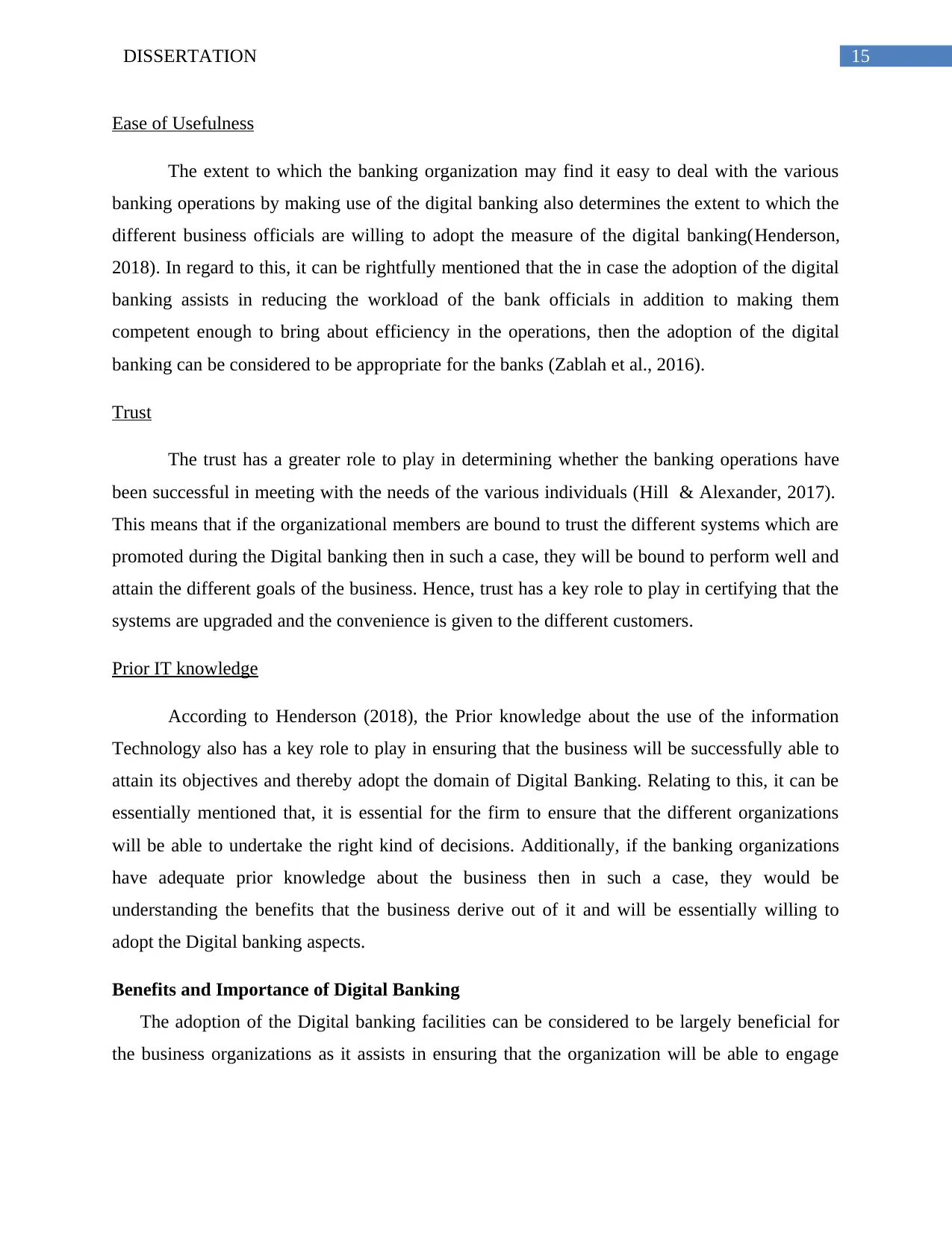
Ease of Usefulness
The extent to which the banking organization may find it easy to deal with the various
banking operations by making use of the digital banking also determines the extent to which the
different business officials are willing to adopt the measure of the digital banking(Henderson,
2018). In regard to this, it can be rightfully mentioned that the in case the adoption of the digital
banking assists in reducing the workload of the bank officials in addition to making them
competent enough to bring about efficiency in the operations, then the adoption of the digital
banking can be considered to be appropriate for the banks (Zablah et al., 2016).
Trust
The trust has a greater role to play in determining whether the banking operations have
been successful in meeting with the needs of the various individuals (Hill & Alexander, 2017).
This means that if the organizational members are bound to trust the different systems which are
promoted during the Digital banking then in such a case, they will be bound to perform well and
attain the different goals of the business. Hence, trust has a key role to play in certifying that the
systems are upgraded and the convenience is given to the different customers.
Prior IT knowledge
According to Henderson (2018), the Prior knowledge about the use of the information
Technology also has a key role to play in ensuring that the business will be successfully able to
attain its objectives and thereby adopt the domain of Digital Banking. Relating to this, it can be
essentially mentioned that, it is essential for the firm to ensure that the different organizations
will be able to undertake the right kind of decisions. Additionally, if the banking organizations
have adequate prior knowledge about the business then in such a case, they would be
understanding the benefits that the business derive out of it and will be essentially willing to
adopt the Digital banking aspects.
Benefits and Importance of Digital Banking
The adoption of the Digital banking facilities can be considered to be largely beneficial for
the business organizations as it assists in ensuring that the organization will be able to engage
Paraphrase This Document
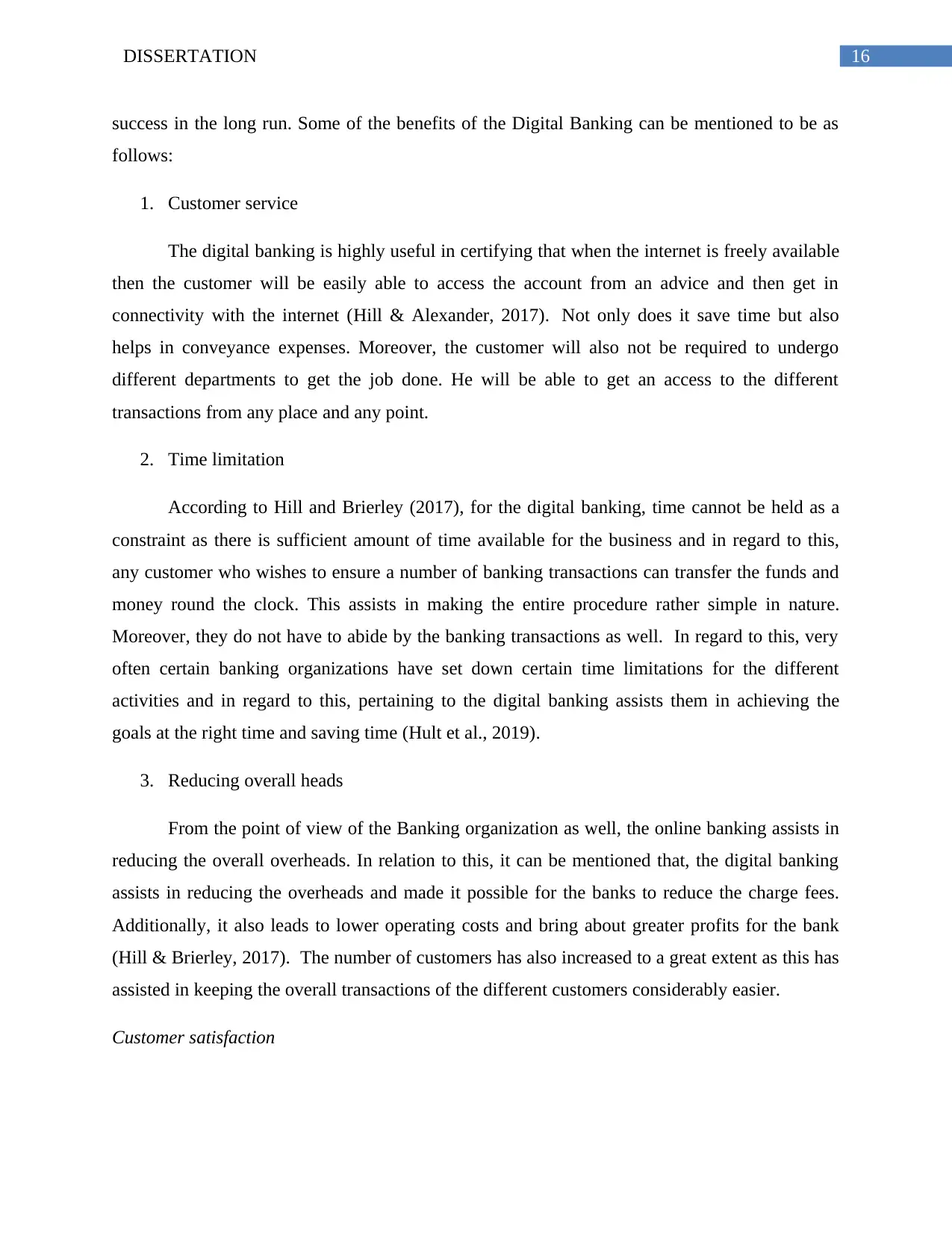
success in the long run. Some of the benefits of the Digital Banking can be mentioned to be as
follows:
1. Customer service
The digital banking is highly useful in certifying that when the internet is freely available
then the customer will be easily able to access the account from an advice and then get in
connectivity with the internet (Hill & Alexander, 2017). Not only does it save time but also
helps in conveyance expenses. Moreover, the customer will also not be required to undergo
different departments to get the job done. He will be able to get an access to the different
transactions from any place and any point.
2. Time limitation
According to Hill and Brierley (2017), for the digital banking, time cannot be held as a
constraint as there is sufficient amount of time available for the business and in regard to this,
any customer who wishes to ensure a number of banking transactions can transfer the funds and
money round the clock. This assists in making the entire procedure rather simple in nature.
Moreover, they do not have to abide by the banking transactions as well. In regard to this, very
often certain banking organizations have set down certain time limitations for the different
activities and in regard to this, pertaining to the digital banking assists them in achieving the
goals at the right time and saving time (Hult et al., 2019).
3. Reducing overall heads
From the point of view of the Banking organization as well, the online banking assists in
reducing the overall overheads. In relation to this, it can be mentioned that, the digital banking
assists in reducing the overheads and made it possible for the banks to reduce the charge fees.
Additionally, it also leads to lower operating costs and bring about greater profits for the bank
(Hill & Brierley, 2017). The number of customers has also increased to a great extent as this has
assisted in keeping the overall transactions of the different customers considerably easier.
Customer satisfaction
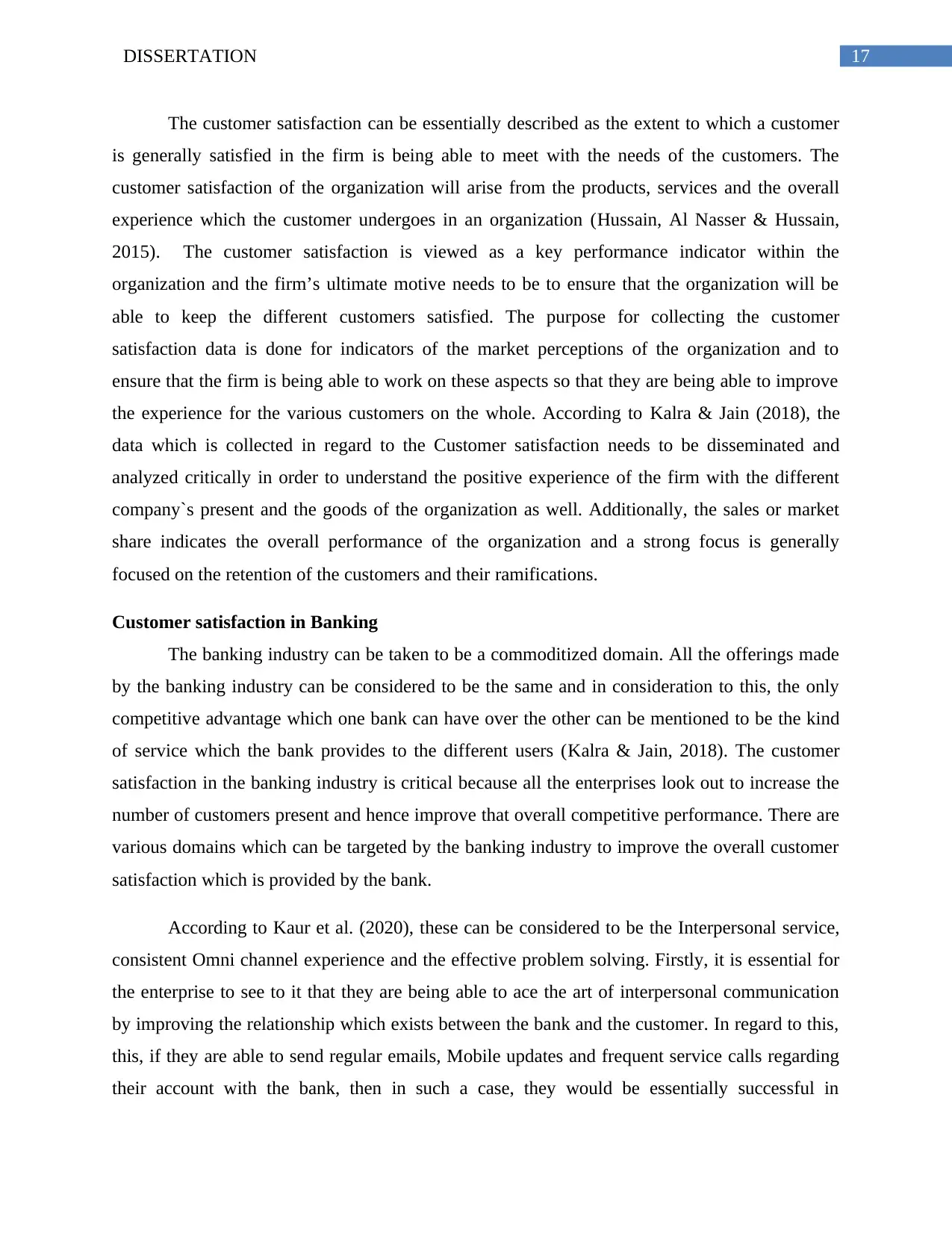
The customer satisfaction can be essentially described as the extent to which a customer
is generally satisfied in the firm is being able to meet with the needs of the customers. The
customer satisfaction of the organization will arise from the products, services and the overall
experience which the customer undergoes in an organization (Hussain, Al Nasser & Hussain,
2015). The customer satisfaction is viewed as a key performance indicator within the
organization and the firm’s ultimate motive needs to be to ensure that the organization will be
able to keep the different customers satisfied. The purpose for collecting the customer
satisfaction data is done for indicators of the market perceptions of the organization and to
ensure that the firm is being able to work on these aspects so that they are being able to improve
the experience for the various customers on the whole. According to Kalra & Jain (2018), the
data which is collected in regard to the Customer satisfaction needs to be disseminated and
analyzed critically in order to understand the positive experience of the firm with the different
company`s present and the goods of the organization as well. Additionally, the sales or market
share indicates the overall performance of the organization and a strong focus is generally
focused on the retention of the customers and their ramifications.
Customer satisfaction in Banking
The banking industry can be taken to be a commoditized domain. All the offerings made
by the banking industry can be considered to be the same and in consideration to this, the only
competitive advantage which one bank can have over the other can be mentioned to be the kind
of service which the bank provides to the different users (Kalra & Jain, 2018). The customer
satisfaction in the banking industry is critical because all the enterprises look out to increase the
number of customers present and hence improve that overall competitive performance. There are
various domains which can be targeted by the banking industry to improve the overall customer
satisfaction which is provided by the bank.
According to Kaur et al. (2020), these can be considered to be the Interpersonal service,
consistent Omni channel experience and the effective problem solving. Firstly, it is essential for
the enterprise to see to it that they are being able to ace the art of interpersonal communication
by improving the relationship which exists between the bank and the customer. In regard to this,
this, if they are able to send regular emails, Mobile updates and frequent service calls regarding
their account with the bank, then in such a case, they would be essentially successful in
⊘ This is a preview!⊘
Do you want full access?
Subscribe today to unlock all pages.

Trusted by 1+ million students worldwide
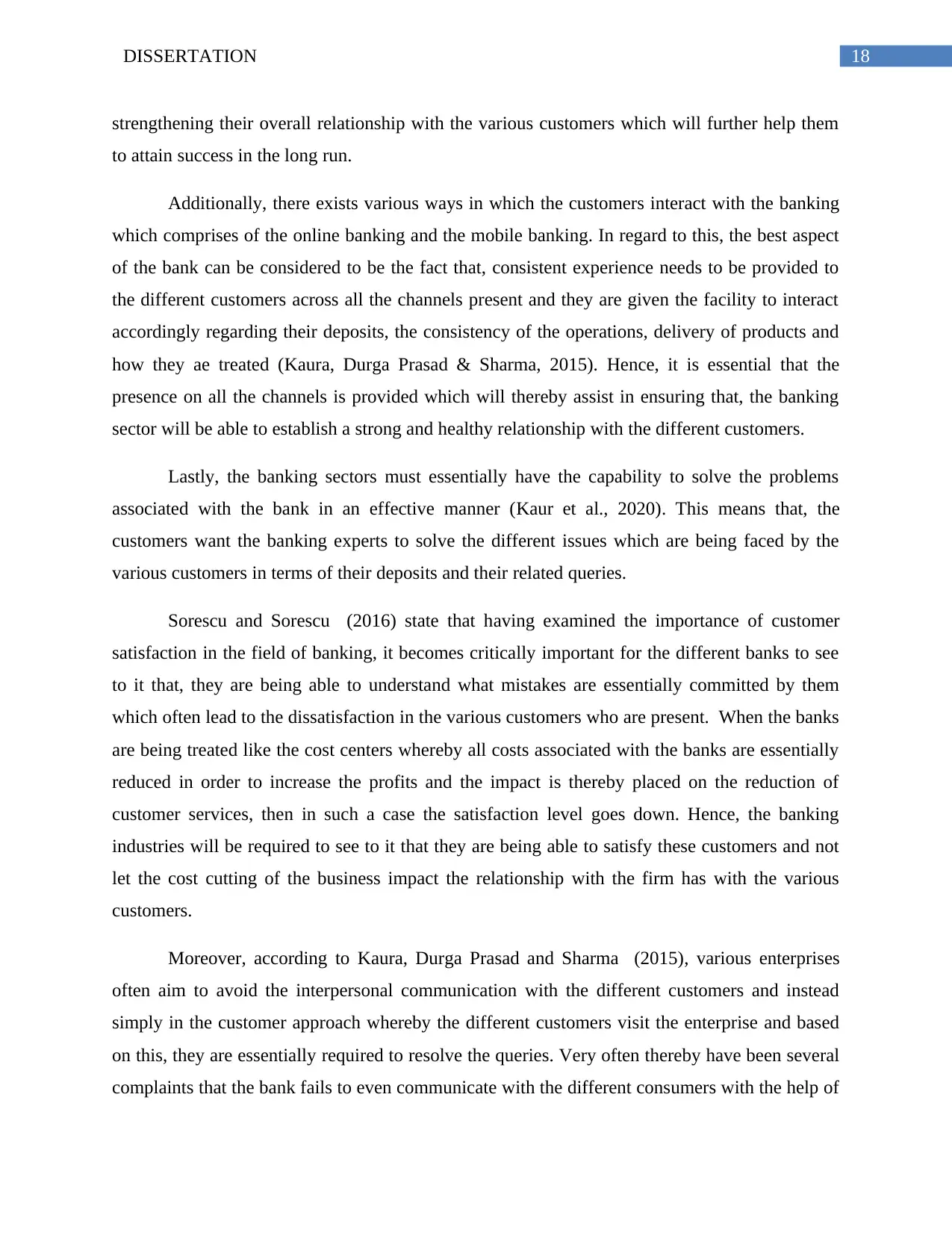
strengthening their overall relationship with the various customers which will further help them
to attain success in the long run.
Additionally, there exists various ways in which the customers interact with the banking
which comprises of the online banking and the mobile banking. In regard to this, the best aspect
of the bank can be considered to be the fact that, consistent experience needs to be provided to
the different customers across all the channels present and they are given the facility to interact
accordingly regarding their deposits, the consistency of the operations, delivery of products and
how they ae treated (Kaura, Durga Prasad & Sharma, 2015). Hence, it is essential that the
presence on all the channels is provided which will thereby assist in ensuring that, the banking
sector will be able to establish a strong and healthy relationship with the different customers.
Lastly, the banking sectors must essentially have the capability to solve the problems
associated with the bank in an effective manner (Kaur et al., 2020). This means that, the
customers want the banking experts to solve the different issues which are being faced by the
various customers in terms of their deposits and their related queries.
Sorescu and Sorescu (2016) state that having examined the importance of customer
satisfaction in the field of banking, it becomes critically important for the different banks to see
to it that, they are being able to understand what mistakes are essentially committed by them
which often lead to the dissatisfaction in the various customers who are present. When the banks
are being treated like the cost centers whereby all costs associated with the banks are essentially
reduced in order to increase the profits and the impact is thereby placed on the reduction of
customer services, then in such a case the satisfaction level goes down. Hence, the banking
industries will be required to see to it that they are being able to satisfy these customers and not
let the cost cutting of the business impact the relationship with the firm has with the various
customers.
Moreover, according to Kaura, Durga Prasad and Sharma (2015), various enterprises
often aim to avoid the interpersonal communication with the different customers and instead
simply in the customer approach whereby the different customers visit the enterprise and based
on this, they are essentially required to resolve the queries. Very often thereby have been several
complaints that the bank fails to even communicate with the different consumers with the help of
Paraphrase This Document
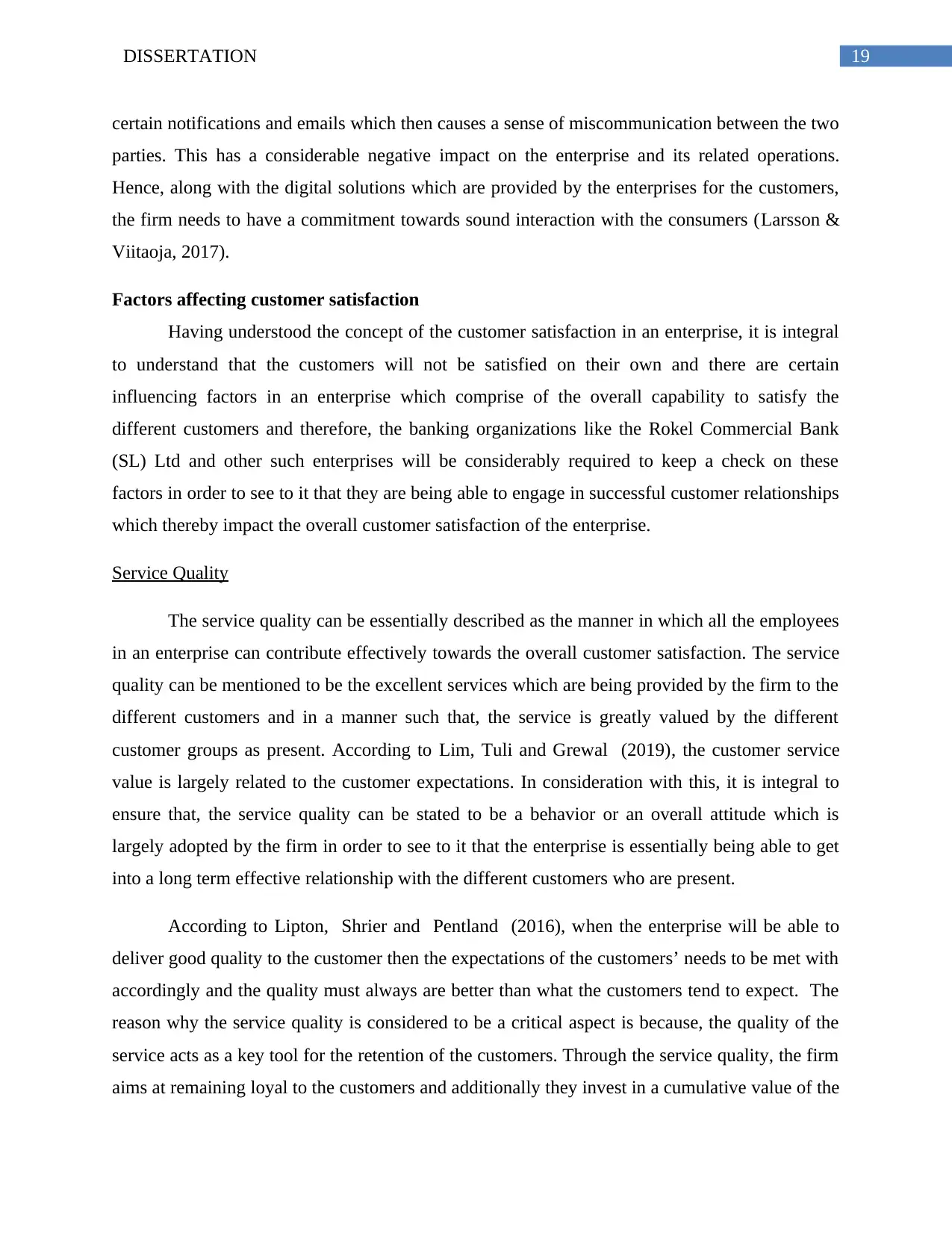
certain notifications and emails which then causes a sense of miscommunication between the two
parties. This has a considerable negative impact on the enterprise and its related operations.
Hence, along with the digital solutions which are provided by the enterprises for the customers,
the firm needs to have a commitment towards sound interaction with the consumers (Larsson &
Viitaoja, 2017).
Factors affecting customer satisfaction
Having understood the concept of the customer satisfaction in an enterprise, it is integral
to understand that the customers will not be satisfied on their own and there are certain
influencing factors in an enterprise which comprise of the overall capability to satisfy the
different customers and therefore, the banking organizations like the Rokel Commercial Bank
(SL) Ltd and other such enterprises will be considerably required to keep a check on these
factors in order to see to it that they are being able to engage in successful customer relationships
which thereby impact the overall customer satisfaction of the enterprise.
Service Quality
The service quality can be essentially described as the manner in which all the employees
in an enterprise can contribute effectively towards the overall customer satisfaction. The service
quality can be mentioned to be the excellent services which are being provided by the firm to the
different customers and in a manner such that, the service is greatly valued by the different
customer groups as present. According to Lim, Tuli and Grewal (2019), the customer service
value is largely related to the customer expectations. In consideration with this, it is integral to
ensure that, the service quality can be stated to be a behavior or an overall attitude which is
largely adopted by the firm in order to see to it that the enterprise is essentially being able to get
into a long term effective relationship with the different customers who are present.
According to Lipton, Shrier and Pentland (2016), when the enterprise will be able to
deliver good quality to the customer then the expectations of the customers’ needs to be met with
accordingly and the quality must always are better than what the customers tend to expect. The
reason why the service quality is considered to be a critical aspect is because, the quality of the
service acts as a key tool for the retention of the customers. Through the service quality, the firm
aims at remaining loyal to the customers and additionally they invest in a cumulative value of the
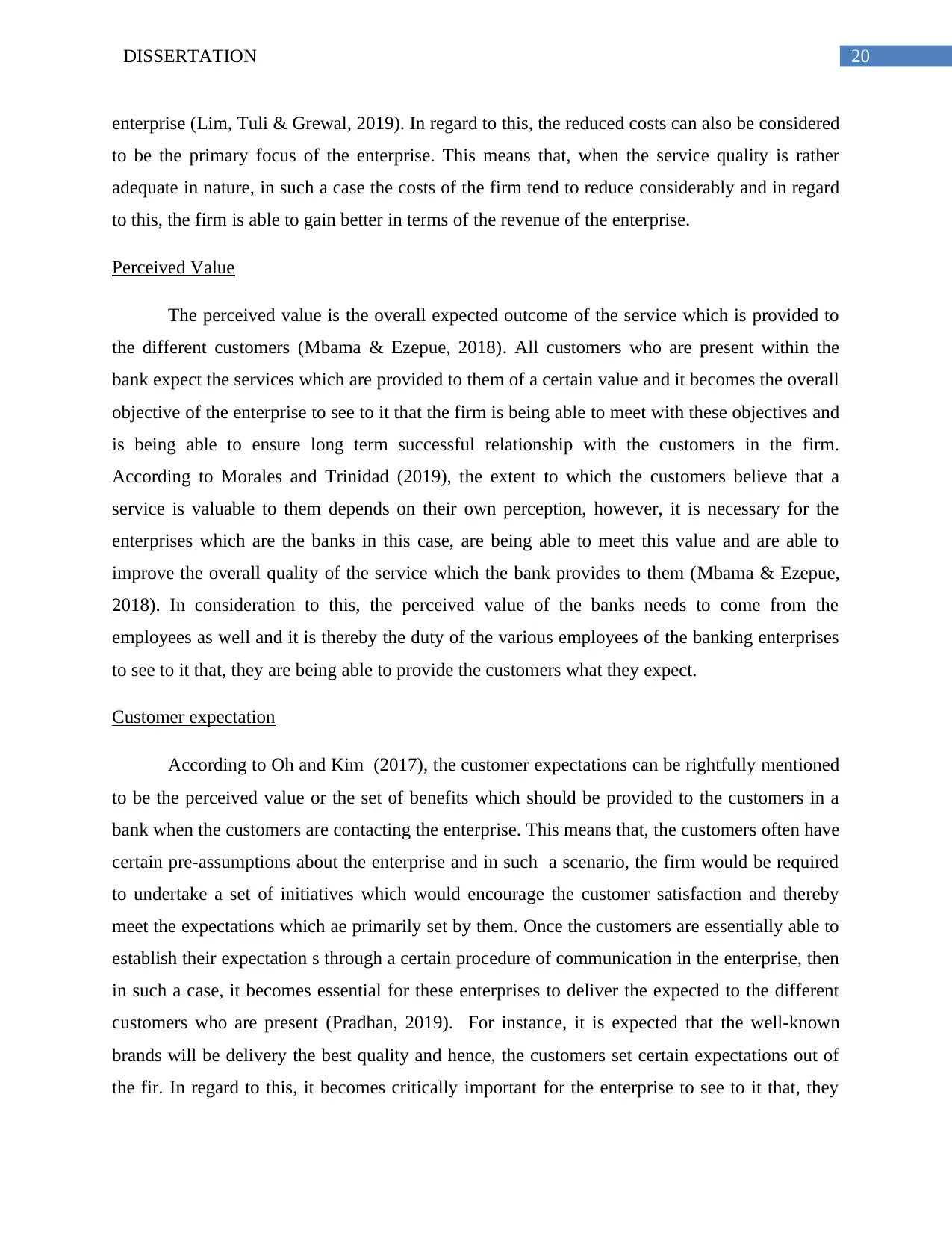
enterprise (Lim, Tuli & Grewal, 2019). In regard to this, the reduced costs can also be considered
to be the primary focus of the enterprise. This means that, when the service quality is rather
adequate in nature, in such a case the costs of the firm tend to reduce considerably and in regard
to this, the firm is able to gain better in terms of the revenue of the enterprise.
Perceived Value
The perceived value is the overall expected outcome of the service which is provided to
the different customers (Mbama & Ezepue, 2018). All customers who are present within the
bank expect the services which are provided to them of a certain value and it becomes the overall
objective of the enterprise to see to it that the firm is being able to meet with these objectives and
is being able to ensure long term successful relationship with the customers in the firm.
According to Morales and Trinidad (2019), the extent to which the customers believe that a
service is valuable to them depends on their own perception, however, it is necessary for the
enterprises which are the banks in this case, are being able to meet this value and are able to
improve the overall quality of the service which the bank provides to them (Mbama & Ezepue,
2018). In consideration to this, the perceived value of the banks needs to come from the
employees as well and it is thereby the duty of the various employees of the banking enterprises
to see to it that, they are being able to provide the customers what they expect.
Customer expectation
According to Oh and Kim (2017), the customer expectations can be rightfully mentioned
to be the perceived value or the set of benefits which should be provided to the customers in a
bank when the customers are contacting the enterprise. This means that, the customers often have
certain pre-assumptions about the enterprise and in such a scenario, the firm would be required
to undertake a set of initiatives which would encourage the customer satisfaction and thereby
meet the expectations which ae primarily set by them. Once the customers are essentially able to
establish their expectation s through a certain procedure of communication in the enterprise, then
in such a case, it becomes essential for these enterprises to deliver the expected to the different
customers who are present (Pradhan, 2019). For instance, it is expected that the well-known
brands will be delivery the best quality and hence, the customers set certain expectations out of
the fir. In regard to this, it becomes critically important for the enterprise to see to it that, they
⊘ This is a preview!⊘
Do you want full access?
Subscribe today to unlock all pages.

Trusted by 1+ million students worldwide
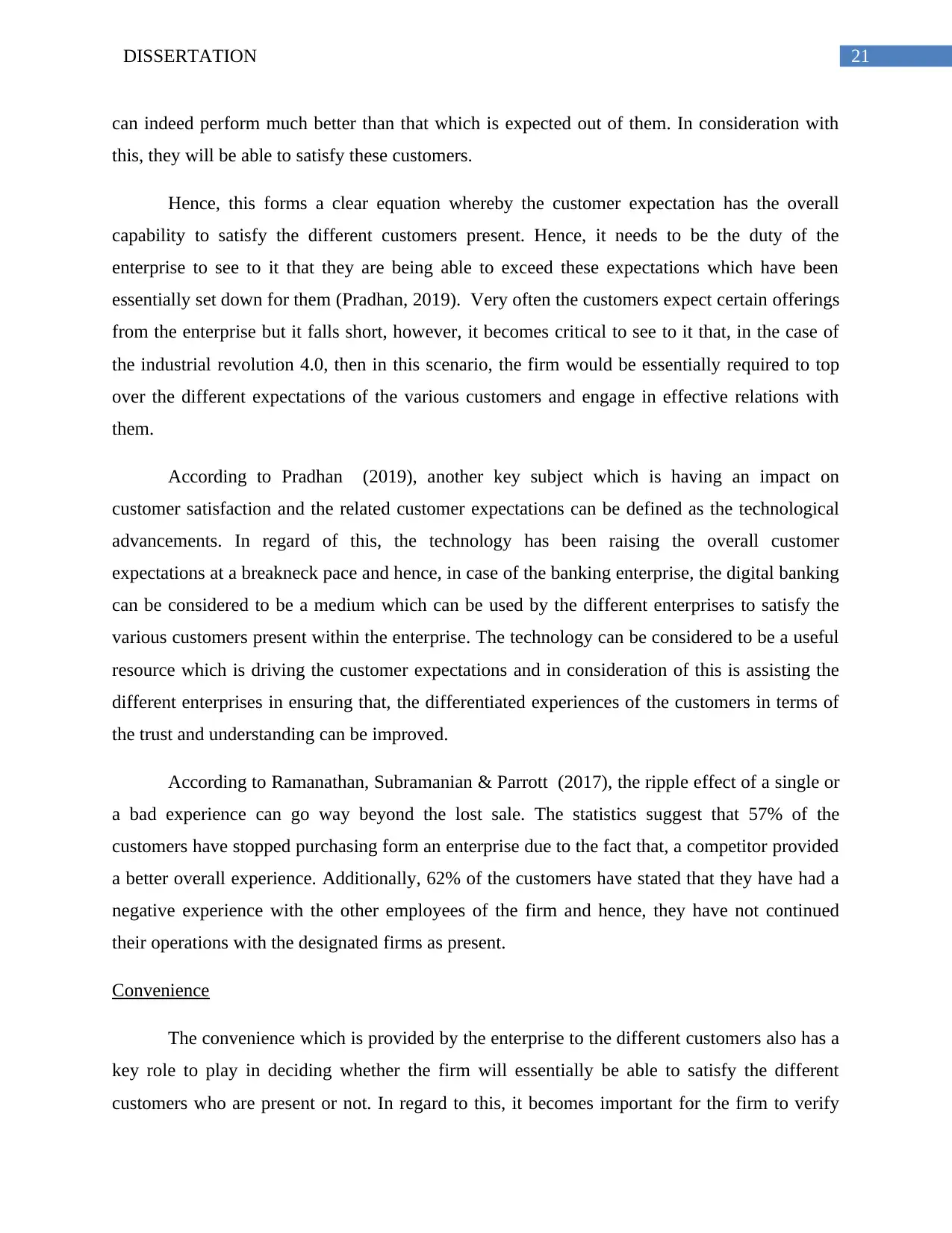
can indeed perform much better than that which is expected out of them. In consideration with
this, they will be able to satisfy these customers.
Hence, this forms a clear equation whereby the customer expectation has the overall
capability to satisfy the different customers present. Hence, it needs to be the duty of the
enterprise to see to it that they are being able to exceed these expectations which have been
essentially set down for them (Pradhan, 2019). Very often the customers expect certain offerings
from the enterprise but it falls short, however, it becomes critical to see to it that, in the case of
the industrial revolution 4.0, then in this scenario, the firm would be essentially required to top
over the different expectations of the various customers and engage in effective relations with
them.
According to Pradhan (2019), another key subject which is having an impact on
customer satisfaction and the related customer expectations can be defined as the technological
advancements. In regard of this, the technology has been raising the overall customer
expectations at a breakneck pace and hence, in case of the banking enterprise, the digital banking
can be considered to be a medium which can be used by the different enterprises to satisfy the
various customers present within the enterprise. The technology can be considered to be a useful
resource which is driving the customer expectations and in consideration of this is assisting the
different enterprises in ensuring that, the differentiated experiences of the customers in terms of
the trust and understanding can be improved.
According to Ramanathan, Subramanian & Parrott (2017), the ripple effect of a single or
a bad experience can go way beyond the lost sale. The statistics suggest that 57% of the
customers have stopped purchasing form an enterprise due to the fact that, a competitor provided
a better overall experience. Additionally, 62% of the customers have stated that they have had a
negative experience with the other employees of the firm and hence, they have not continued
their operations with the designated firms as present.
Convenience
The convenience which is provided by the enterprise to the different customers also has a
key role to play in deciding whether the firm will essentially be able to satisfy the different
customers who are present or not. In regard to this, it becomes important for the firm to verify
Paraphrase This Document
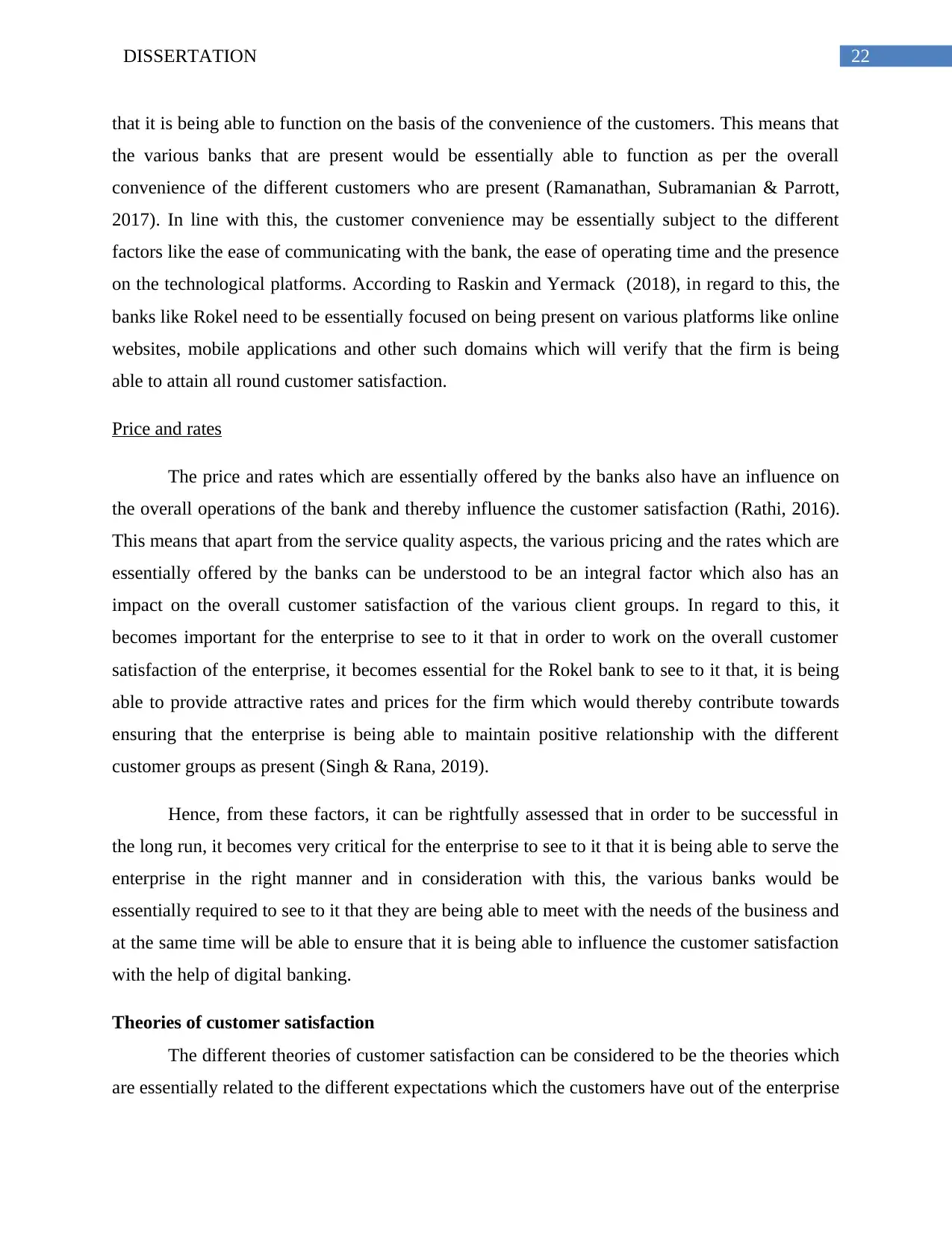
that it is being able to function on the basis of the convenience of the customers. This means that
the various banks that are present would be essentially able to function as per the overall
convenience of the different customers who are present (Ramanathan, Subramanian & Parrott,
2017). In line with this, the customer convenience may be essentially subject to the different
factors like the ease of communicating with the bank, the ease of operating time and the presence
on the technological platforms. According to Raskin and Yermack (2018), in regard to this, the
banks like Rokel need to be essentially focused on being present on various platforms like online
websites, mobile applications and other such domains which will verify that the firm is being
able to attain all round customer satisfaction.
Price and rates
The price and rates which are essentially offered by the banks also have an influence on
the overall operations of the bank and thereby influence the customer satisfaction (Rathi, 2016).
This means that apart from the service quality aspects, the various pricing and the rates which are
essentially offered by the banks can be understood to be an integral factor which also has an
impact on the overall customer satisfaction of the various client groups. In regard to this, it
becomes important for the enterprise to see to it that in order to work on the overall customer
satisfaction of the enterprise, it becomes essential for the Rokel bank to see to it that, it is being
able to provide attractive rates and prices for the firm which would thereby contribute towards
ensuring that the enterprise is being able to maintain positive relationship with the different
customer groups as present (Singh & Rana, 2019).
Hence, from these factors, it can be rightfully assessed that in order to be successful in
the long run, it becomes very critical for the enterprise to see to it that it is being able to serve the
enterprise in the right manner and in consideration with this, the various banks would be
essentially required to see to it that they are being able to meet with the needs of the business and
at the same time will be able to ensure that it is being able to influence the customer satisfaction
with the help of digital banking.
Theories of customer satisfaction
The different theories of customer satisfaction can be considered to be the theories which
are essentially related to the different expectations which the customers have out of the enterprise
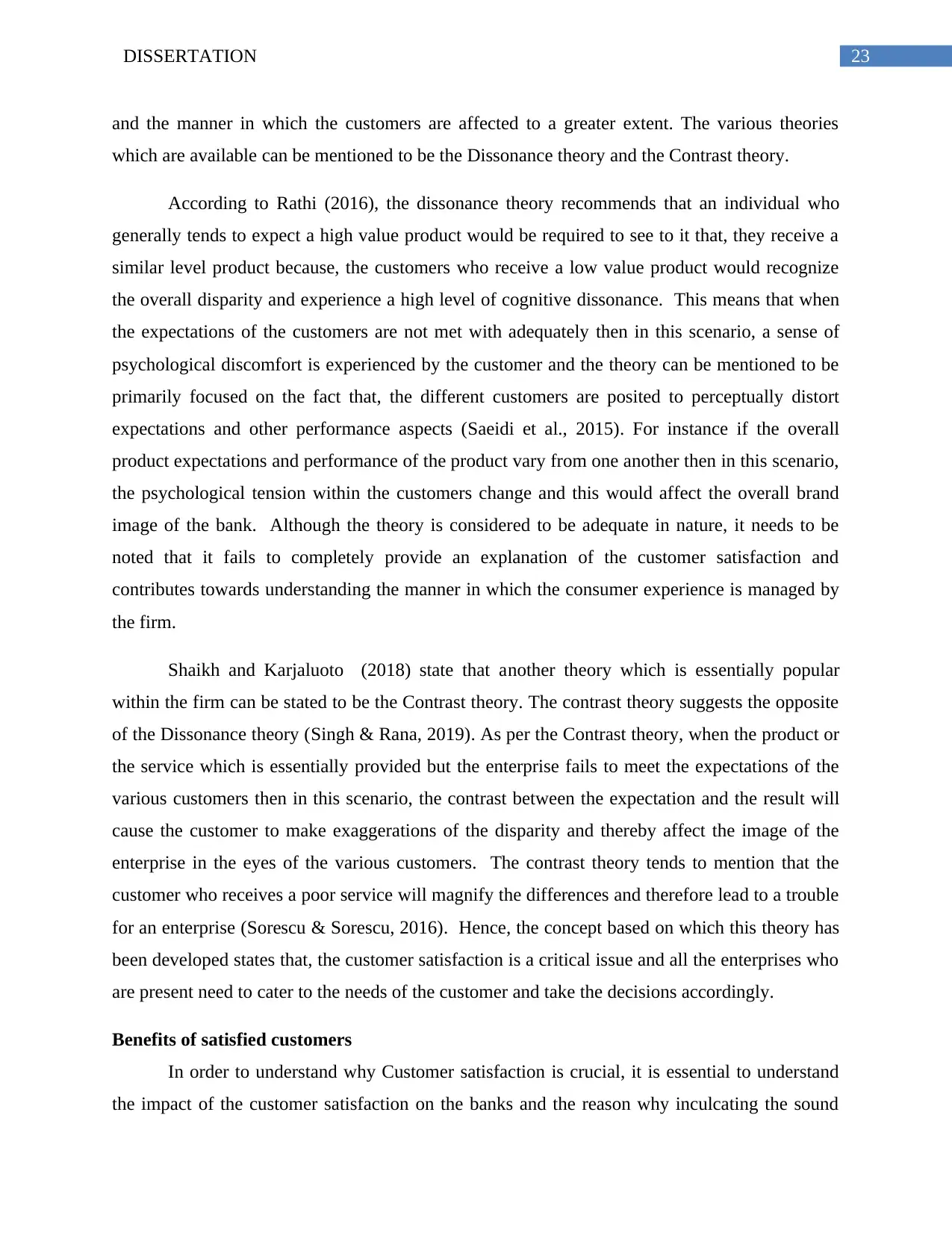
and the manner in which the customers are affected to a greater extent. The various theories
which are available can be mentioned to be the Dissonance theory and the Contrast theory.
According to Rathi (2016), the dissonance theory recommends that an individual who
generally tends to expect a high value product would be required to see to it that, they receive a
similar level product because, the customers who receive a low value product would recognize
the overall disparity and experience a high level of cognitive dissonance. This means that when
the expectations of the customers are not met with adequately then in this scenario, a sense of
psychological discomfort is experienced by the customer and the theory can be mentioned to be
primarily focused on the fact that, the different customers are posited to perceptually distort
expectations and other performance aspects (Saeidi et al., 2015). For instance if the overall
product expectations and performance of the product vary from one another then in this scenario,
the psychological tension within the customers change and this would affect the overall brand
image of the bank. Although the theory is considered to be adequate in nature, it needs to be
noted that it fails to completely provide an explanation of the customer satisfaction and
contributes towards understanding the manner in which the consumer experience is managed by
the firm.
Shaikh and Karjaluoto (2018) state that another theory which is essentially popular
within the firm can be stated to be the Contrast theory. The contrast theory suggests the opposite
of the Dissonance theory (Singh & Rana, 2019). As per the Contrast theory, when the product or
the service which is essentially provided but the enterprise fails to meet the expectations of the
various customers then in this scenario, the contrast between the expectation and the result will
cause the customer to make exaggerations of the disparity and thereby affect the image of the
enterprise in the eyes of the various customers. The contrast theory tends to mention that the
customer who receives a poor service will magnify the differences and therefore lead to a trouble
for an enterprise (Sorescu & Sorescu, 2016). Hence, the concept based on which this theory has
been developed states that, the customer satisfaction is a critical issue and all the enterprises who
are present need to cater to the needs of the customer and take the decisions accordingly.
Benefits of satisfied customers
In order to understand why Customer satisfaction is crucial, it is essential to understand
the impact of the customer satisfaction on the banks and the reason why inculcating the sound
⊘ This is a preview!⊘
Do you want full access?
Subscribe today to unlock all pages.

Trusted by 1+ million students worldwide
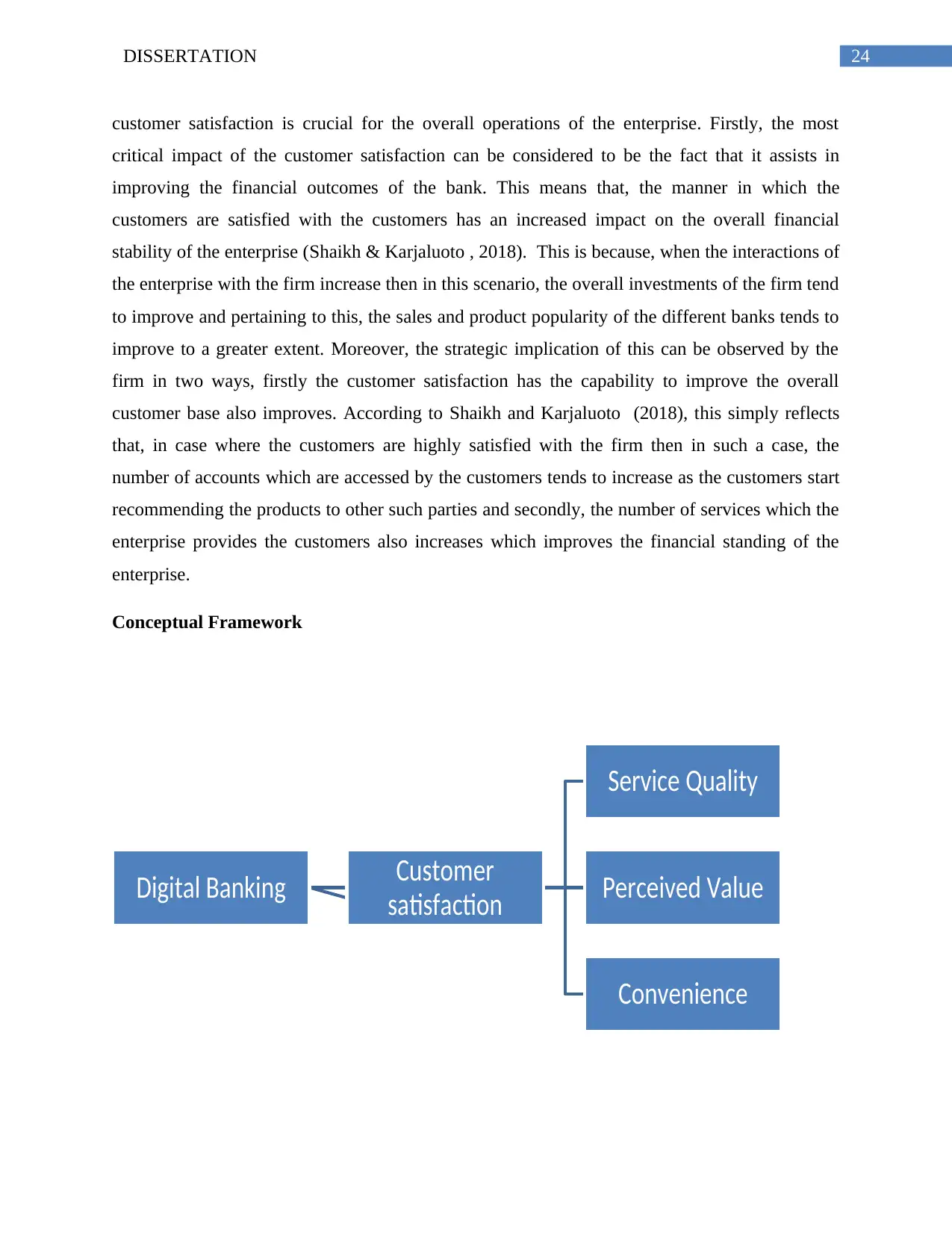
customer satisfaction is crucial for the overall operations of the enterprise. Firstly, the most
critical impact of the customer satisfaction can be considered to be the fact that it assists in
improving the financial outcomes of the bank. This means that, the manner in which the
customers are satisfied with the customers has an increased impact on the overall financial
stability of the enterprise (Shaikh & Karjaluoto , 2018). This is because, when the interactions of
the enterprise with the firm increase then in this scenario, the overall investments of the firm tend
to improve and pertaining to this, the sales and product popularity of the different banks tends to
improve to a greater extent. Moreover, the strategic implication of this can be observed by the
firm in two ways, firstly the customer satisfaction has the capability to improve the overall
customer base also improves. According to Shaikh and Karjaluoto (2018), this simply reflects
that, in case where the customers are highly satisfied with the firm then in such a case, the
number of accounts which are accessed by the customers tends to increase as the customers start
recommending the products to other such parties and secondly, the number of services which the
enterprise provides the customers also increases which improves the financial standing of the
enterprise.
Conceptual Framework
Digital Banking
Service Quality
Perceived Value
Convenience
Customer
satisfaction
Paraphrase This Document
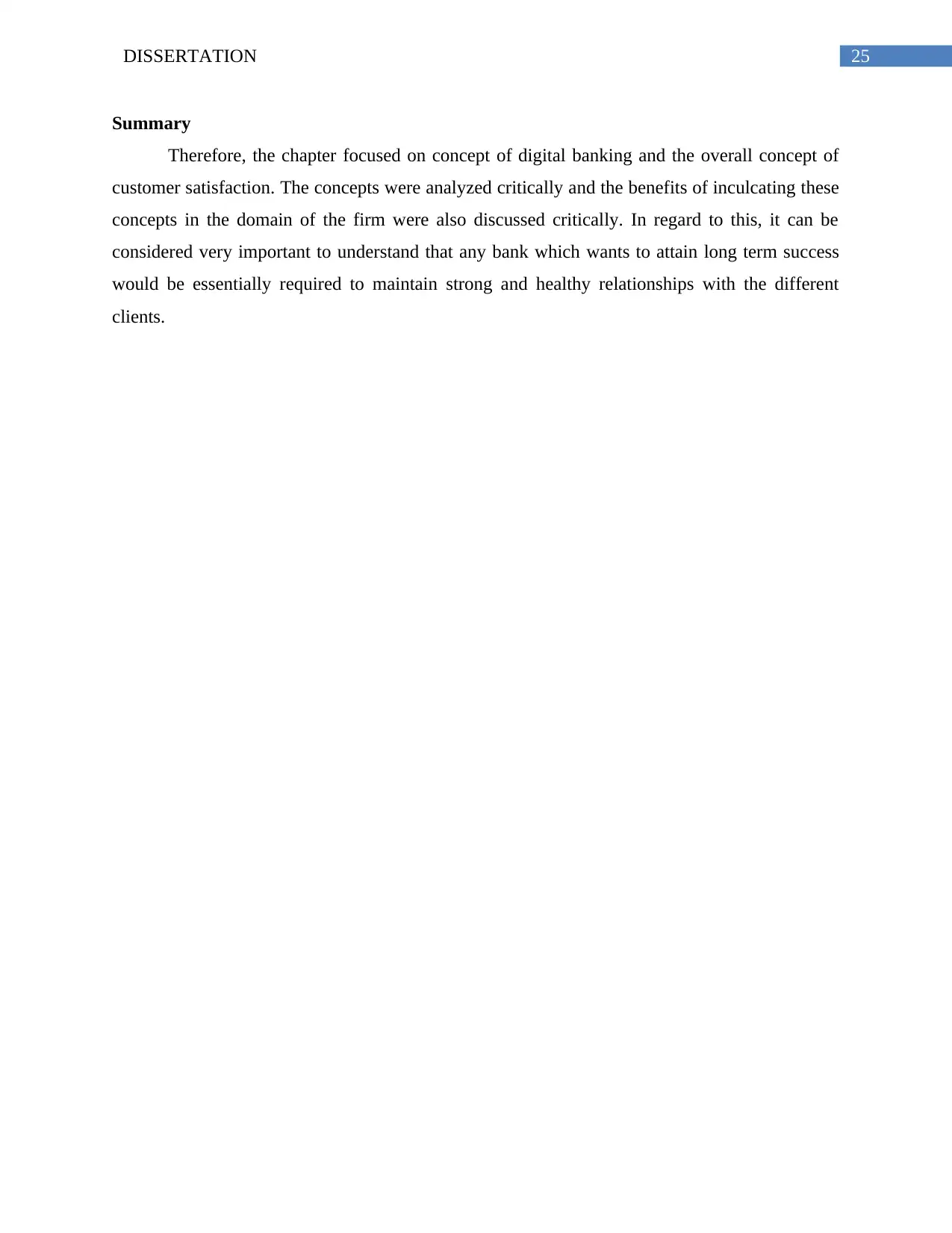
Summary
Therefore, the chapter focused on concept of digital banking and the overall concept of
customer satisfaction. The concepts were analyzed critically and the benefits of inculcating these
concepts in the domain of the firm were also discussed critically. In regard to this, it can be
considered very important to understand that any bank which wants to attain long term success
would be essentially required to maintain strong and healthy relationships with the different
clients.
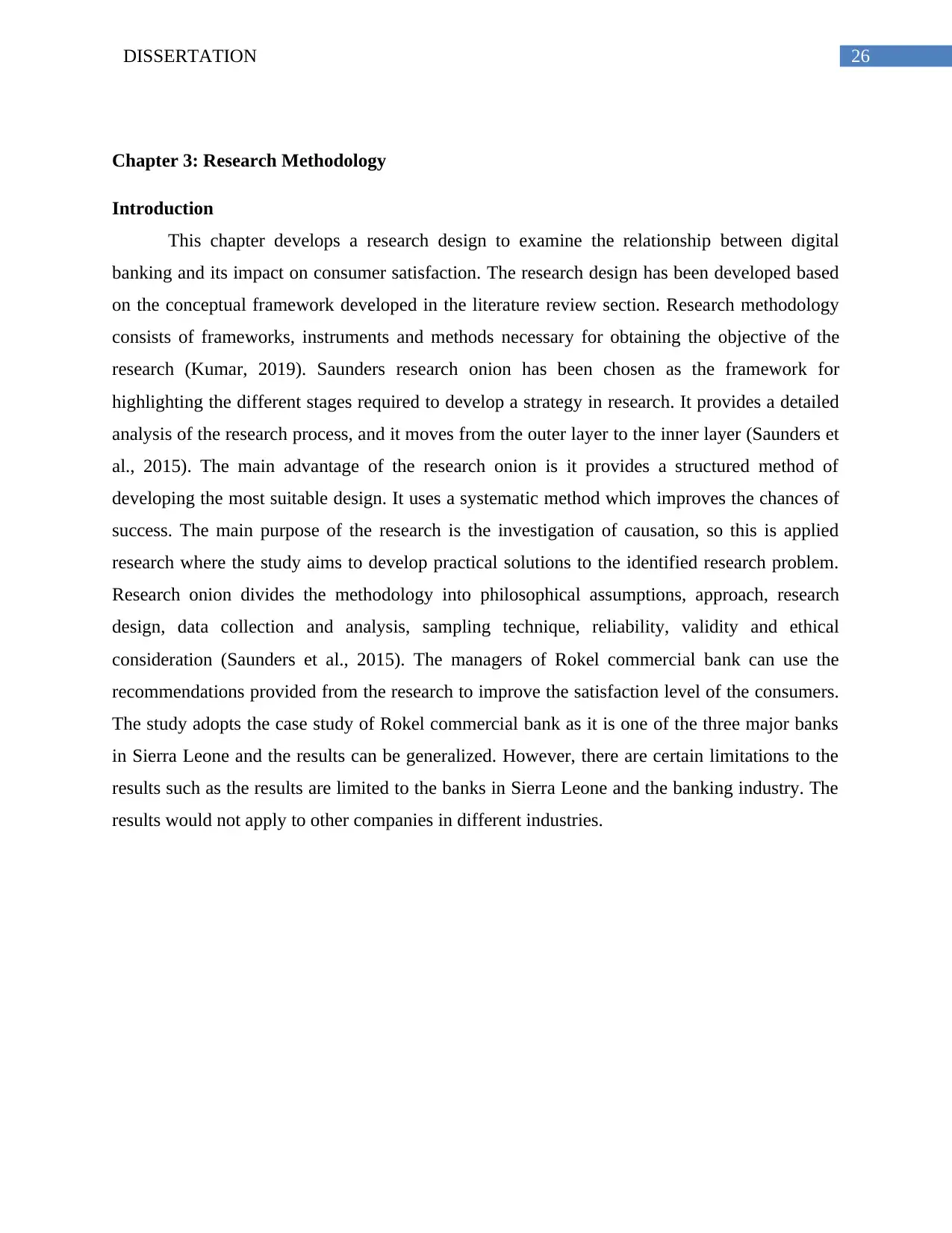
Chapter 3: Research Methodology
Introduction
This chapter develops a research design to examine the relationship between digital
banking and its impact on consumer satisfaction. The research design has been developed based
on the conceptual framework developed in the literature review section. Research methodology
consists of frameworks, instruments and methods necessary for obtaining the objective of the
research (Kumar, 2019). Saunders research onion has been chosen as the framework for
highlighting the different stages required to develop a strategy in research. It provides a detailed
analysis of the research process, and it moves from the outer layer to the inner layer (Saunders et
al., 2015). The main advantage of the research onion is it provides a structured method of
developing the most suitable design. It uses a systematic method which improves the chances of
success. The main purpose of the research is the investigation of causation, so this is applied
research where the study aims to develop practical solutions to the identified research problem.
Research onion divides the methodology into philosophical assumptions, approach, research
design, data collection and analysis, sampling technique, reliability, validity and ethical
consideration (Saunders et al., 2015). The managers of Rokel commercial bank can use the
recommendations provided from the research to improve the satisfaction level of the consumers.
The study adopts the case study of Rokel commercial bank as it is one of the three major banks
in Sierra Leone and the results can be generalized. However, there are certain limitations to the
results such as the results are limited to the banks in Sierra Leone and the banking industry. The
results would not apply to other companies in different industries.
⊘ This is a preview!⊘
Do you want full access?
Subscribe today to unlock all pages.

Trusted by 1+ million students worldwide
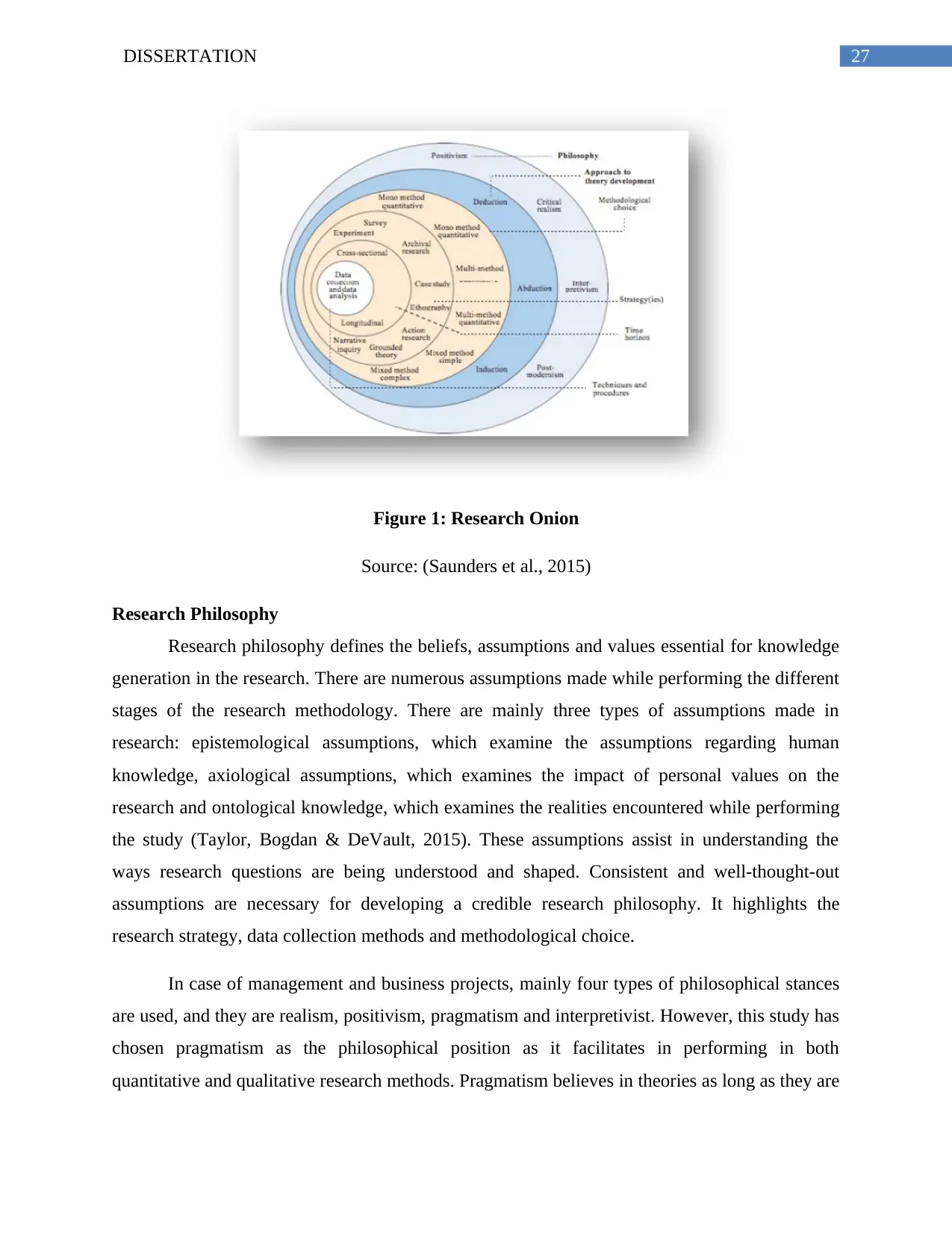
Figure 1: Research Onion
Source: (Saunders et al., 2015)
Research Philosophy
Research philosophy defines the beliefs, assumptions and values essential for knowledge
generation in the research. There are numerous assumptions made while performing the different
stages of the research methodology. There are mainly three types of assumptions made in
research: epistemological assumptions, which examine the assumptions regarding human
knowledge, axiological assumptions, which examines the impact of personal values on the
research and ontological knowledge, which examines the realities encountered while performing
the study (Taylor, Bogdan & DeVault, 2015). These assumptions assist in understanding the
ways research questions are being understood and shaped. Consistent and well-thought-out
assumptions are necessary for developing a credible research philosophy. It highlights the
research strategy, data collection methods and methodological choice.
In case of management and business projects, mainly four types of philosophical stances
are used, and they are realism, positivism, pragmatism and interpretivist. However, this study has
chosen pragmatism as the philosophical position as it facilitates in performing in both
quantitative and qualitative research methods. Pragmatism believes in theories as long as they are
Paraphrase This Document
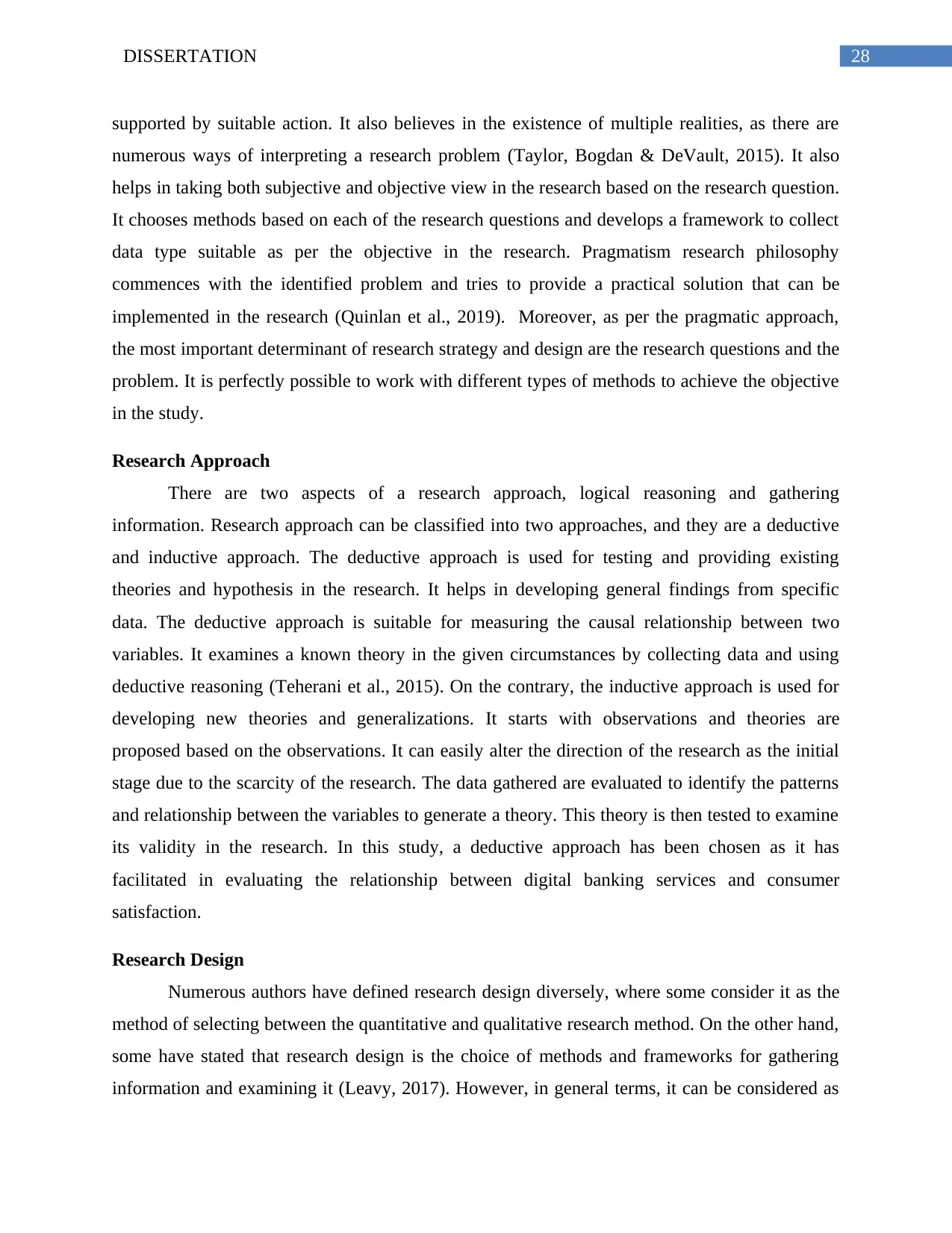
supported by suitable action. It also believes in the existence of multiple realities, as there are
numerous ways of interpreting a research problem (Taylor, Bogdan & DeVault, 2015). It also
helps in taking both subjective and objective view in the research based on the research question.
It chooses methods based on each of the research questions and develops a framework to collect
data type suitable as per the objective in the research. Pragmatism research philosophy
commences with the identified problem and tries to provide a practical solution that can be
implemented in the research (Quinlan et al., 2019). Moreover, as per the pragmatic approach,
the most important determinant of research strategy and design are the research questions and the
problem. It is perfectly possible to work with different types of methods to achieve the objective
in the study.
Research Approach
There are two aspects of a research approach, logical reasoning and gathering
information. Research approach can be classified into two approaches, and they are a deductive
and inductive approach. The deductive approach is used for testing and providing existing
theories and hypothesis in the research. It helps in developing general findings from specific
data. The deductive approach is suitable for measuring the causal relationship between two
variables. It examines a known theory in the given circumstances by collecting data and using
deductive reasoning (Teherani et al., 2015). On the contrary, the inductive approach is used for
developing new theories and generalizations. It starts with observations and theories are
proposed based on the observations. It can easily alter the direction of the research as the initial
stage due to the scarcity of the research. The data gathered are evaluated to identify the patterns
and relationship between the variables to generate a theory. This theory is then tested to examine
its validity in the research. In this study, a deductive approach has been chosen as it has
facilitated in evaluating the relationship between digital banking services and consumer
satisfaction.
Research Design
Numerous authors have defined research design diversely, where some consider it as the
method of selecting between the quantitative and qualitative research method. On the other hand,
some have stated that research design is the choice of methods and frameworks for gathering
information and examining it (Leavy, 2017). However, in general terms, it can be considered as
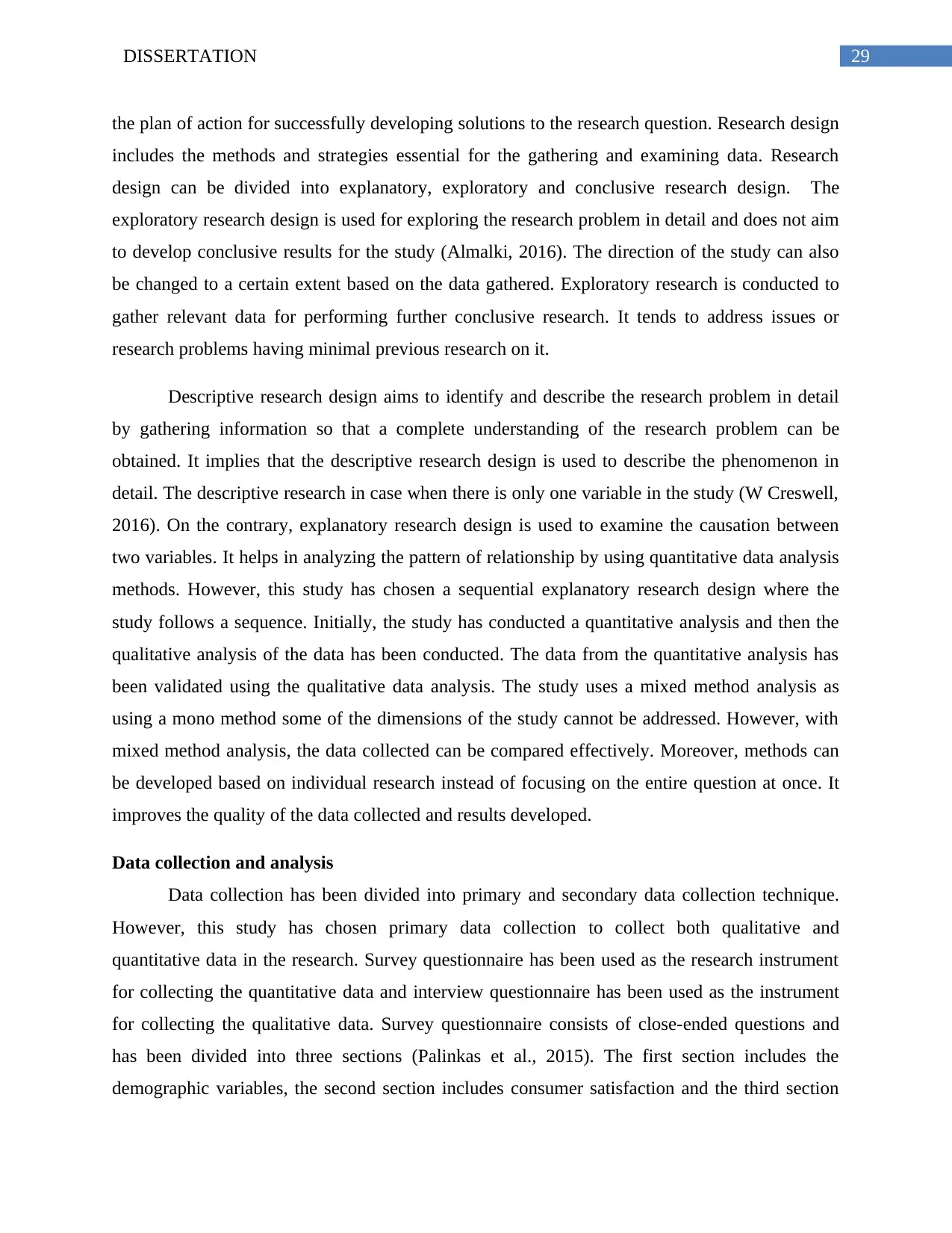
the plan of action for successfully developing solutions to the research question. Research design
includes the methods and strategies essential for the gathering and examining data. Research
design can be divided into explanatory, exploratory and conclusive research design. The
exploratory research design is used for exploring the research problem in detail and does not aim
to develop conclusive results for the study (Almalki, 2016). The direction of the study can also
be changed to a certain extent based on the data gathered. Exploratory research is conducted to
gather relevant data for performing further conclusive research. It tends to address issues or
research problems having minimal previous research on it.
Descriptive research design aims to identify and describe the research problem in detail
by gathering information so that a complete understanding of the research problem can be
obtained. It implies that the descriptive research design is used to describe the phenomenon in
detail. The descriptive research in case when there is only one variable in the study (W Creswell,
2016). On the contrary, explanatory research design is used to examine the causation between
two variables. It helps in analyzing the pattern of relationship by using quantitative data analysis
methods. However, this study has chosen a sequential explanatory research design where the
study follows a sequence. Initially, the study has conducted a quantitative analysis and then the
qualitative analysis of the data has been conducted. The data from the quantitative analysis has
been validated using the qualitative data analysis. The study uses a mixed method analysis as
using a mono method some of the dimensions of the study cannot be addressed. However, with
mixed method analysis, the data collected can be compared effectively. Moreover, methods can
be developed based on individual research instead of focusing on the entire question at once. It
improves the quality of the data collected and results developed.
Data collection and analysis
Data collection has been divided into primary and secondary data collection technique.
However, this study has chosen primary data collection to collect both qualitative and
quantitative data in the research. Survey questionnaire has been used as the research instrument
for collecting the quantitative data and interview questionnaire has been used as the instrument
for collecting the qualitative data. Survey questionnaire consists of close-ended questions and
has been divided into three sections (Palinkas et al., 2015). The first section includes the
demographic variables, the second section includes consumer satisfaction and the third section
⊘ This is a preview!⊘
Do you want full access?
Subscribe today to unlock all pages.

Trusted by 1+ million students worldwide
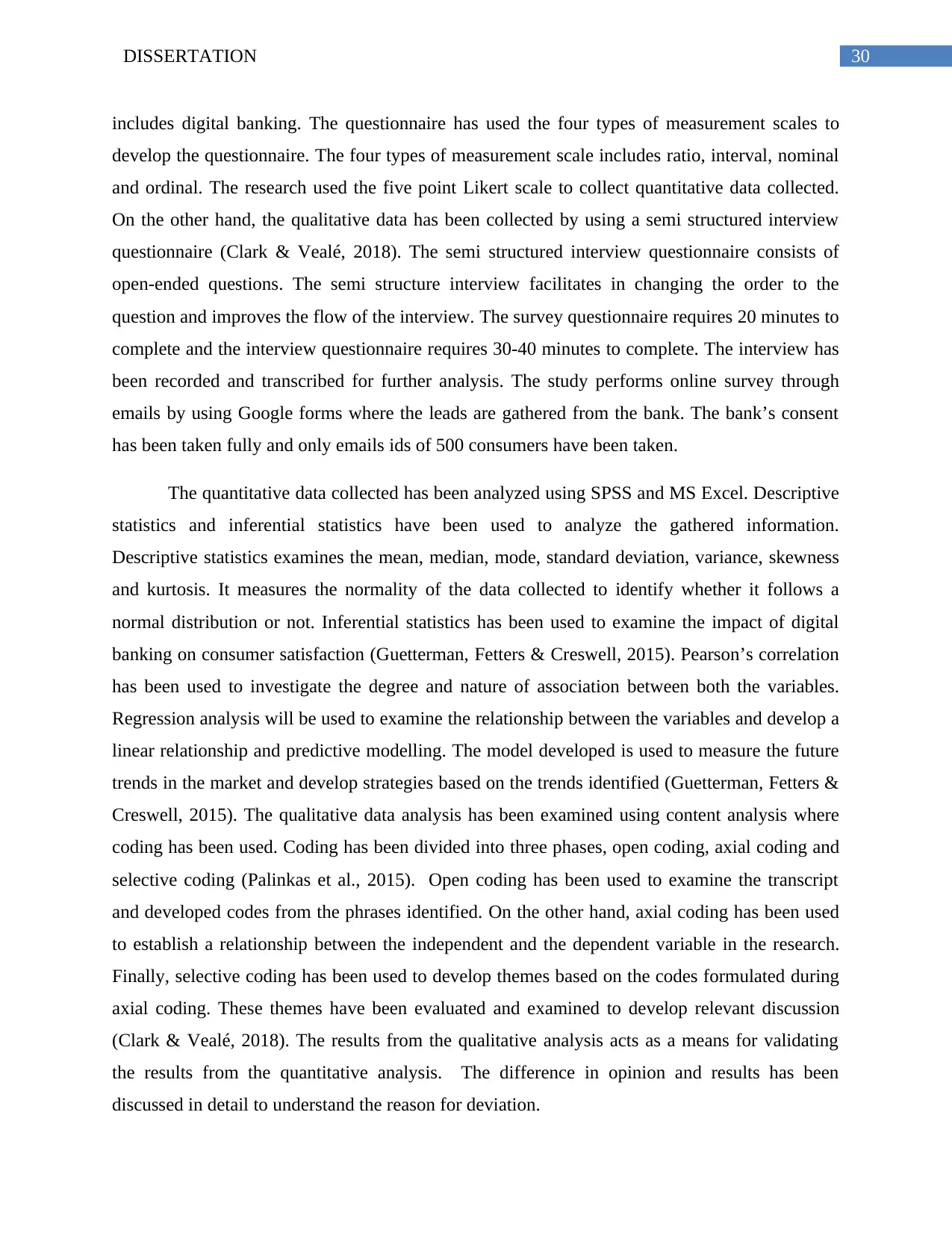
includes digital banking. The questionnaire has used the four types of measurement scales to
develop the questionnaire. The four types of measurement scale includes ratio, interval, nominal
and ordinal. The research used the five point Likert scale to collect quantitative data collected.
On the other hand, the qualitative data has been collected by using a semi structured interview
questionnaire (Clark & Vealé, 2018). The semi structured interview questionnaire consists of
open-ended questions. The semi structure interview facilitates in changing the order to the
question and improves the flow of the interview. The survey questionnaire requires 20 minutes to
complete and the interview questionnaire requires 30-40 minutes to complete. The interview has
been recorded and transcribed for further analysis. The study performs online survey through
emails by using Google forms where the leads are gathered from the bank. The bank’s consent
has been taken fully and only emails ids of 500 consumers have been taken.
The quantitative data collected has been analyzed using SPSS and MS Excel. Descriptive
statistics and inferential statistics have been used to analyze the gathered information.
Descriptive statistics examines the mean, median, mode, standard deviation, variance, skewness
and kurtosis. It measures the normality of the data collected to identify whether it follows a
normal distribution or not. Inferential statistics has been used to examine the impact of digital
banking on consumer satisfaction (Guetterman, Fetters & Creswell, 2015). Pearson’s correlation
has been used to investigate the degree and nature of association between both the variables.
Regression analysis will be used to examine the relationship between the variables and develop a
linear relationship and predictive modelling. The model developed is used to measure the future
trends in the market and develop strategies based on the trends identified (Guetterman, Fetters &
Creswell, 2015). The qualitative data analysis has been examined using content analysis where
coding has been used. Coding has been divided into three phases, open coding, axial coding and
selective coding (Palinkas et al., 2015). Open coding has been used to examine the transcript
and developed codes from the phrases identified. On the other hand, axial coding has been used
to establish a relationship between the independent and the dependent variable in the research.
Finally, selective coding has been used to develop themes based on the codes formulated during
axial coding. These themes have been evaluated and examined to develop relevant discussion
(Clark & Vealé, 2018). The results from the qualitative analysis acts as a means for validating
the results from the quantitative analysis. The difference in opinion and results has been
discussed in detail to understand the reason for deviation.
Paraphrase This Document
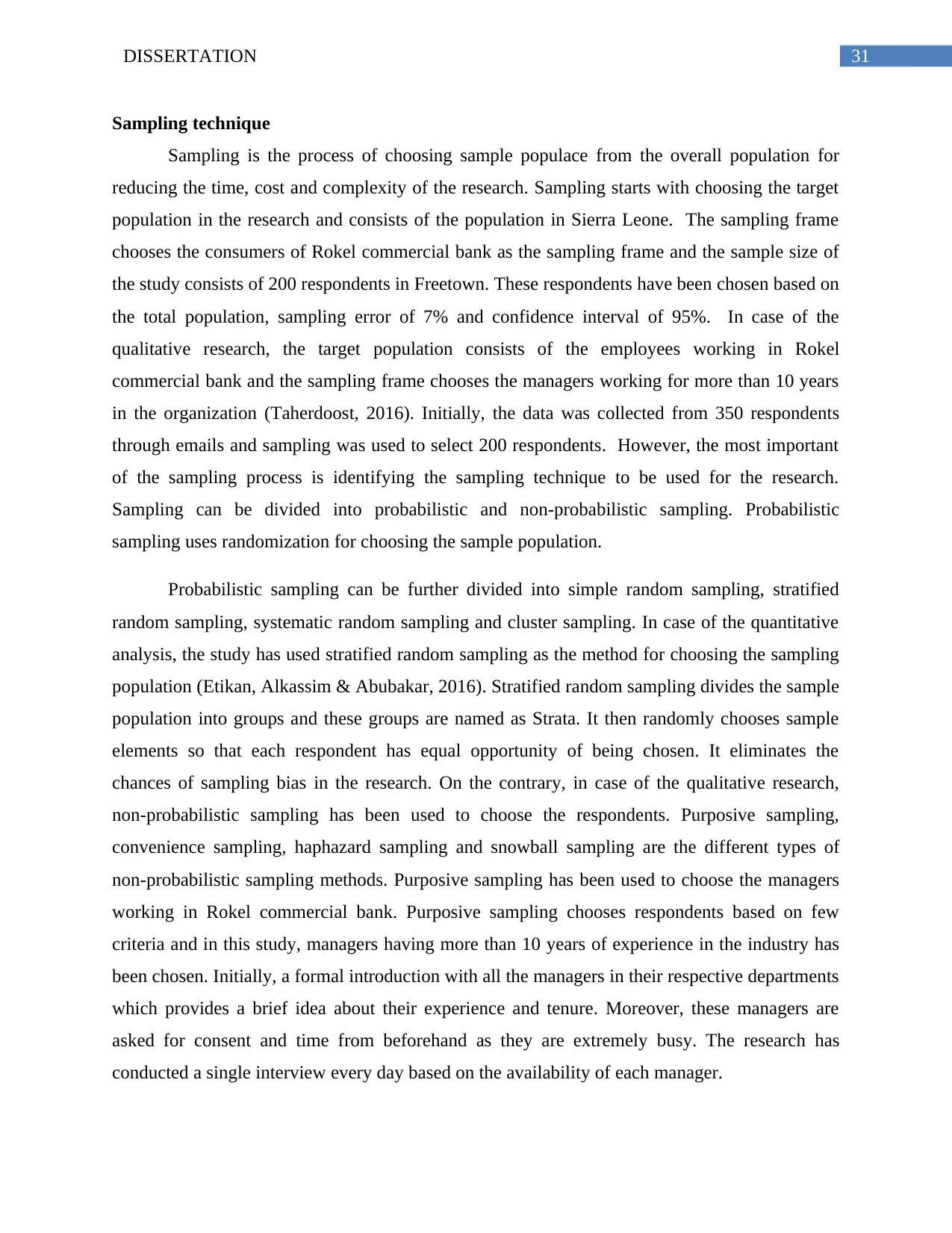
Sampling technique
Sampling is the process of choosing sample populace from the overall population for
reducing the time, cost and complexity of the research. Sampling starts with choosing the target
population in the research and consists of the population in Sierra Leone. The sampling frame
chooses the consumers of Rokel commercial bank as the sampling frame and the sample size of
the study consists of 200 respondents in Freetown. These respondents have been chosen based on
the total population, sampling error of 7% and confidence interval of 95%. In case of the
qualitative research, the target population consists of the employees working in Rokel
commercial bank and the sampling frame chooses the managers working for more than 10 years
in the organization (Taherdoost, 2016). Initially, the data was collected from 350 respondents
through emails and sampling was used to select 200 respondents. However, the most important
of the sampling process is identifying the sampling technique to be used for the research.
Sampling can be divided into probabilistic and non-probabilistic sampling. Probabilistic
sampling uses randomization for choosing the sample population.
Probabilistic sampling can be further divided into simple random sampling, stratified
random sampling, systematic random sampling and cluster sampling. In case of the quantitative
analysis, the study has used stratified random sampling as the method for choosing the sampling
population (Etikan, Alkassim & Abubakar, 2016). Stratified random sampling divides the sample
population into groups and these groups are named as Strata. It then randomly chooses sample
elements so that each respondent has equal opportunity of being chosen. It eliminates the
chances of sampling bias in the research. On the contrary, in case of the qualitative research,
non-probabilistic sampling has been used to choose the respondents. Purposive sampling,
convenience sampling, haphazard sampling and snowball sampling are the different types of
non-probabilistic sampling methods. Purposive sampling has been used to choose the managers
working in Rokel commercial bank. Purposive sampling chooses respondents based on few
criteria and in this study, managers having more than 10 years of experience in the industry has
been chosen. Initially, a formal introduction with all the managers in their respective departments
which provides a brief idea about their experience and tenure. Moreover, these managers are
asked for consent and time from beforehand as they are extremely busy. The research has
conducted a single interview every day based on the availability of each manager.
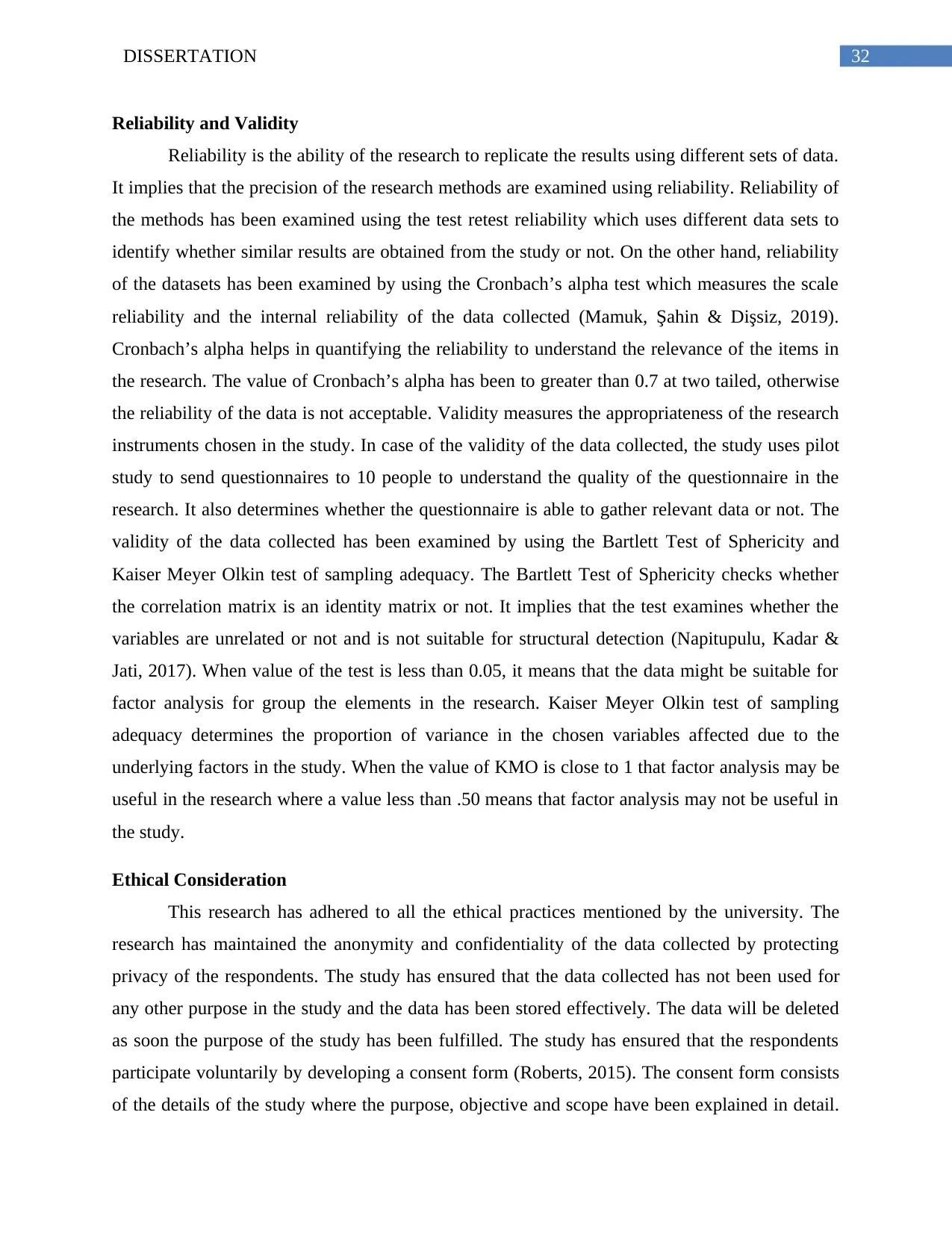
Reliability and Validity
Reliability is the ability of the research to replicate the results using different sets of data.
It implies that the precision of the research methods are examined using reliability. Reliability of
the methods has been examined using the test retest reliability which uses different data sets to
identify whether similar results are obtained from the study or not. On the other hand, reliability
of the datasets has been examined by using the Cronbach’s alpha test which measures the scale
reliability and the internal reliability of the data collected (Mamuk, Şahin & Dişsiz, 2019).
Cronbach’s alpha helps in quantifying the reliability to understand the relevance of the items in
the research. The value of Cronbach’s alpha has been to greater than 0.7 at two tailed, otherwise
the reliability of the data is not acceptable. Validity measures the appropriateness of the research
instruments chosen in the study. In case of the validity of the data collected, the study uses pilot
study to send questionnaires to 10 people to understand the quality of the questionnaire in the
research. It also determines whether the questionnaire is able to gather relevant data or not. The
validity of the data collected has been examined by using the Bartlett Test of Sphericity and
Kaiser Meyer Olkin test of sampling adequacy. The Bartlett Test of Sphericity checks whether
the correlation matrix is an identity matrix or not. It implies that the test examines whether the
variables are unrelated or not and is not suitable for structural detection (Napitupulu, Kadar &
Jati, 2017). When value of the test is less than 0.05, it means that the data might be suitable for
factor analysis for group the elements in the research. Kaiser Meyer Olkin test of sampling
adequacy determines the proportion of variance in the chosen variables affected due to the
underlying factors in the study. When the value of KMO is close to 1 that factor analysis may be
useful in the research where a value less than .50 means that factor analysis may not be useful in
the study.
Ethical Consideration
This research has adhered to all the ethical practices mentioned by the university. The
research has maintained the anonymity and confidentiality of the data collected by protecting
privacy of the respondents. The study has ensured that the data collected has not been used for
any other purpose in the study and the data has been stored effectively. The data will be deleted
as soon the purpose of the study has been fulfilled. The study has ensured that the respondents
participate voluntarily by developing a consent form (Roberts, 2015). The consent form consists
of the details of the study where the purpose, objective and scope have been explained in detail.
⊘ This is a preview!⊘
Do you want full access?
Subscribe today to unlock all pages.

Trusted by 1+ million students worldwide
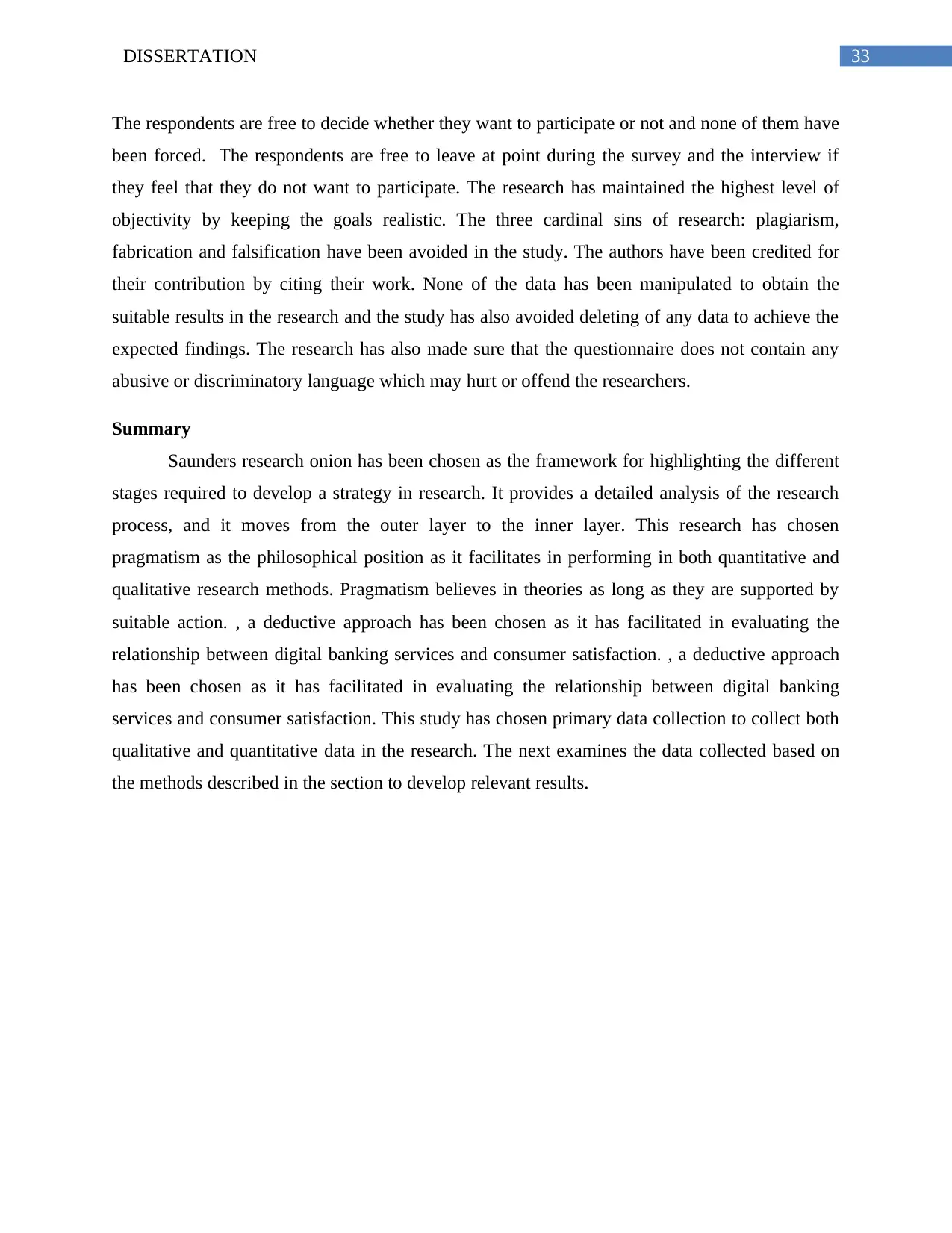
The respondents are free to decide whether they want to participate or not and none of them have
been forced. The respondents are free to leave at point during the survey and the interview if
they feel that they do not want to participate. The research has maintained the highest level of
objectivity by keeping the goals realistic. The three cardinal sins of research: plagiarism,
fabrication and falsification have been avoided in the study. The authors have been credited for
their contribution by citing their work. None of the data has been manipulated to obtain the
suitable results in the research and the study has also avoided deleting of any data to achieve the
expected findings. The research has also made sure that the questionnaire does not contain any
abusive or discriminatory language which may hurt or offend the researchers.
Summary
Saunders research onion has been chosen as the framework for highlighting the different
stages required to develop a strategy in research. It provides a detailed analysis of the research
process, and it moves from the outer layer to the inner layer. This research has chosen
pragmatism as the philosophical position as it facilitates in performing in both quantitative and
qualitative research methods. Pragmatism believes in theories as long as they are supported by
suitable action. , a deductive approach has been chosen as it has facilitated in evaluating the
relationship between digital banking services and consumer satisfaction. , a deductive approach
has been chosen as it has facilitated in evaluating the relationship between digital banking
services and consumer satisfaction. This study has chosen primary data collection to collect both
qualitative and quantitative data in the research. The next examines the data collected based on
the methods described in the section to develop relevant results.
Paraphrase This Document
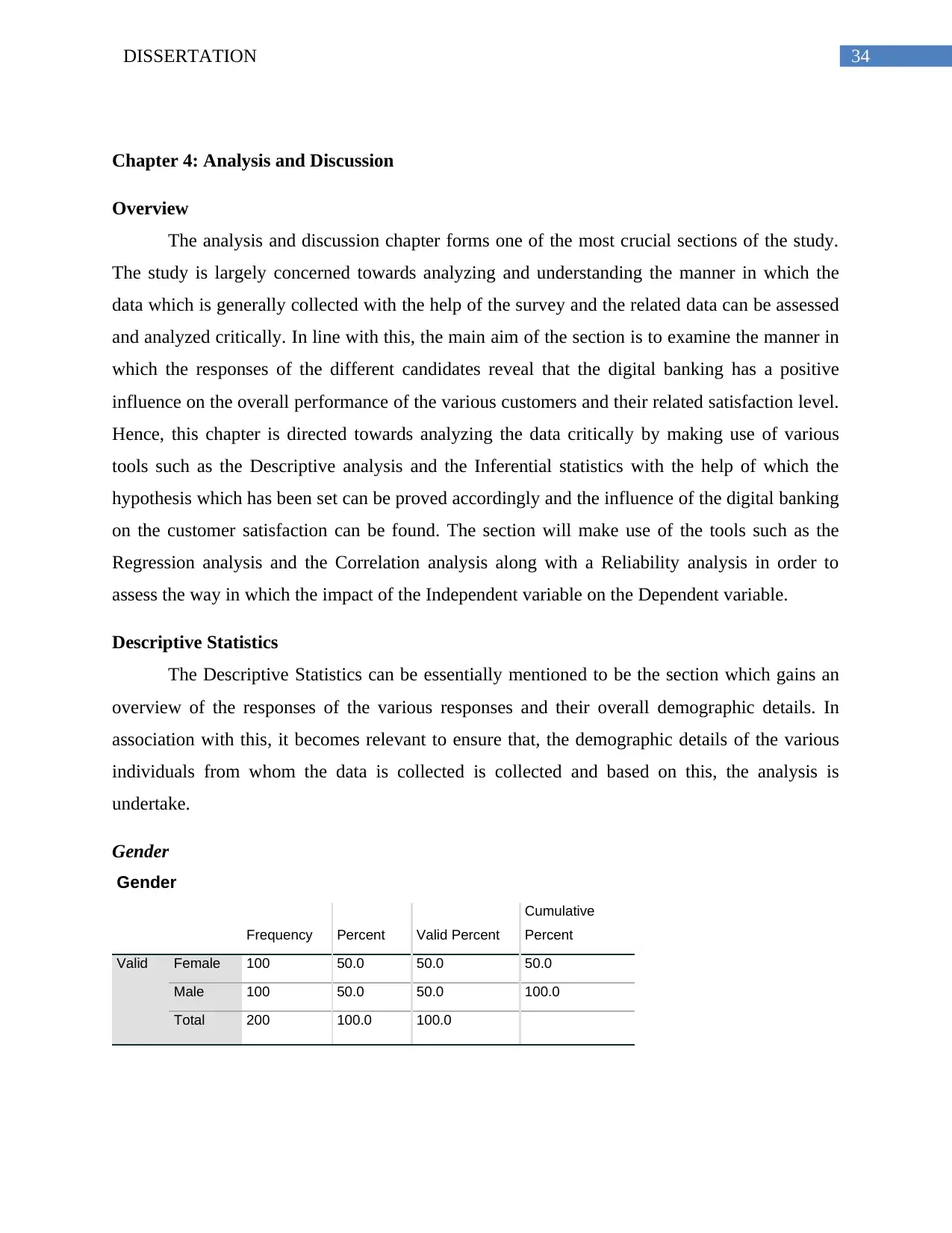
Chapter 4: Analysis and Discussion
Overview
The analysis and discussion chapter forms one of the most crucial sections of the study.
The study is largely concerned towards analyzing and understanding the manner in which the
data which is generally collected with the help of the survey and the related data can be assessed
and analyzed critically. In line with this, the main aim of the section is to examine the manner in
which the responses of the different candidates reveal that the digital banking has a positive
influence on the overall performance of the various customers and their related satisfaction level.
Hence, this chapter is directed towards analyzing the data critically by making use of various
tools such as the Descriptive analysis and the Inferential statistics with the help of which the
hypothesis which has been set can be proved accordingly and the influence of the digital banking
on the customer satisfaction can be found. The section will make use of the tools such as the
Regression analysis and the Correlation analysis along with a Reliability analysis in order to
assess the way in which the impact of the Independent variable on the Dependent variable.
Descriptive Statistics
The Descriptive Statistics can be essentially mentioned to be the section which gains an
overview of the responses of the various responses and their overall demographic details. In
association with this, it becomes relevant to ensure that, the demographic details of the various
individuals from whom the data is collected is collected and based on this, the analysis is
undertake.
Gender
Gender
Frequency Percent Valid Percent
Cumulative
Percent
Valid Female 100 50.0 50.0 50.0
Male 100 50.0 50.0 100.0
Total 200 100.0 100.0
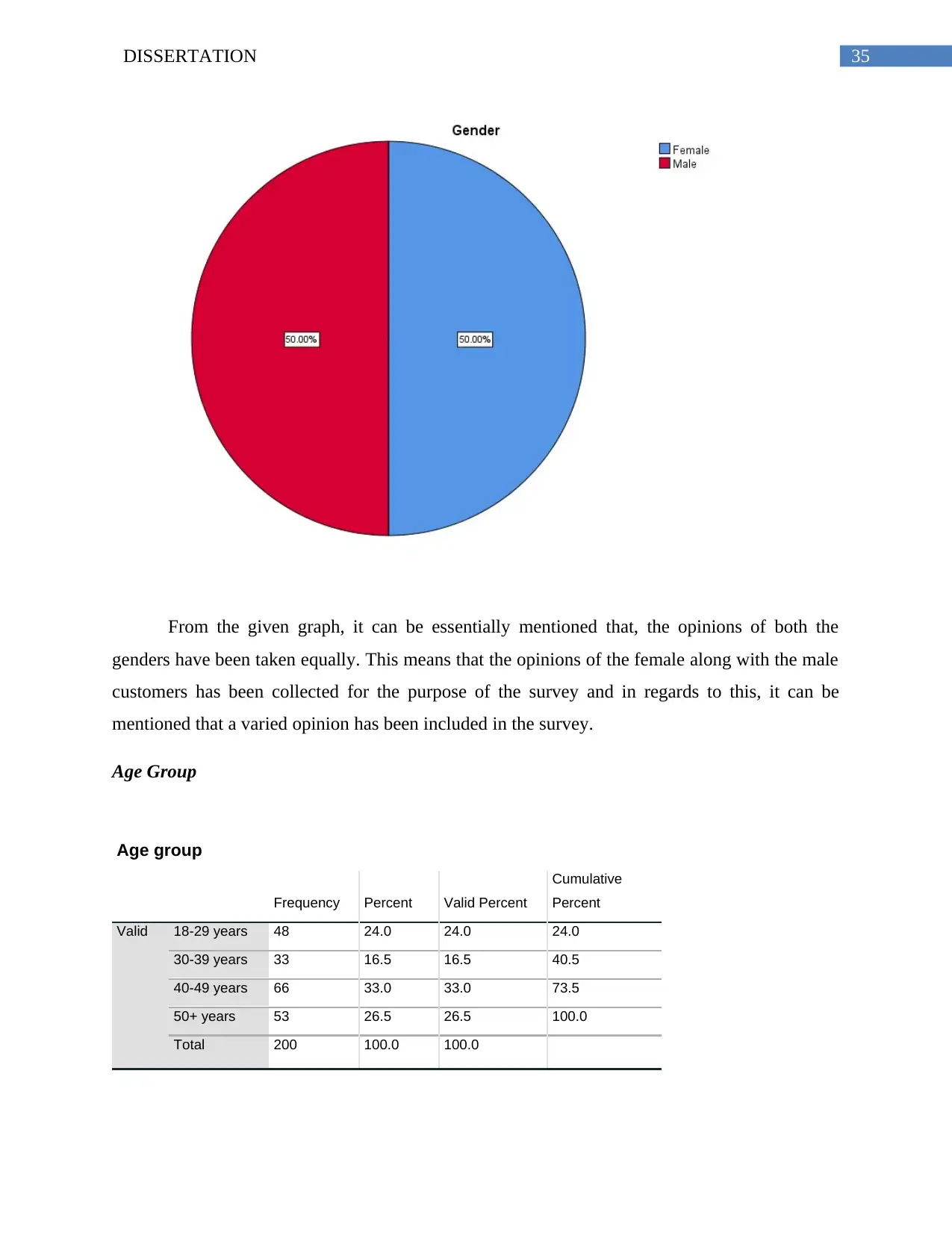
From the given graph, it can be essentially mentioned that, the opinions of both the
genders have been taken equally. This means that the opinions of the female along with the male
customers has been collected for the purpose of the survey and in regards to this, it can be
mentioned that a varied opinion has been included in the survey.
Age Group
Age group
Frequency Percent Valid Percent
Cumulative
Percent
Valid 18-29 years 48 24.0 24.0 24.0
30-39 years 33 16.5 16.5 40.5
40-49 years 66 33.0 33.0 73.5
50+ years 53 26.5 26.5 100.0
Total 200 100.0 100.0
⊘ This is a preview!⊘
Do you want full access?
Subscribe today to unlock all pages.

Trusted by 1+ million students worldwide
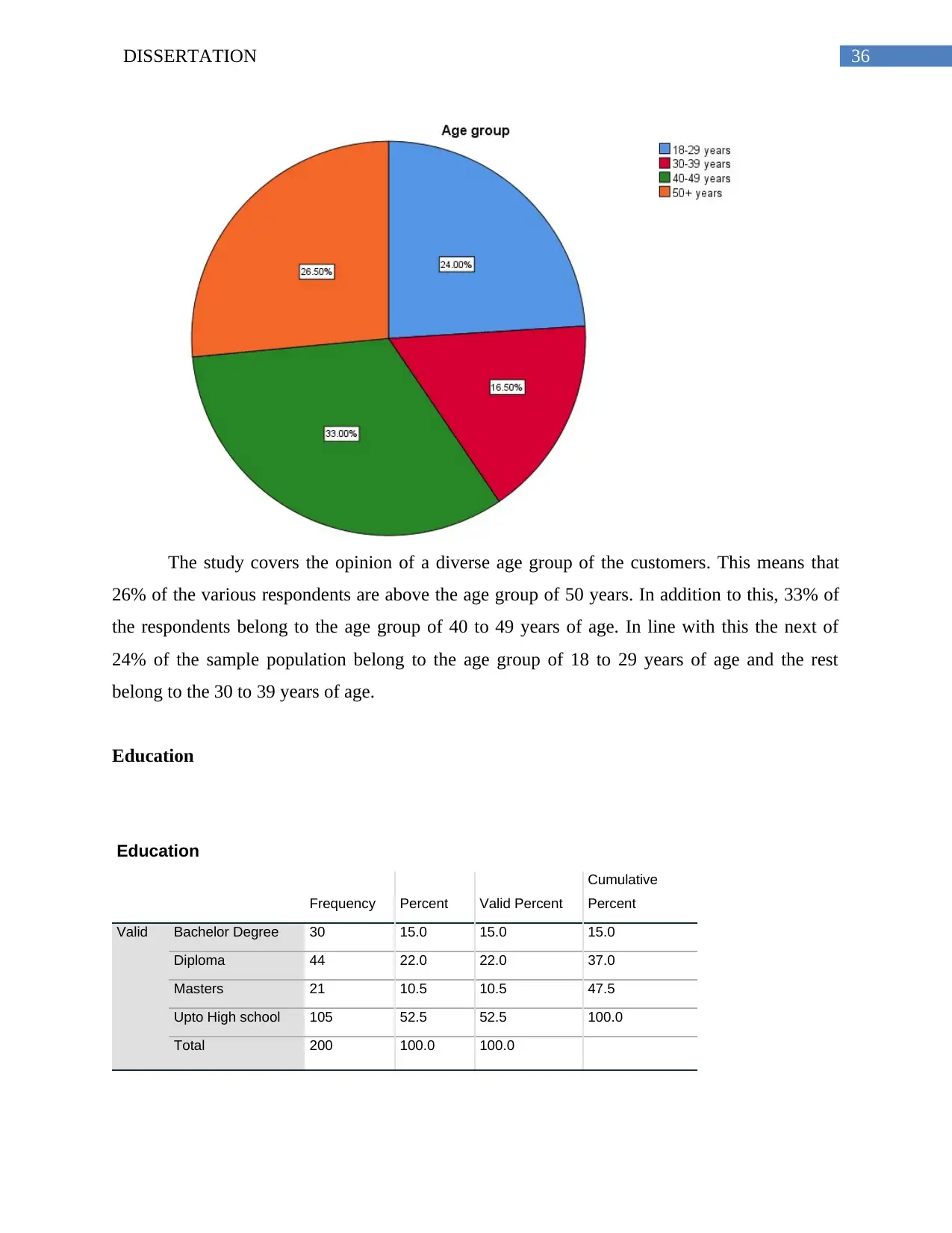
The study covers the opinion of a diverse age group of the customers. This means that
26% of the various respondents are above the age group of 50 years. In addition to this, 33% of
the respondents belong to the age group of 40 to 49 years of age. In line with this the next of
24% of the sample population belong to the age group of 18 to 29 years of age and the rest
belong to the 30 to 39 years of age.
Education
Education
Frequency Percent Valid Percent
Cumulative
Percent
Valid Bachelor Degree 30 15.0 15.0 15.0
Diploma 44 22.0 22.0 37.0
Masters 21 10.5 10.5 47.5
Upto High school 105 52.5 52.5 100.0
Total 200 100.0 100.0
Paraphrase This Document
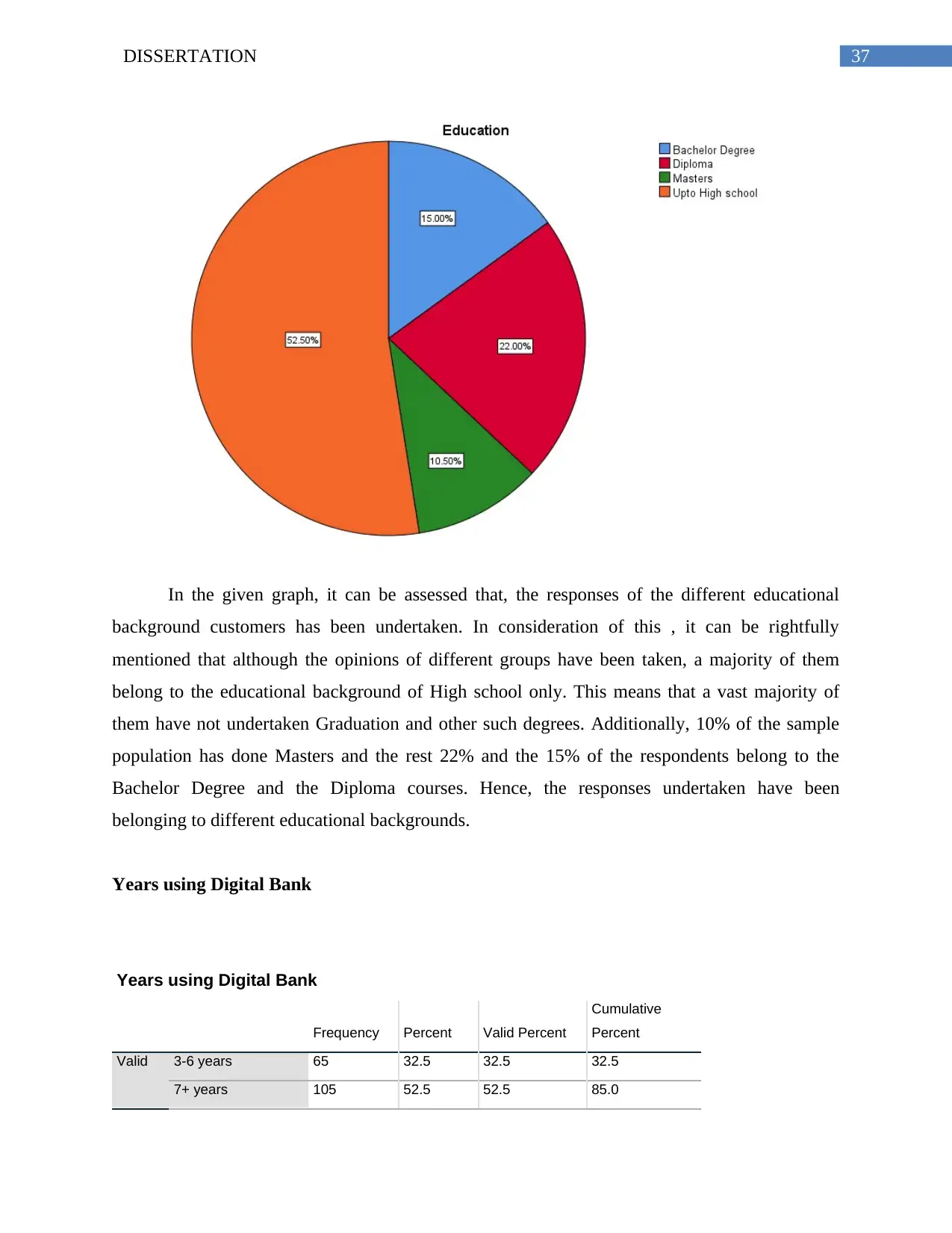
In the given graph, it can be assessed that, the responses of the different educational
background customers has been undertaken. In consideration of this , it can be rightfully
mentioned that although the opinions of different groups have been taken, a majority of them
belong to the educational background of High school only. This means that a vast majority of
them have not undertaken Graduation and other such degrees. Additionally, 10% of the sample
population has done Masters and the rest 22% and the 15% of the respondents belong to the
Bachelor Degree and the Diploma courses. Hence, the responses undertaken have been
belonging to different educational backgrounds.
Years using Digital Bank
Years using Digital Bank
Frequency Percent Valid Percent
Cumulative
Percent
Valid 3-6 years 65 32.5 32.5 32.5
7+ years 105 52.5 52.5 85.0
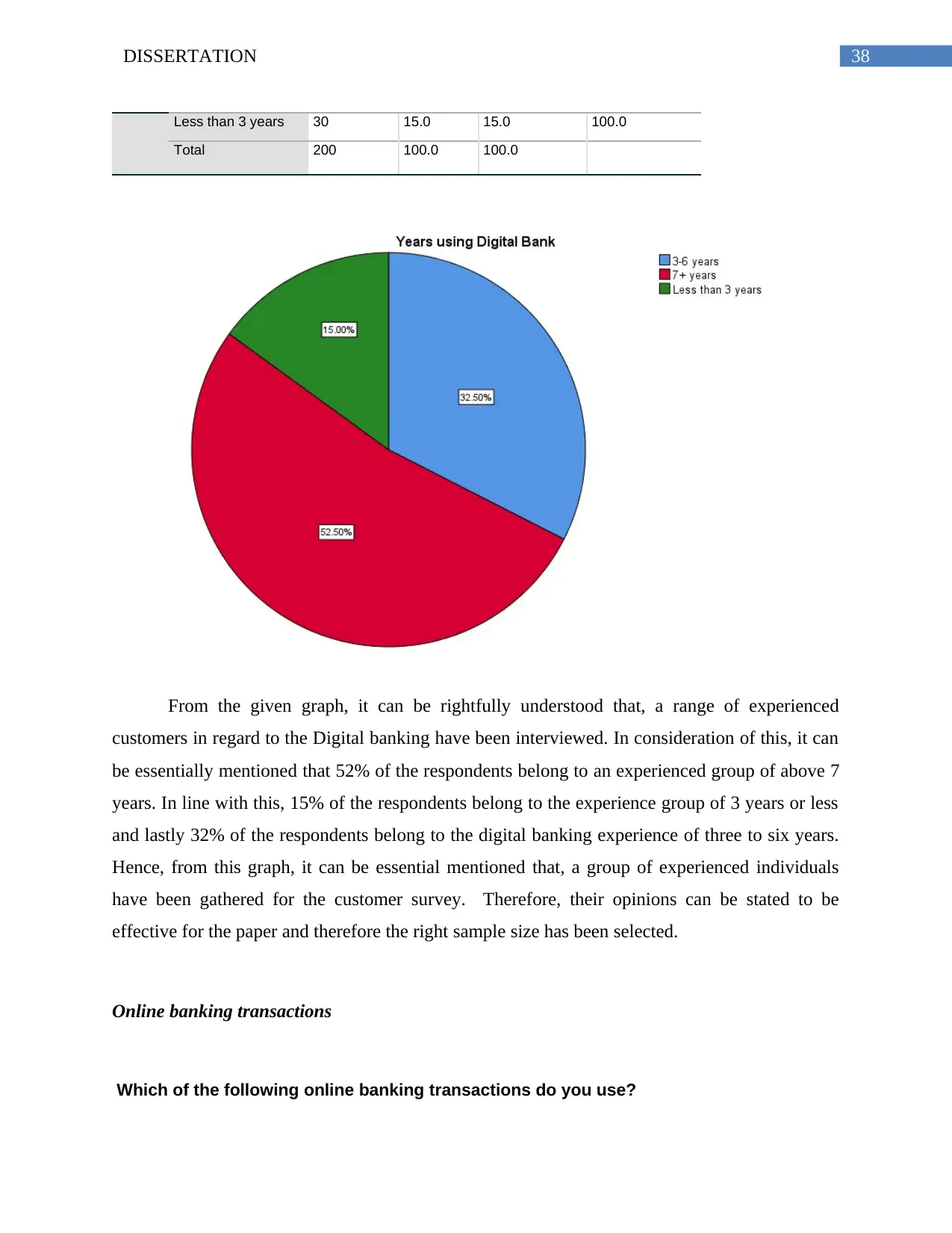
Less than 3 years 30 15.0 15.0 100.0
Total 200 100.0 100.0
From the given graph, it can be rightfully understood that, a range of experienced
customers in regard to the Digital banking have been interviewed. In consideration of this, it can
be essentially mentioned that 52% of the respondents belong to an experienced group of above 7
years. In line with this, 15% of the respondents belong to the experience group of 3 years or less
and lastly 32% of the respondents belong to the digital banking experience of three to six years.
Hence, from this graph, it can be essential mentioned that, a group of experienced individuals
have been gathered for the customer survey. Therefore, their opinions can be stated to be
effective for the paper and therefore the right sample size has been selected.
Online banking transactions
Which of the following online banking transactions do you use?
⊘ This is a preview!⊘
Do you want full access?
Subscribe today to unlock all pages.

Trusted by 1+ million students worldwide
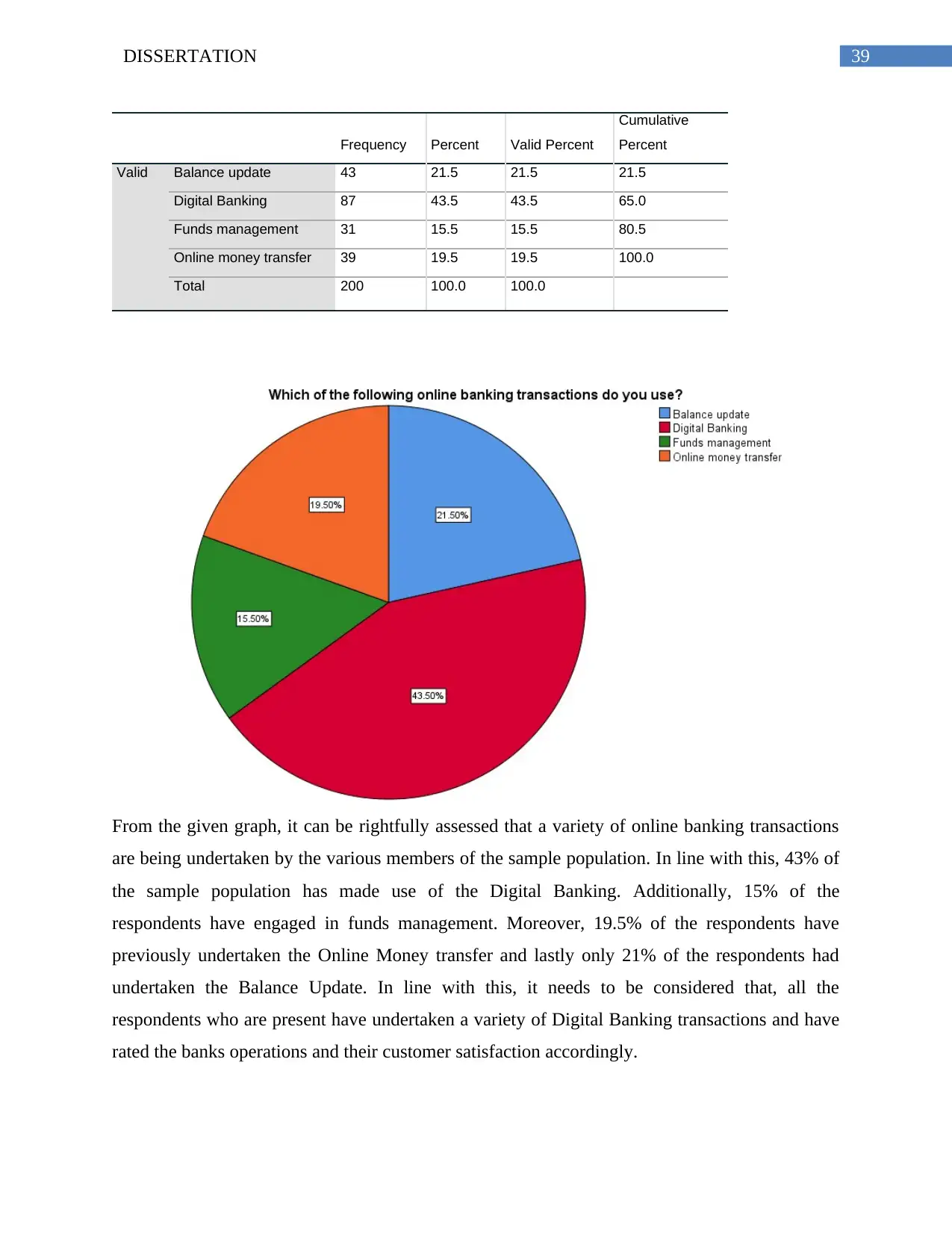
Frequency Percent Valid Percent
Cumulative
Percent
Valid Balance update 43 21.5 21.5 21.5
Digital Banking 87 43.5 43.5 65.0
Funds management 31 15.5 15.5 80.5
Online money transfer 39 19.5 19.5 100.0
Total 200 100.0 100.0
From the given graph, it can be rightfully assessed that a variety of online banking transactions
are being undertaken by the various members of the sample population. In line with this, 43% of
the sample population has made use of the Digital Banking. Additionally, 15% of the
respondents have engaged in funds management. Moreover, 19.5% of the respondents have
previously undertaken the Online Money transfer and lastly only 21% of the respondents had
undertaken the Balance Update. In line with this, it needs to be considered that, all the
respondents who are present have undertaken a variety of Digital Banking transactions and have
rated the banks operations and their customer satisfaction accordingly.
Paraphrase This Document
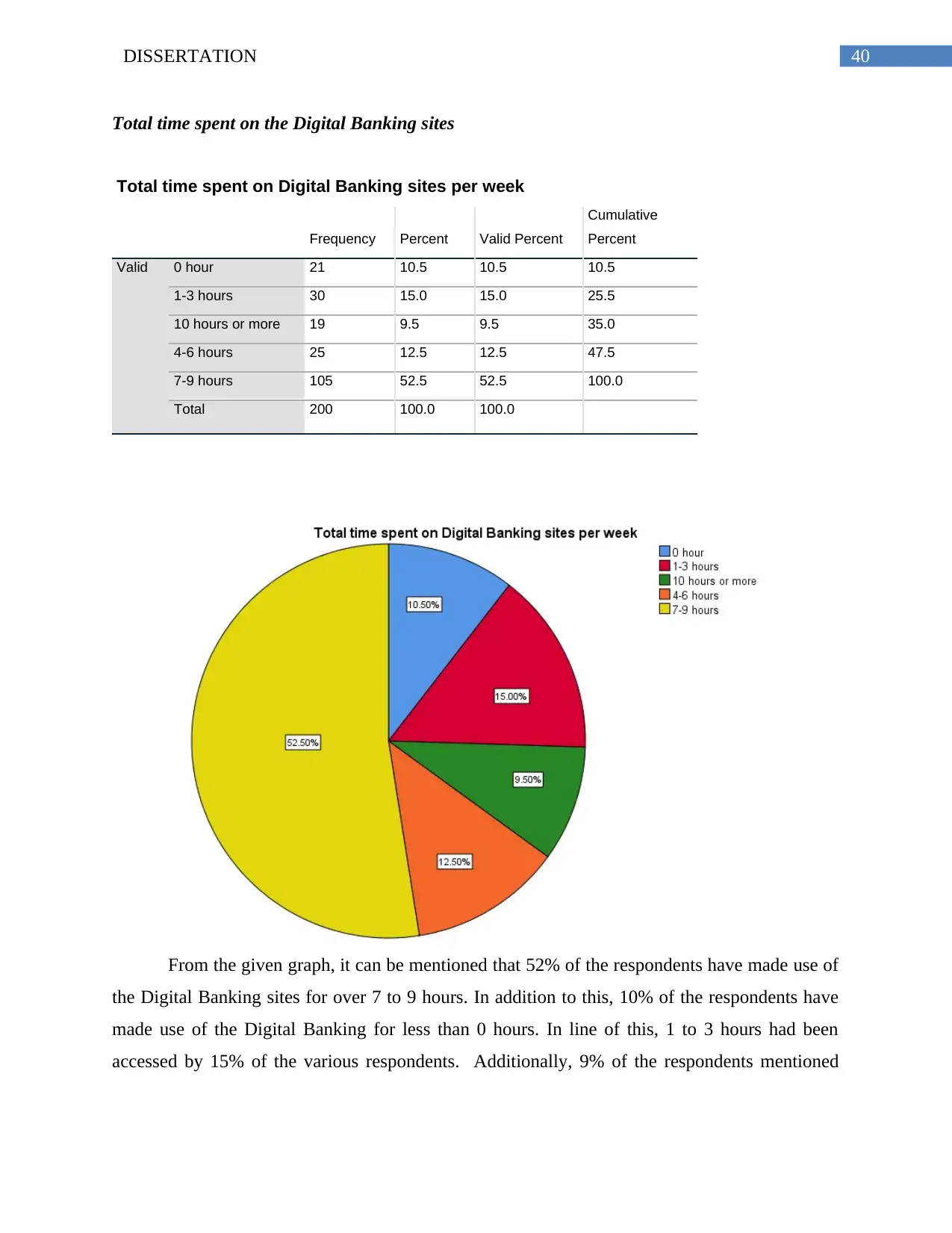
Total time spent on the Digital Banking sites
Total time spent on Digital Banking sites per week
Frequency Percent Valid Percent
Cumulative
Percent
Valid 0 hour 21 10.5 10.5 10.5
1-3 hours 30 15.0 15.0 25.5
10 hours or more 19 9.5 9.5 35.0
4-6 hours 25 12.5 12.5 47.5
7-9 hours 105 52.5 52.5 100.0
Total 200 100.0 100.0
From the given graph, it can be mentioned that 52% of the respondents have made use of
the Digital Banking sites for over 7 to 9 hours. In addition to this, 10% of the respondents have
made use of the Digital Banking for less than 0 hours. In line of this, 1 to 3 hours had been
accessed by 15% of the various respondents. Additionally, 9% of the respondents mentioned
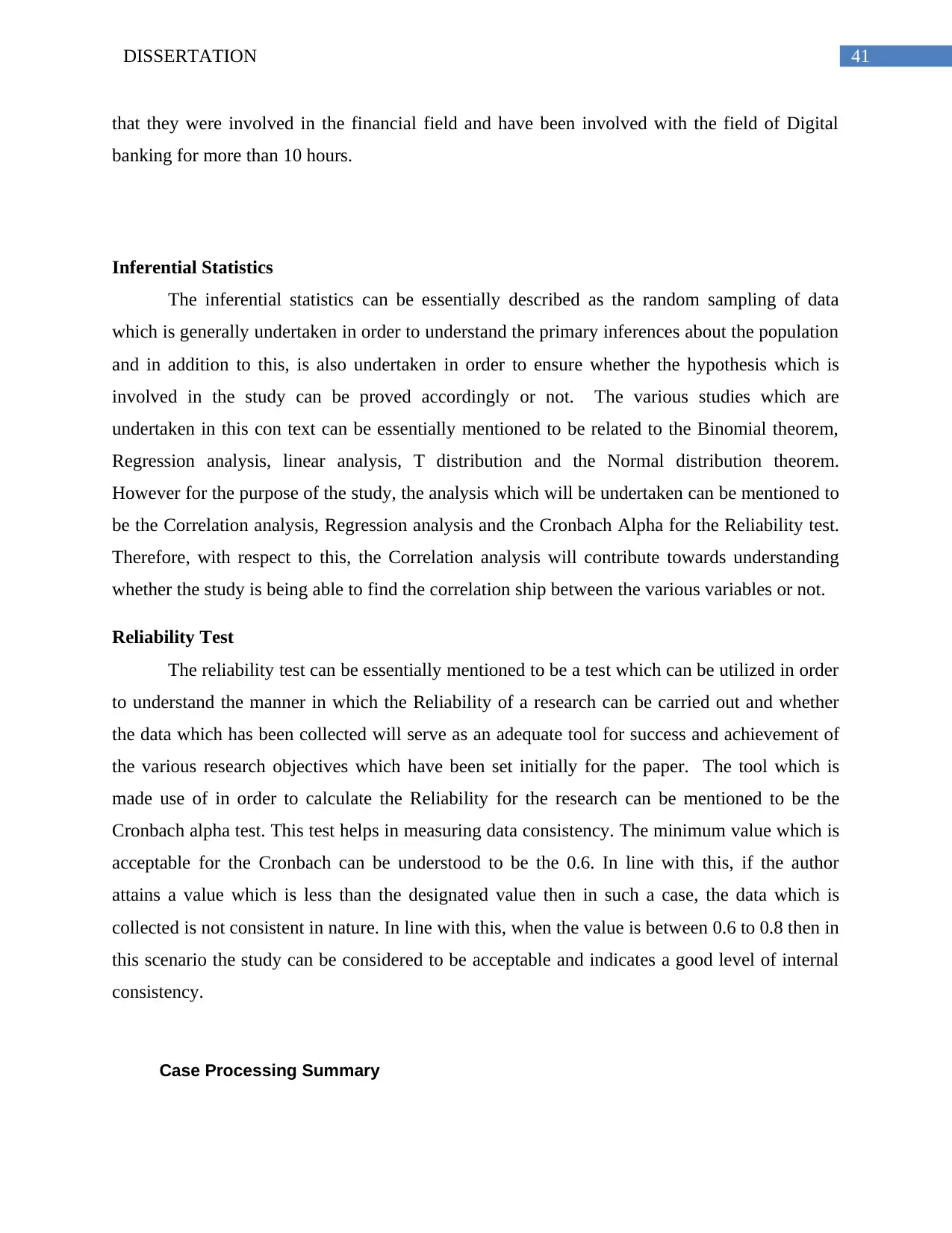
that they were involved in the financial field and have been involved with the field of Digital
banking for more than 10 hours.
Inferential Statistics
The inferential statistics can be essentially described as the random sampling of data
which is generally undertaken in order to understand the primary inferences about the population
and in addition to this, is also undertaken in order to ensure whether the hypothesis which is
involved in the study can be proved accordingly or not. The various studies which are
undertaken in this con text can be essentially mentioned to be related to the Binomial theorem,
Regression analysis, linear analysis, T distribution and the Normal distribution theorem.
However for the purpose of the study, the analysis which will be undertaken can be mentioned to
be the Correlation analysis, Regression analysis and the Cronbach Alpha for the Reliability test.
Therefore, with respect to this, the Correlation analysis will contribute towards understanding
whether the study is being able to find the correlation ship between the various variables or not.
Reliability Test
The reliability test can be essentially mentioned to be a test which can be utilized in order
to understand the manner in which the Reliability of a research can be carried out and whether
the data which has been collected will serve as an adequate tool for success and achievement of
the various research objectives which have been set initially for the paper. The tool which is
made use of in order to calculate the Reliability for the research can be mentioned to be the
Cronbach alpha test. This test helps in measuring data consistency. The minimum value which is
acceptable for the Cronbach can be understood to be the 0.6. In line with this, if the author
attains a value which is less than the designated value then in such a case, the data which is
collected is not consistent in nature. In line with this, when the value is between 0.6 to 0.8 then in
this scenario the study can be considered to be acceptable and indicates a good level of internal
consistency.
Case Processing Summary
⊘ This is a preview!⊘
Do you want full access?
Subscribe today to unlock all pages.

Trusted by 1+ million students worldwide
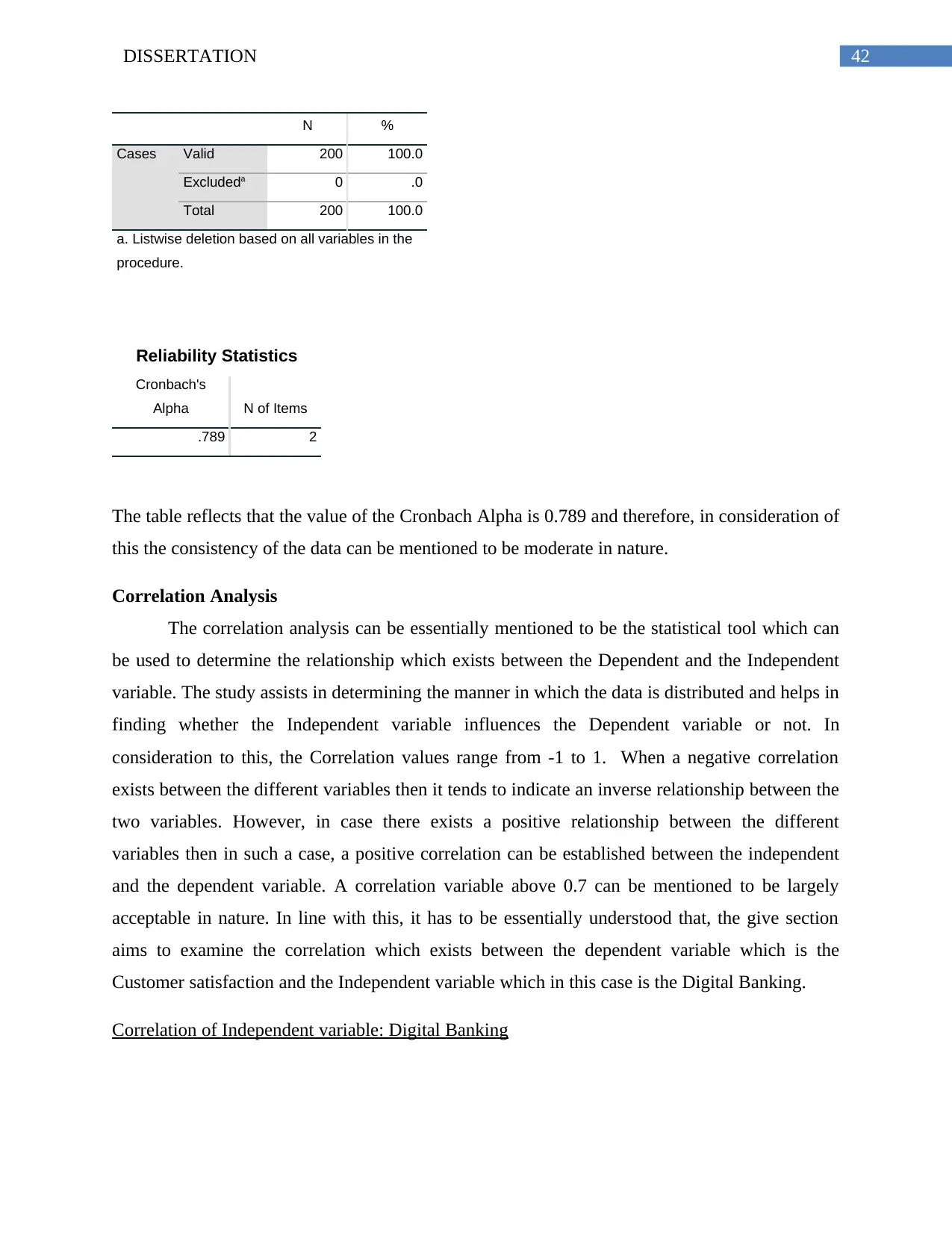
N %
Cases Valid 200 100.0
Excludeda 0 .0
Total 200 100.0
a. Listwise deletion based on all variables in the
procedure.
Reliability Statistics
Cronbach's
Alpha N of Items
.789 2
The table reflects that the value of the Cronbach Alpha is 0.789 and therefore, in consideration of
this the consistency of the data can be mentioned to be moderate in nature.
Correlation Analysis
The correlation analysis can be essentially mentioned to be the statistical tool which can
be used to determine the relationship which exists between the Dependent and the Independent
variable. The study assists in determining the manner in which the data is distributed and helps in
finding whether the Independent variable influences the Dependent variable or not. In
consideration to this, the Correlation values range from -1 to 1. When a negative correlation
exists between the different variables then it tends to indicate an inverse relationship between the
two variables. However, in case there exists a positive relationship between the different
variables then in such a case, a positive correlation can be established between the independent
and the dependent variable. A correlation variable above 0.7 can be mentioned to be largely
acceptable in nature. In line with this, it has to be essentially understood that, the give section
aims to examine the correlation which exists between the dependent variable which is the
Customer satisfaction and the Independent variable which in this case is the Digital Banking.
Correlation of Independent variable: Digital Banking
Paraphrase This Document
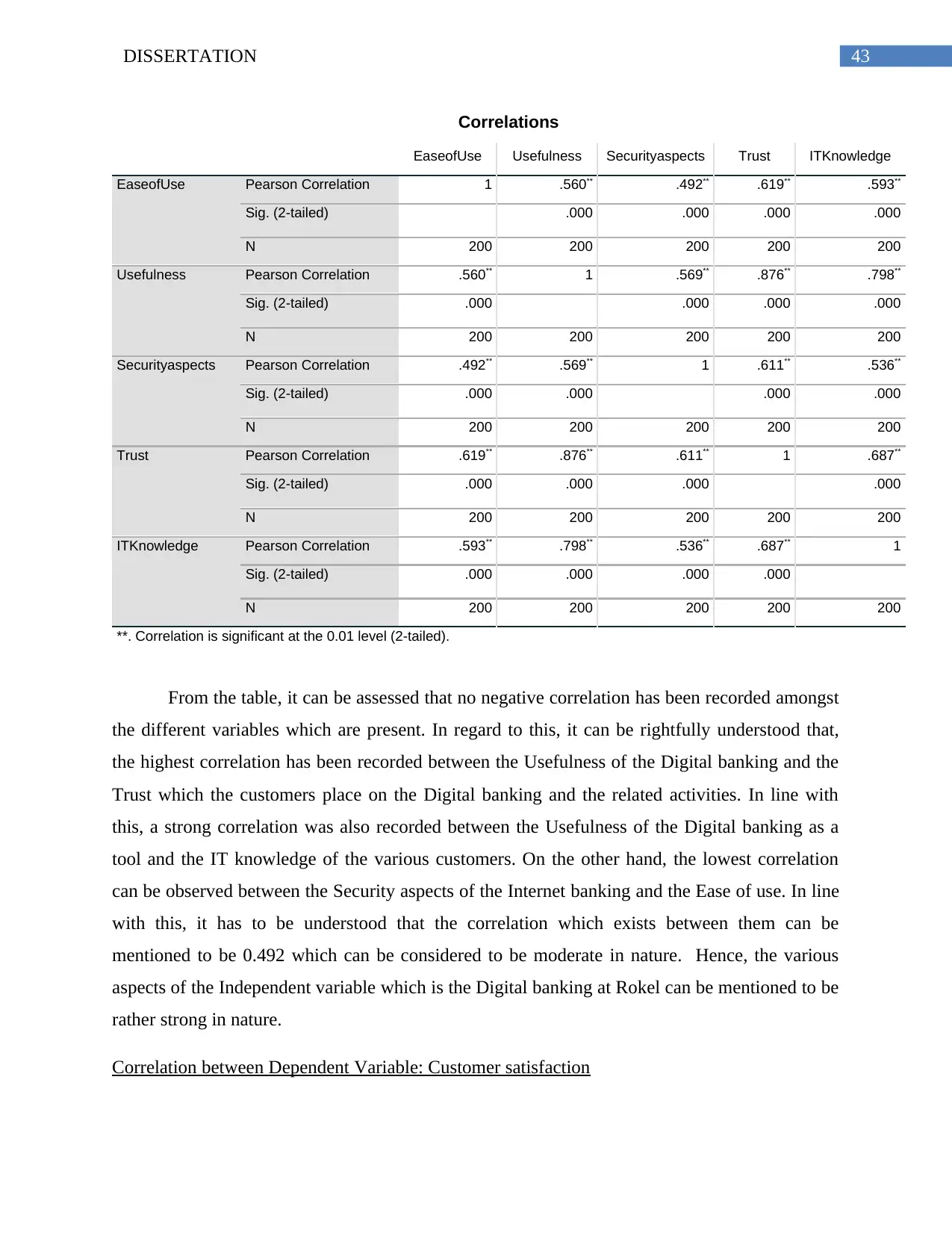
Correlations
EaseofUse Usefulness Securityaspects Trust ITKnowledge
EaseofUse Pearson Correlation 1 .560** .492** .619** .593**
Sig. (2-tailed) .000 .000 .000 .000
N 200 200 200 200 200
Usefulness Pearson Correlation .560** 1 .569** .876** .798**
Sig. (2-tailed) .000 .000 .000 .000
N 200 200 200 200 200
Securityaspects Pearson Correlation .492** .569** 1 .611** .536**
Sig. (2-tailed) .000 .000 .000 .000
N 200 200 200 200 200
Trust Pearson Correlation .619** .876** .611** 1 .687**
Sig. (2-tailed) .000 .000 .000 .000
N 200 200 200 200 200
ITKnowledge Pearson Correlation .593** .798** .536** .687** 1
Sig. (2-tailed) .000 .000 .000 .000
N 200 200 200 200 200
**. Correlation is significant at the 0.01 level (2-tailed).
From the table, it can be assessed that no negative correlation has been recorded amongst
the different variables which are present. In regard to this, it can be rightfully understood that,
the highest correlation has been recorded between the Usefulness of the Digital banking and the
Trust which the customers place on the Digital banking and the related activities. In line with
this, a strong correlation was also recorded between the Usefulness of the Digital banking as a
tool and the IT knowledge of the various customers. On the other hand, the lowest correlation
can be observed between the Security aspects of the Internet banking and the Ease of use. In line
with this, it has to be understood that the correlation which exists between them can be
mentioned to be 0.492 which can be considered to be moderate in nature. Hence, the various
aspects of the Independent variable which is the Digital banking at Rokel can be mentioned to be
rather strong in nature.
Correlation between Dependent Variable: Customer satisfaction
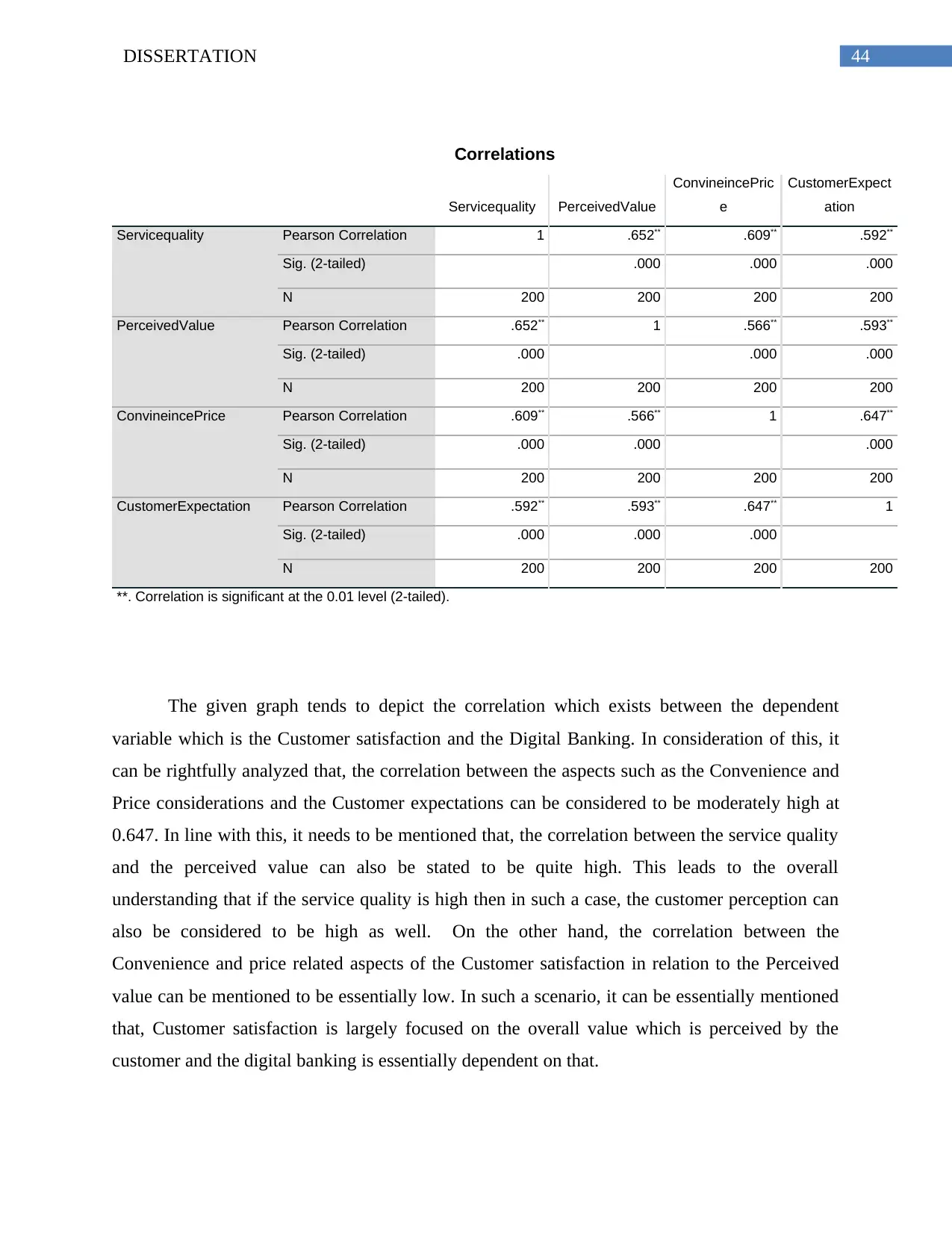
Correlations
Servicequality PerceivedValue
ConvineincePric
e
CustomerExpect
ation
Servicequality Pearson Correlation 1 .652** .609** .592**
Sig. (2-tailed) .000 .000 .000
N 200 200 200 200
PerceivedValue Pearson Correlation .652** 1 .566** .593**
Sig. (2-tailed) .000 .000 .000
N 200 200 200 200
ConvineincePrice Pearson Correlation .609** .566** 1 .647**
Sig. (2-tailed) .000 .000 .000
N 200 200 200 200
CustomerExpectation Pearson Correlation .592** .593** .647** 1
Sig. (2-tailed) .000 .000 .000
N 200 200 200 200
**. Correlation is significant at the 0.01 level (2-tailed).
The given graph tends to depict the correlation which exists between the dependent
variable which is the Customer satisfaction and the Digital Banking. In consideration of this, it
can be rightfully analyzed that, the correlation between the aspects such as the Convenience and
Price considerations and the Customer expectations can be considered to be moderately high at
0.647. In line with this, it needs to be mentioned that, the correlation between the service quality
and the perceived value can also be stated to be quite high. This leads to the overall
understanding that if the service quality is high then in such a case, the customer perception can
also be considered to be high as well. On the other hand, the correlation between the
Convenience and price related aspects of the Customer satisfaction in relation to the Perceived
value can be mentioned to be essentially low. In such a scenario, it can be essentially mentioned
that, Customer satisfaction is largely focused on the overall value which is perceived by the
customer and the digital banking is essentially dependent on that.
⊘ This is a preview!⊘
Do you want full access?
Subscribe today to unlock all pages.

Trusted by 1+ million students worldwide
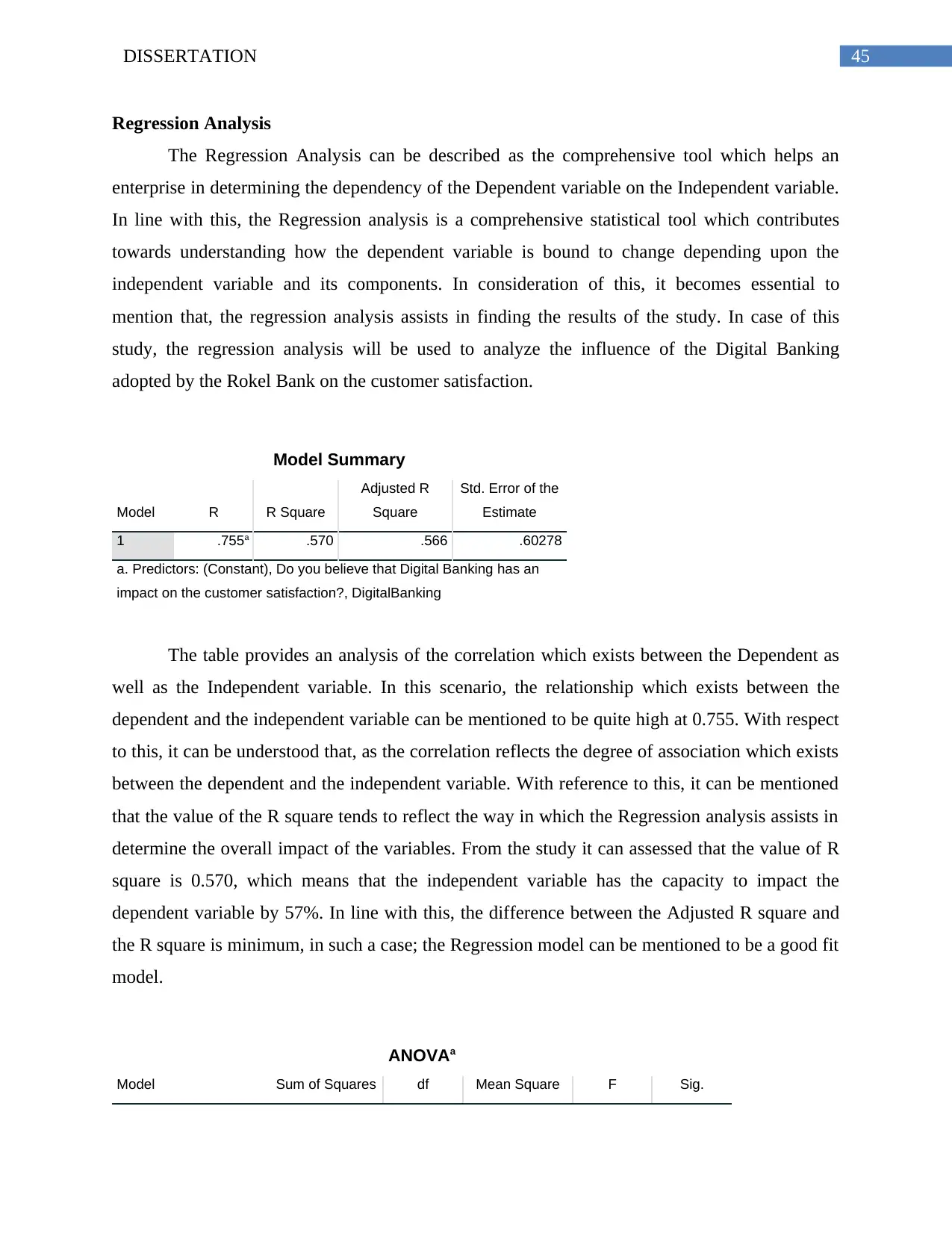
Regression Analysis
The Regression Analysis can be described as the comprehensive tool which helps an
enterprise in determining the dependency of the Dependent variable on the Independent variable.
In line with this, the Regression analysis is a comprehensive statistical tool which contributes
towards understanding how the dependent variable is bound to change depending upon the
independent variable and its components. In consideration of this, it becomes essential to
mention that, the regression analysis assists in finding the results of the study. In case of this
study, the regression analysis will be used to analyze the influence of the Digital Banking
adopted by the Rokel Bank on the customer satisfaction.
Model Summary
Model R R Square
Adjusted R
Square
Std. Error of the
Estimate
1 .755a .570 .566 .60278
a. Predictors: (Constant), Do you believe that Digital Banking has an
impact on the customer satisfaction?, DigitalBanking
The table provides an analysis of the correlation which exists between the Dependent as
well as the Independent variable. In this scenario, the relationship which exists between the
dependent and the independent variable can be mentioned to be quite high at 0.755. With respect
to this, it can be understood that, as the correlation reflects the degree of association which exists
between the dependent and the independent variable. With reference to this, it can be mentioned
that the value of the R square tends to reflect the way in which the Regression analysis assists in
determine the overall impact of the variables. From the study it can assessed that the value of R
square is 0.570, which means that the independent variable has the capacity to impact the
dependent variable by 57%. In line with this, the difference between the Adjusted R square and
the R square is minimum, in such a case; the Regression model can be mentioned to be a good fit
model.
ANOVAa
Model Sum of Squares df Mean Square F Sig.
Paraphrase This Document
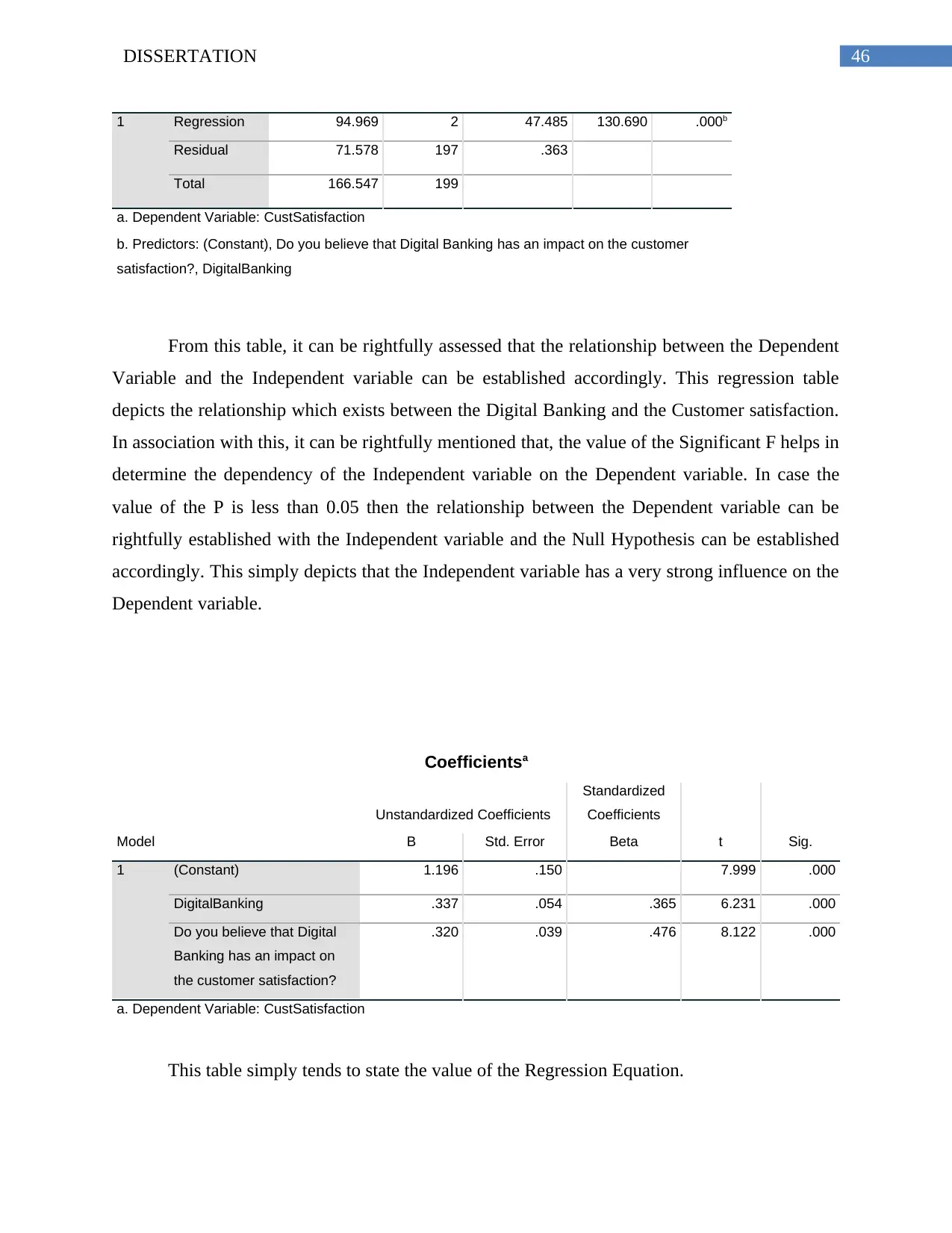
1 Regression 94.969 2 47.485 130.690 .000b
Residual 71.578 197 .363
Total 166.547 199
a. Dependent Variable: CustSatisfaction
b. Predictors: (Constant), Do you believe that Digital Banking has an impact on the customer
satisfaction?, DigitalBanking
From this table, it can be rightfully assessed that the relationship between the Dependent
Variable and the Independent variable can be established accordingly. This regression table
depicts the relationship which exists between the Digital Banking and the Customer satisfaction.
In association with this, it can be rightfully mentioned that, the value of the Significant F helps in
determine the dependency of the Independent variable on the Dependent variable. In case the
value of the P is less than 0.05 then the relationship between the Dependent variable can be
rightfully established with the Independent variable and the Null Hypothesis can be established
accordingly. This simply depicts that the Independent variable has a very strong influence on the
Dependent variable.
Coefficientsa
Model
Unstandardized Coefficients
Standardized
Coefficients
t Sig.B Std. Error Beta
1 (Constant) 1.196 .150 7.999 .000
DigitalBanking .337 .054 .365 6.231 .000
Do you believe that Digital
Banking has an impact on
the customer satisfaction?
.320 .039 .476 8.122 .000
a. Dependent Variable: CustSatisfaction
This table simply tends to state the value of the Regression Equation.
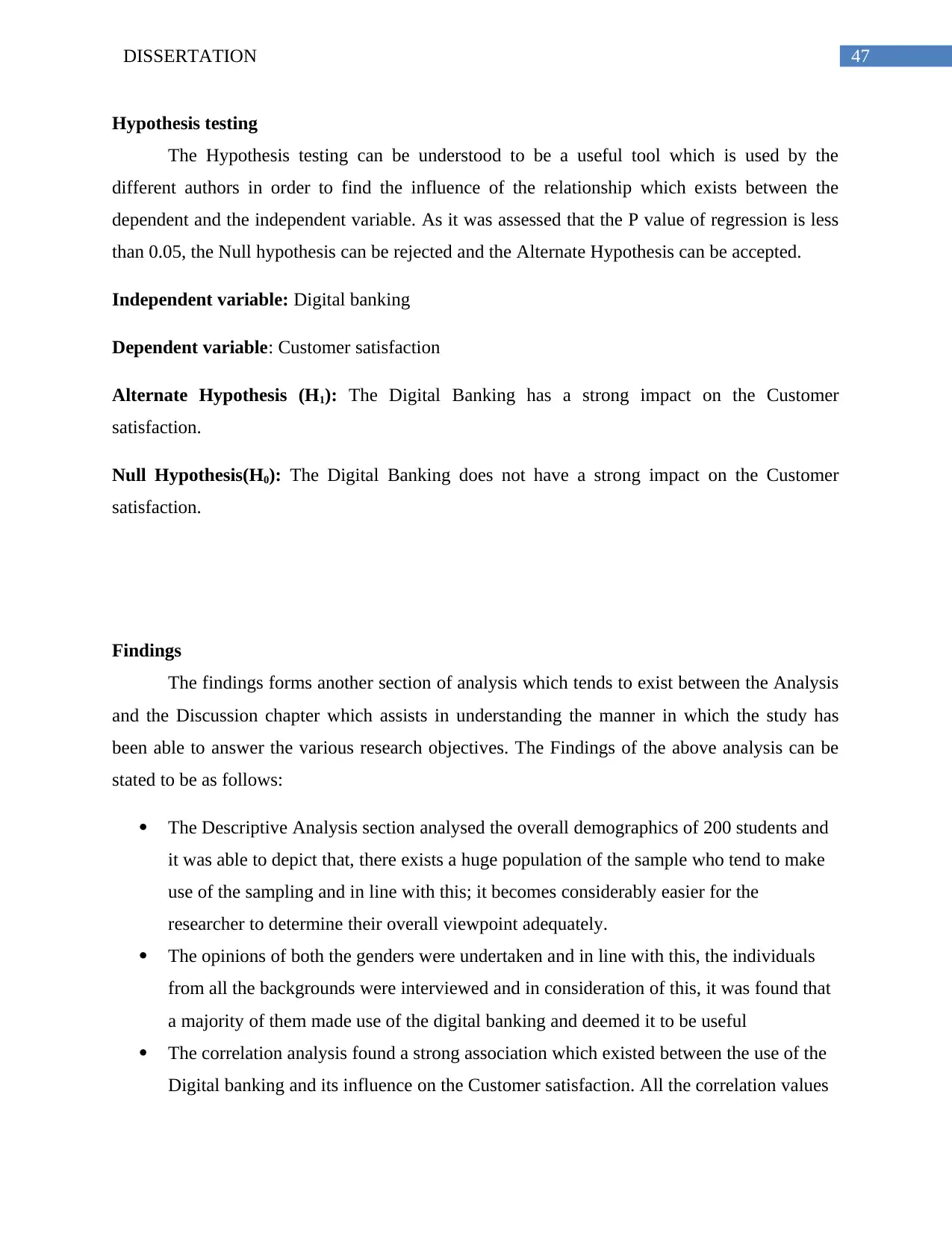
Hypothesis testing
The Hypothesis testing can be understood to be a useful tool which is used by the
different authors in order to find the influence of the relationship which exists between the
dependent and the independent variable. As it was assessed that the P value of regression is less
than 0.05, the Null hypothesis can be rejected and the Alternate Hypothesis can be accepted.
Independent variable: Digital banking
Dependent variable: Customer satisfaction
Alternate Hypothesis (H1): The Digital Banking has a strong impact on the Customer
satisfaction.
Null Hypothesis(H0): The Digital Banking does not have a strong impact on the Customer
satisfaction.
Findings
The findings forms another section of analysis which tends to exist between the Analysis
and the Discussion chapter which assists in understanding the manner in which the study has
been able to answer the various research objectives. The Findings of the above analysis can be
stated to be as follows:
The Descriptive Analysis section analysed the overall demographics of 200 students and
it was able to depict that, there exists a huge population of the sample who tend to make
use of the sampling and in line with this; it becomes considerably easier for the
researcher to determine their overall viewpoint adequately.
The opinions of both the genders were undertaken and in line with this, the individuals
from all the backgrounds were interviewed and in consideration of this, it was found that
a majority of them made use of the digital banking and deemed it to be useful
The correlation analysis found a strong association which existed between the use of the
Digital banking and its influence on the Customer satisfaction. All the correlation values
⊘ This is a preview!⊘
Do you want full access?
Subscribe today to unlock all pages.

Trusted by 1+ million students worldwide
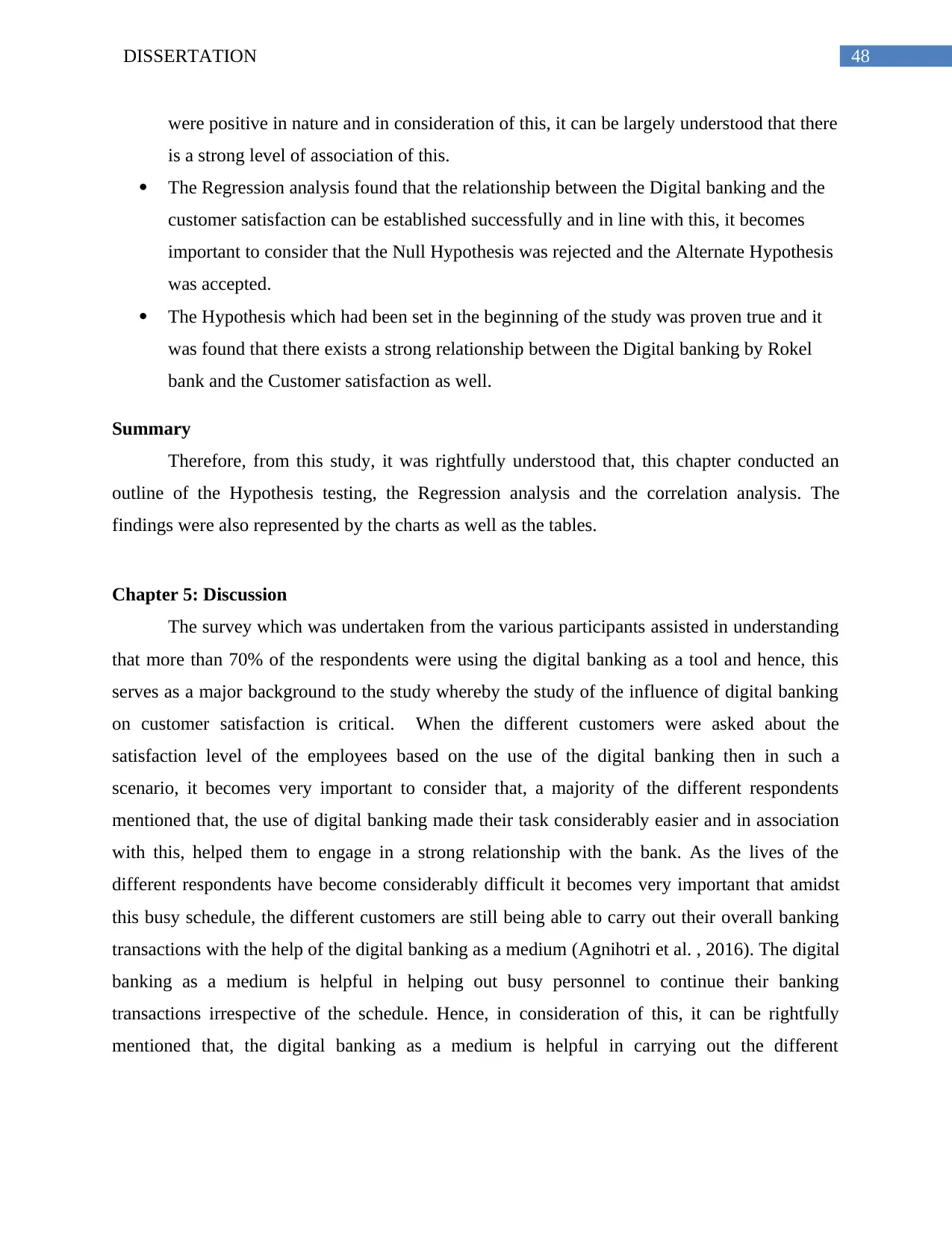
were positive in nature and in consideration of this, it can be largely understood that there
is a strong level of association of this.
The Regression analysis found that the relationship between the Digital banking and the
customer satisfaction can be established successfully and in line with this, it becomes
important to consider that the Null Hypothesis was rejected and the Alternate Hypothesis
was accepted.
The Hypothesis which had been set in the beginning of the study was proven true and it
was found that there exists a strong relationship between the Digital banking by Rokel
bank and the Customer satisfaction as well.
Summary
Therefore, from this study, it was rightfully understood that, this chapter conducted an
outline of the Hypothesis testing, the Regression analysis and the correlation analysis. The
findings were also represented by the charts as well as the tables.
Chapter 5: Discussion
The survey which was undertaken from the various participants assisted in understanding
that more than 70% of the respondents were using the digital banking as a tool and hence, this
serves as a major background to the study whereby the study of the influence of digital banking
on customer satisfaction is critical. When the different customers were asked about the
satisfaction level of the employees based on the use of the digital banking then in such a
scenario, it becomes very important to consider that, a majority of the different respondents
mentioned that, the use of digital banking made their task considerably easier and in association
with this, helped them to engage in a strong relationship with the bank. As the lives of the
different respondents have become considerably difficult it becomes very important that amidst
this busy schedule, the different customers are still being able to carry out their overall banking
transactions with the help of the digital banking as a medium (Agnihotri et al. , 2016). The digital
banking as a medium is helpful in helping out busy personnel to continue their banking
transactions irrespective of the schedule. Hence, in consideration of this, it can be rightfully
mentioned that, the digital banking as a medium is helpful in carrying out the different
Paraphrase This Document
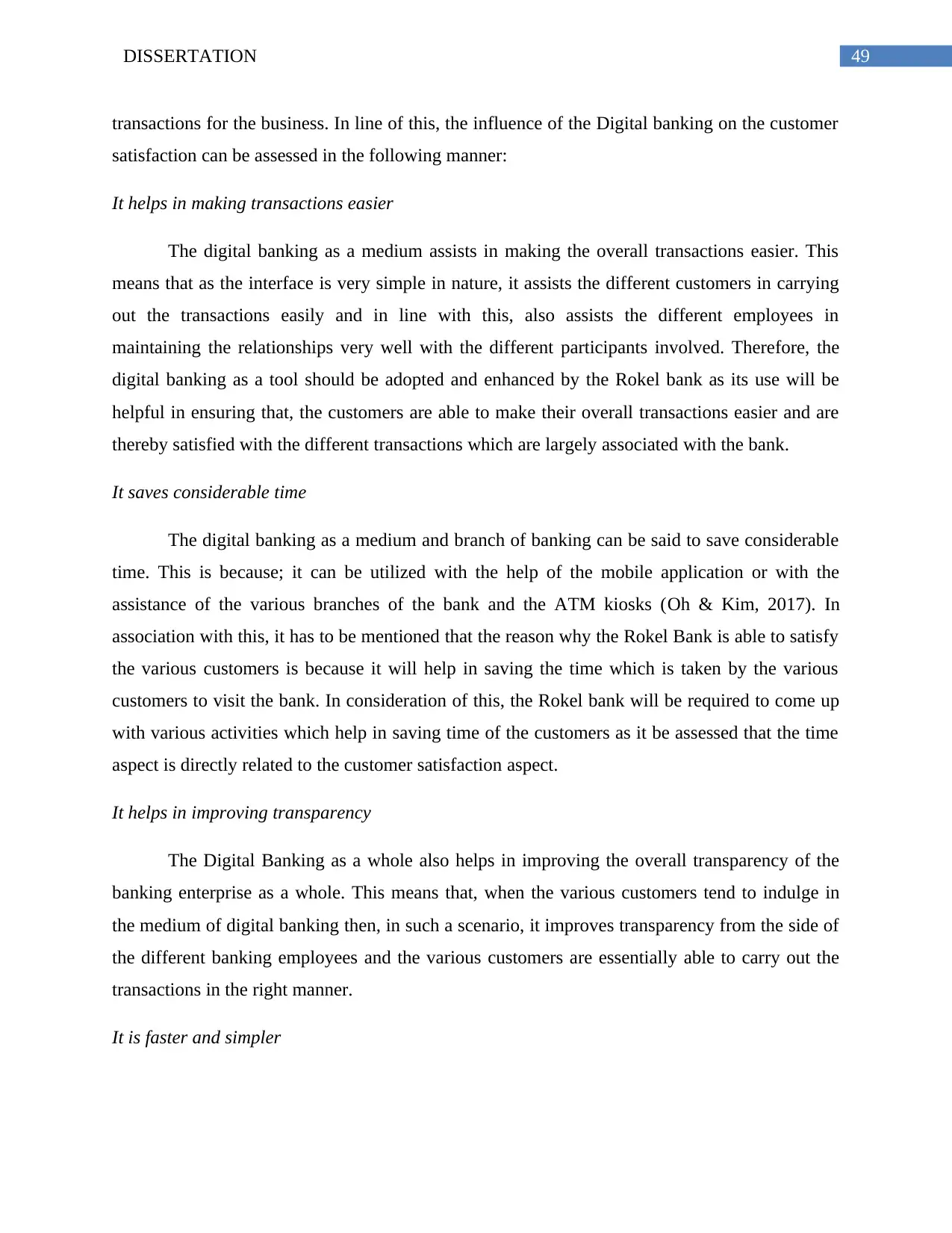
transactions for the business. In line of this, the influence of the Digital banking on the customer
satisfaction can be assessed in the following manner:
It helps in making transactions easier
The digital banking as a medium assists in making the overall transactions easier. This
means that as the interface is very simple in nature, it assists the different customers in carrying
out the transactions easily and in line with this, also assists the different employees in
maintaining the relationships very well with the different participants involved. Therefore, the
digital banking as a tool should be adopted and enhanced by the Rokel bank as its use will be
helpful in ensuring that, the customers are able to make their overall transactions easier and are
thereby satisfied with the different transactions which are largely associated with the bank.
It saves considerable time
The digital banking as a medium and branch of banking can be said to save considerable
time. This is because; it can be utilized with the help of the mobile application or with the
assistance of the various branches of the bank and the ATM kiosks (Oh & Kim, 2017). In
association with this, it has to be mentioned that the reason why the Rokel Bank is able to satisfy
the various customers is because it will help in saving the time which is taken by the various
customers to visit the bank. In consideration of this, the Rokel bank will be required to come up
with various activities which help in saving time of the customers as it be assessed that the time
aspect is directly related to the customer satisfaction aspect.
It helps in improving transparency
The Digital Banking as a whole also helps in improving the overall transparency of the
banking enterprise as a whole. This means that, when the various customers tend to indulge in
the medium of digital banking then, in such a scenario, it improves transparency from the side of
the different banking employees and the various customers are essentially able to carry out the
transactions in the right manner.
It is faster and simpler
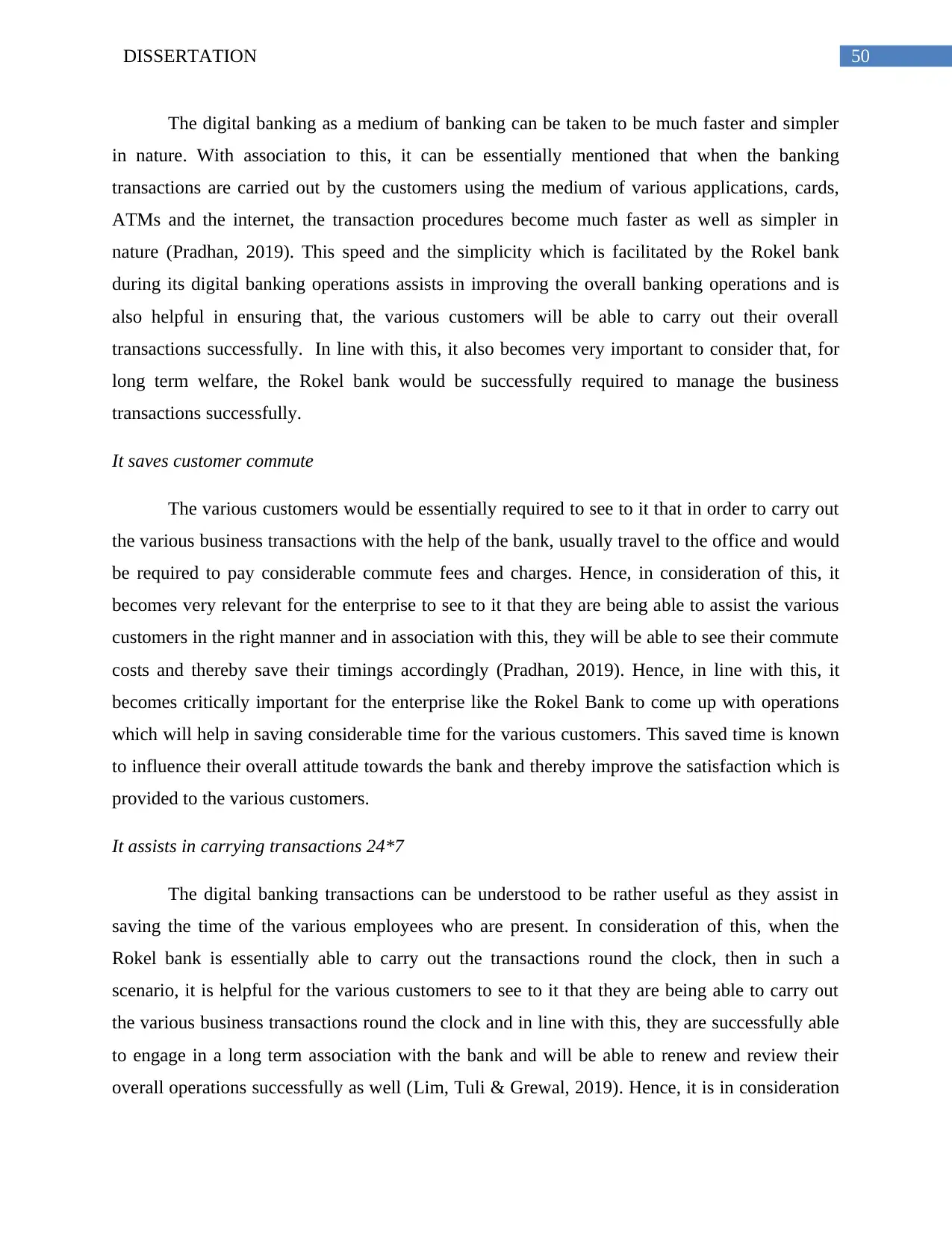
The digital banking as a medium of banking can be taken to be much faster and simpler
in nature. With association to this, it can be essentially mentioned that when the banking
transactions are carried out by the customers using the medium of various applications, cards,
ATMs and the internet, the transaction procedures become much faster as well as simpler in
nature (Pradhan, 2019). This speed and the simplicity which is facilitated by the Rokel bank
during its digital banking operations assists in improving the overall banking operations and is
also helpful in ensuring that, the various customers will be able to carry out their overall
transactions successfully. In line with this, it also becomes very important to consider that, for
long term welfare, the Rokel bank would be successfully required to manage the business
transactions successfully.
It saves customer commute
The various customers would be essentially required to see to it that in order to carry out
the various business transactions with the help of the bank, usually travel to the office and would
be required to pay considerable commute fees and charges. Hence, in consideration of this, it
becomes very relevant for the enterprise to see to it that they are being able to assist the various
customers in the right manner and in association with this, they will be able to see their commute
costs and thereby save their timings accordingly (Pradhan, 2019). Hence, in line with this, it
becomes critically important for the enterprise like the Rokel Bank to come up with operations
which will help in saving considerable time for the various customers. This saved time is known
to influence their overall attitude towards the bank and thereby improve the satisfaction which is
provided to the various customers.
It assists in carrying transactions 24*7
The digital banking transactions can be understood to be rather useful as they assist in
saving the time of the various employees who are present. In consideration of this, when the
Rokel bank is essentially able to carry out the transactions round the clock, then in such a
scenario, it is helpful for the various customers to see to it that they are being able to carry out
the various business transactions round the clock and in line with this, they are successfully able
to engage in a long term association with the bank and will be able to renew and review their
overall operations successfully as well (Lim, Tuli & Grewal, 2019). Hence, it is in consideration
⊘ This is a preview!⊘
Do you want full access?
Subscribe today to unlock all pages.

Trusted by 1+ million students worldwide
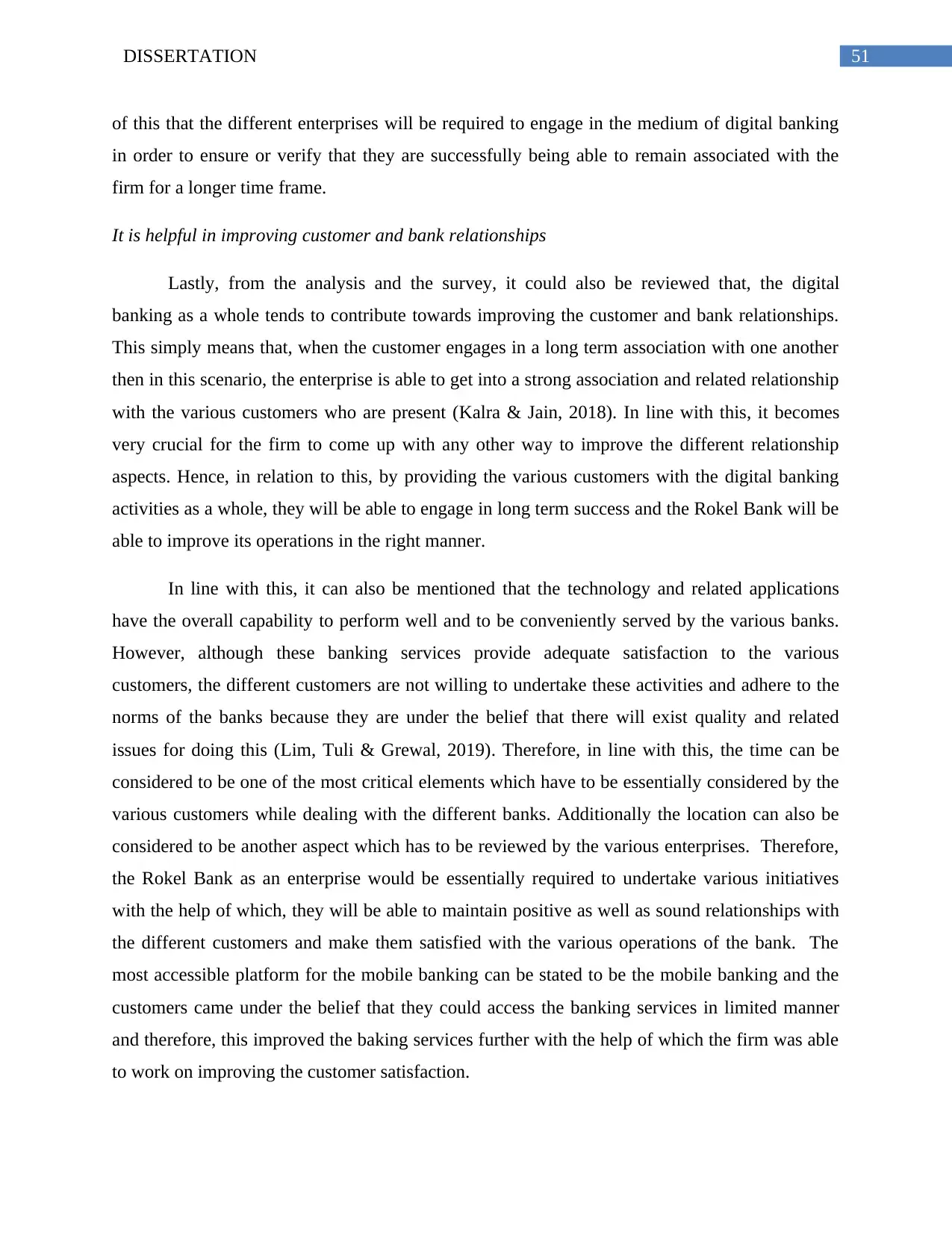
of this that the different enterprises will be required to engage in the medium of digital banking
in order to ensure or verify that they are successfully being able to remain associated with the
firm for a longer time frame.
It is helpful in improving customer and bank relationships
Lastly, from the analysis and the survey, it could also be reviewed that, the digital
banking as a whole tends to contribute towards improving the customer and bank relationships.
This simply means that, when the customer engages in a long term association with one another
then in this scenario, the enterprise is able to get into a strong association and related relationship
with the various customers who are present (Kalra & Jain, 2018). In line with this, it becomes
very crucial for the firm to come up with any other way to improve the different relationship
aspects. Hence, in relation to this, by providing the various customers with the digital banking
activities as a whole, they will be able to engage in long term success and the Rokel Bank will be
able to improve its operations in the right manner.
In line with this, it can also be mentioned that the technology and related applications
have the overall capability to perform well and to be conveniently served by the various banks.
However, although these banking services provide adequate satisfaction to the various
customers, the different customers are not willing to undertake these activities and adhere to the
norms of the banks because they are under the belief that there will exist quality and related
issues for doing this (Lim, Tuli & Grewal, 2019). Therefore, in line with this, the time can be
considered to be one of the most critical elements which have to be essentially considered by the
various customers while dealing with the different banks. Additionally the location can also be
considered to be another aspect which has to be reviewed by the various enterprises. Therefore,
the Rokel Bank as an enterprise would be essentially required to undertake various initiatives
with the help of which, they will be able to maintain positive as well as sound relationships with
the different customers and make them satisfied with the various operations of the bank. The
most accessible platform for the mobile banking can be stated to be the mobile banking and the
customers came under the belief that they could access the banking services in limited manner
and therefore, this improved the baking services further with the help of which the firm was able
to work on improving the customer satisfaction.
Paraphrase This Document
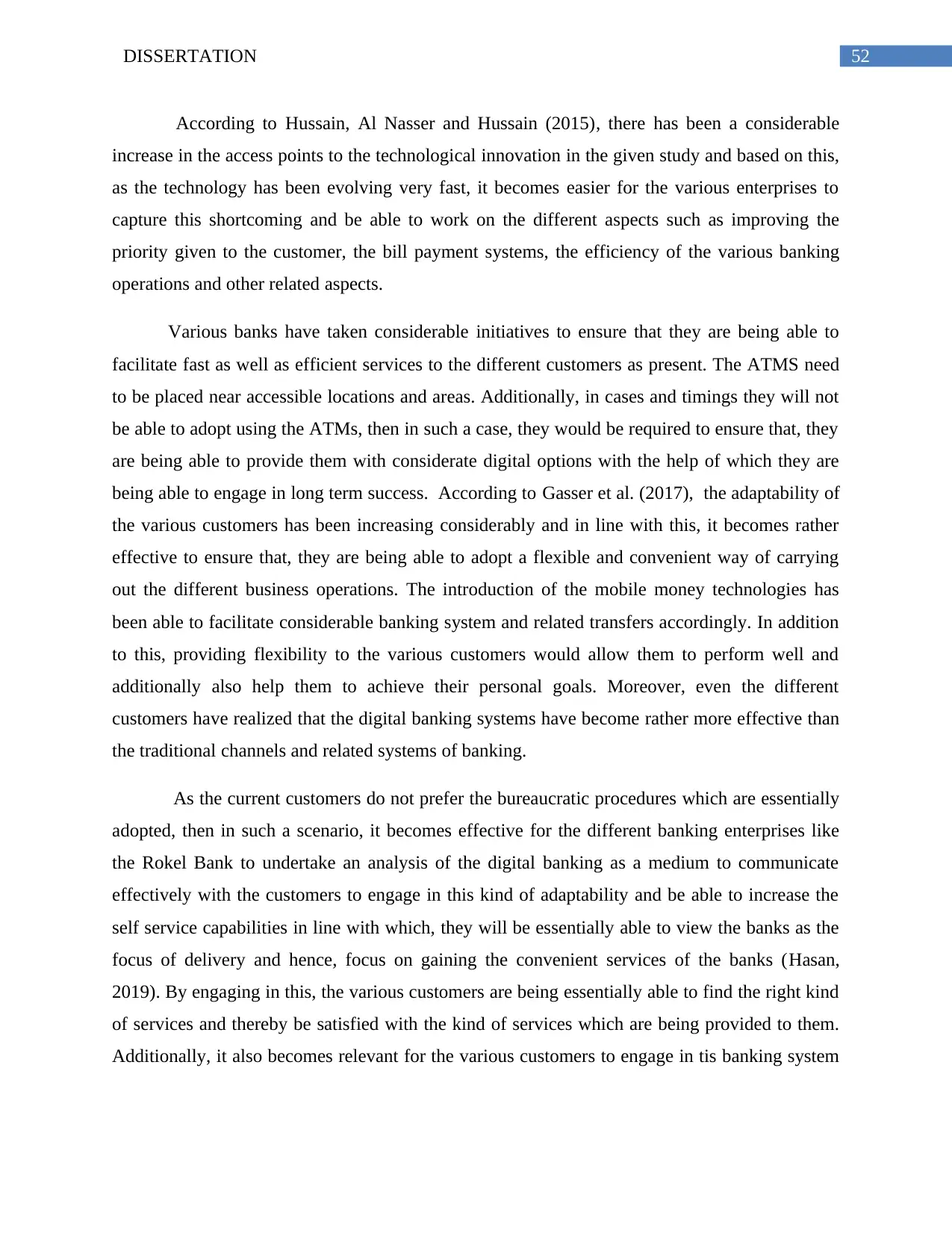
According to Hussain, Al Nasser and Hussain (2015), there has been a considerable
increase in the access points to the technological innovation in the given study and based on this,
as the technology has been evolving very fast, it becomes easier for the various enterprises to
capture this shortcoming and be able to work on the different aspects such as improving the
priority given to the customer, the bill payment systems, the efficiency of the various banking
operations and other related aspects.
Various banks have taken considerable initiatives to ensure that they are being able to
facilitate fast as well as efficient services to the different customers as present. The ATMS need
to be placed near accessible locations and areas. Additionally, in cases and timings they will not
be able to adopt using the ATMs, then in such a case, they would be required to ensure that, they
are being able to provide them with considerate digital options with the help of which they are
being able to engage in long term success. According to Gasser et al. (2017), the adaptability of
the various customers has been increasing considerably and in line with this, it becomes rather
effective to ensure that, they are being able to adopt a flexible and convenient way of carrying
out the different business operations. The introduction of the mobile money technologies has
been able to facilitate considerable banking system and related transfers accordingly. In addition
to this, providing flexibility to the various customers would allow them to perform well and
additionally also help them to achieve their personal goals. Moreover, even the different
customers have realized that the digital banking systems have become rather more effective than
the traditional channels and related systems of banking.
As the current customers do not prefer the bureaucratic procedures which are essentially
adopted, then in such a scenario, it becomes effective for the different banking enterprises like
the Rokel Bank to undertake an analysis of the digital banking as a medium to communicate
effectively with the customers to engage in this kind of adaptability and be able to increase the
self service capabilities in line with which, they will be essentially able to view the banks as the
focus of delivery and hence, focus on gaining the convenient services of the banks (Hasan,
2019). By engaging in this, the various customers are being essentially able to find the right kind
of services and thereby be satisfied with the kind of services which are being provided to them.
Additionally, it also becomes relevant for the various customers to engage in tis banking system

and hence, there exists a strong influence of the digital banking systems on the various customer
satisfactions.
⊘ This is a preview!⊘
Do you want full access?
Subscribe today to unlock all pages.

Trusted by 1+ million students worldwide
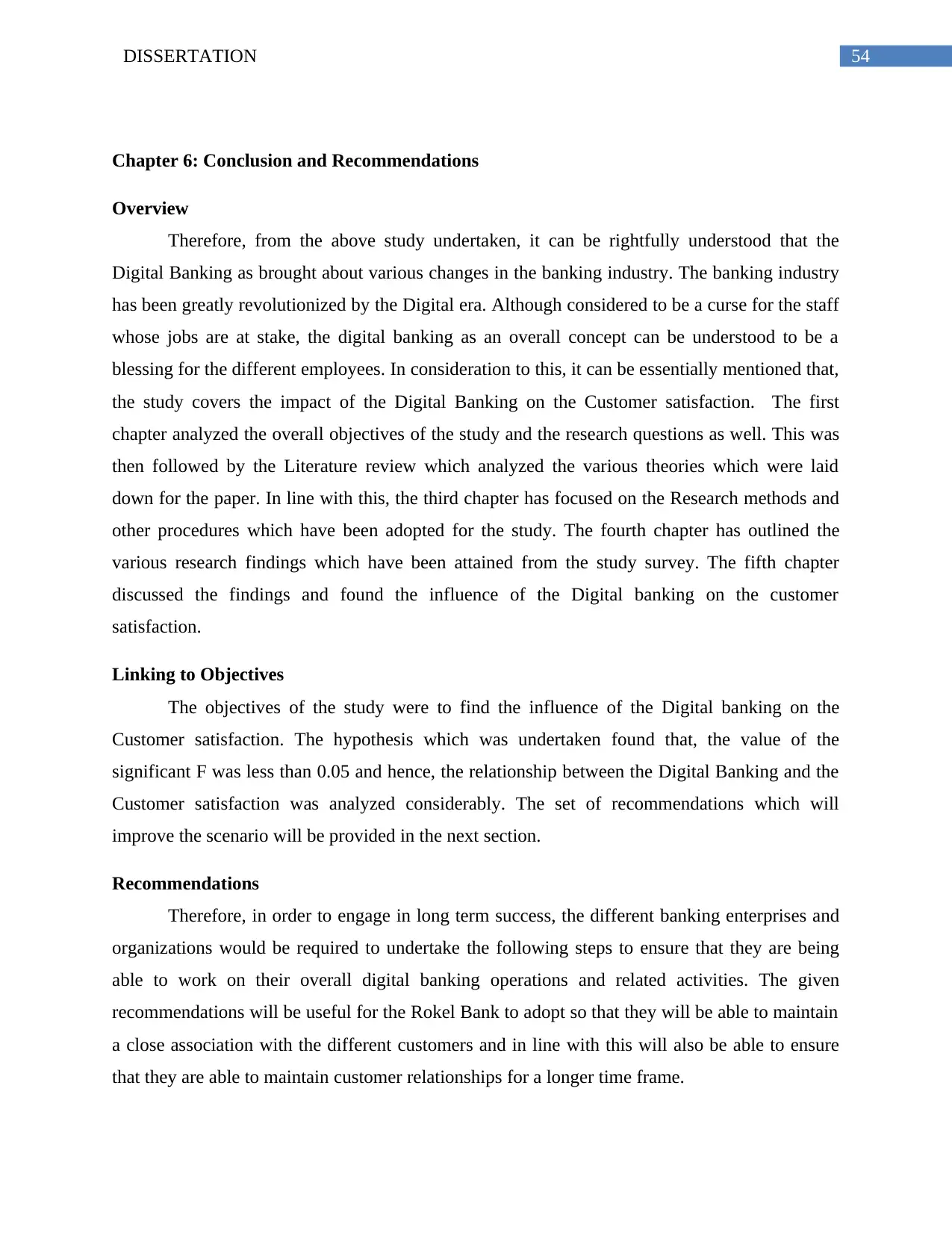
Chapter 6: Conclusion and Recommendations
Overview
Therefore, from the above study undertaken, it can be rightfully understood that the
Digital Banking as brought about various changes in the banking industry. The banking industry
has been greatly revolutionized by the Digital era. Although considered to be a curse for the staff
whose jobs are at stake, the digital banking as an overall concept can be understood to be a
blessing for the different employees. In consideration to this, it can be essentially mentioned that,
the study covers the impact of the Digital Banking on the Customer satisfaction. The first
chapter analyzed the overall objectives of the study and the research questions as well. This was
then followed by the Literature review which analyzed the various theories which were laid
down for the paper. In line with this, the third chapter has focused on the Research methods and
other procedures which have been adopted for the study. The fourth chapter has outlined the
various research findings which have been attained from the study survey. The fifth chapter
discussed the findings and found the influence of the Digital banking on the customer
satisfaction.
Linking to Objectives
The objectives of the study were to find the influence of the Digital banking on the
Customer satisfaction. The hypothesis which was undertaken found that, the value of the
significant F was less than 0.05 and hence, the relationship between the Digital Banking and the
Customer satisfaction was analyzed considerably. The set of recommendations which will
improve the scenario will be provided in the next section.
Recommendations
Therefore, in order to engage in long term success, the different banking enterprises and
organizations would be required to undertake the following steps to ensure that they are being
able to work on their overall digital banking operations and related activities. The given
recommendations will be useful for the Rokel Bank to adopt so that they will be able to maintain
a close association with the different customers and in line with this will also be able to ensure
that they are able to maintain customer relationships for a longer time frame.
Paraphrase This Document
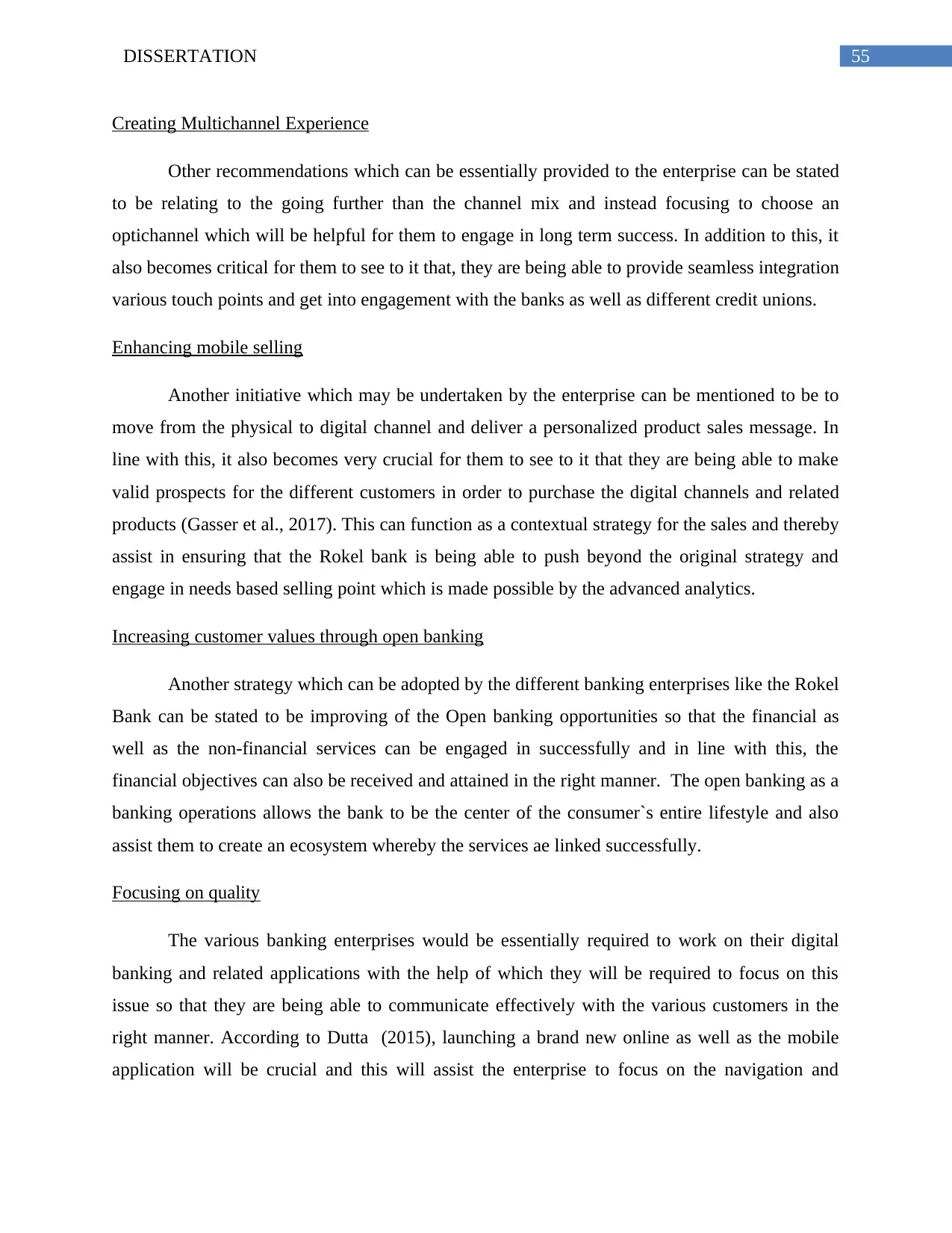
Creating Multichannel Experience
Other recommendations which can be essentially provided to the enterprise can be stated
to be relating to the going further than the channel mix and instead focusing to choose an
optichannel which will be helpful for them to engage in long term success. In addition to this, it
also becomes critical for them to see to it that, they are being able to provide seamless integration
various touch points and get into engagement with the banks as well as different credit unions.
Enhancing mobile selling
Another initiative which may be undertaken by the enterprise can be mentioned to be to
move from the physical to digital channel and deliver a personalized product sales message. In
line with this, it also becomes very crucial for them to see to it that they are being able to make
valid prospects for the different customers in order to purchase the digital channels and related
products (Gasser et al., 2017). This can function as a contextual strategy for the sales and thereby
assist in ensuring that the Rokel bank is being able to push beyond the original strategy and
engage in needs based selling point which is made possible by the advanced analytics.
Increasing customer values through open banking
Another strategy which can be adopted by the different banking enterprises like the Rokel
Bank can be stated to be improving of the Open banking opportunities so that the financial as
well as the non-financial services can be engaged in successfully and in line with this, the
financial objectives can also be received and attained in the right manner. The open banking as a
banking operations allows the bank to be the center of the consumer`s entire lifestyle and also
assist them to create an ecosystem whereby the services ae linked successfully.
Focusing on quality
The various banking enterprises would be essentially required to work on their digital
banking and related applications with the help of which they will be required to focus on this
issue so that they are being able to communicate effectively with the various customers in the
right manner. According to Dutta (2015), launching a brand new online as well as the mobile
application will be crucial and this will assist the enterprise to focus on the navigation and
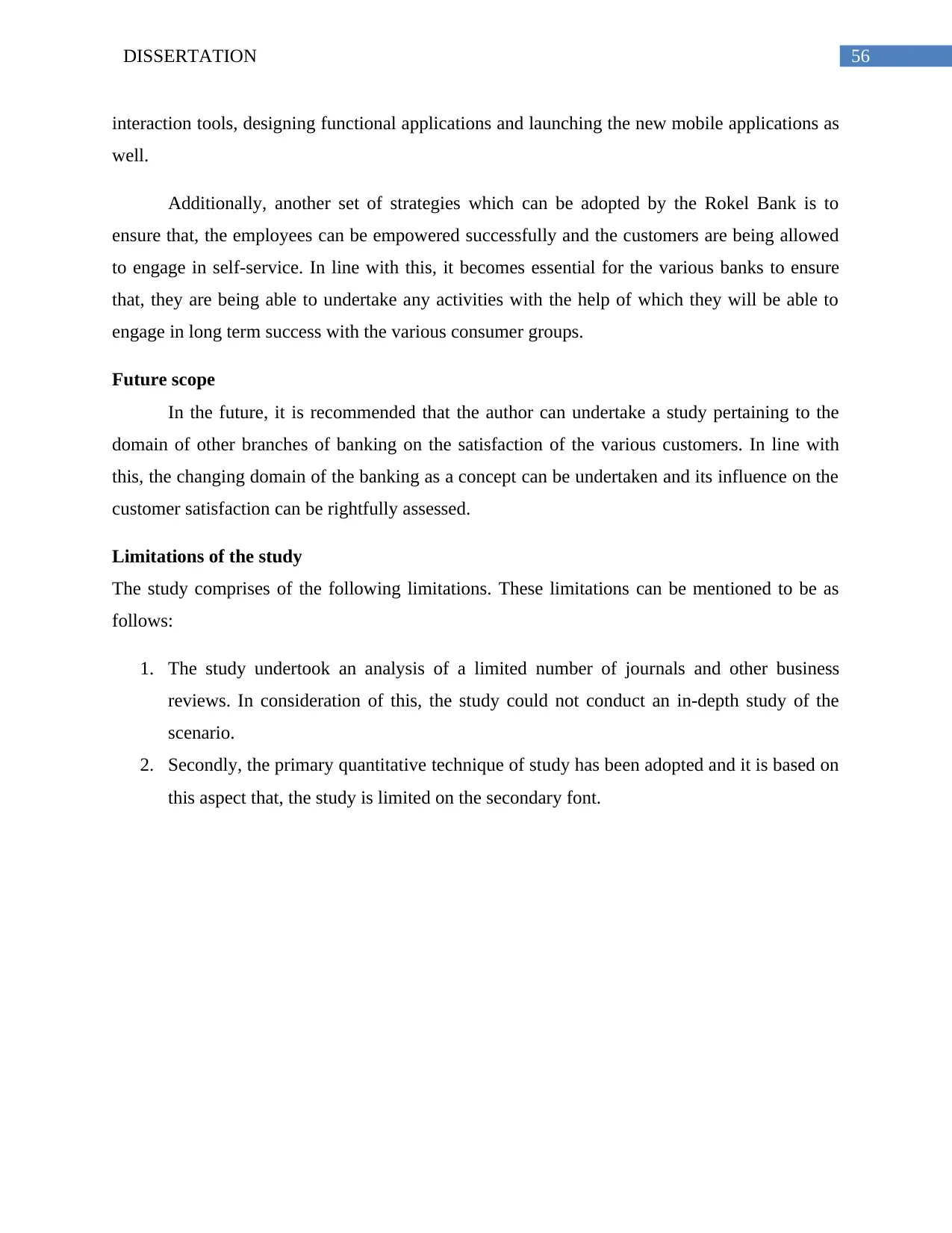
interaction tools, designing functional applications and launching the new mobile applications as
well.
Additionally, another set of strategies which can be adopted by the Rokel Bank is to
ensure that, the employees can be empowered successfully and the customers are being allowed
to engage in self-service. In line with this, it becomes essential for the various banks to ensure
that, they are being able to undertake any activities with the help of which they will be able to
engage in long term success with the various consumer groups.
Future scope
In the future, it is recommended that the author can undertake a study pertaining to the
domain of other branches of banking on the satisfaction of the various customers. In line with
this, the changing domain of the banking as a concept can be undertaken and its influence on the
customer satisfaction can be rightfully assessed.
Limitations of the study
The study comprises of the following limitations. These limitations can be mentioned to be as
follows:
1. The study undertook an analysis of a limited number of journals and other business
reviews. In consideration of this, the study could not conduct an in-depth study of the
scenario.
2. Secondly, the primary quantitative technique of study has been adopted and it is based on
this aspect that, the study is limited on the secondary font.
⊘ This is a preview!⊘
Do you want full access?
Subscribe today to unlock all pages.

Trusted by 1+ million students worldwide
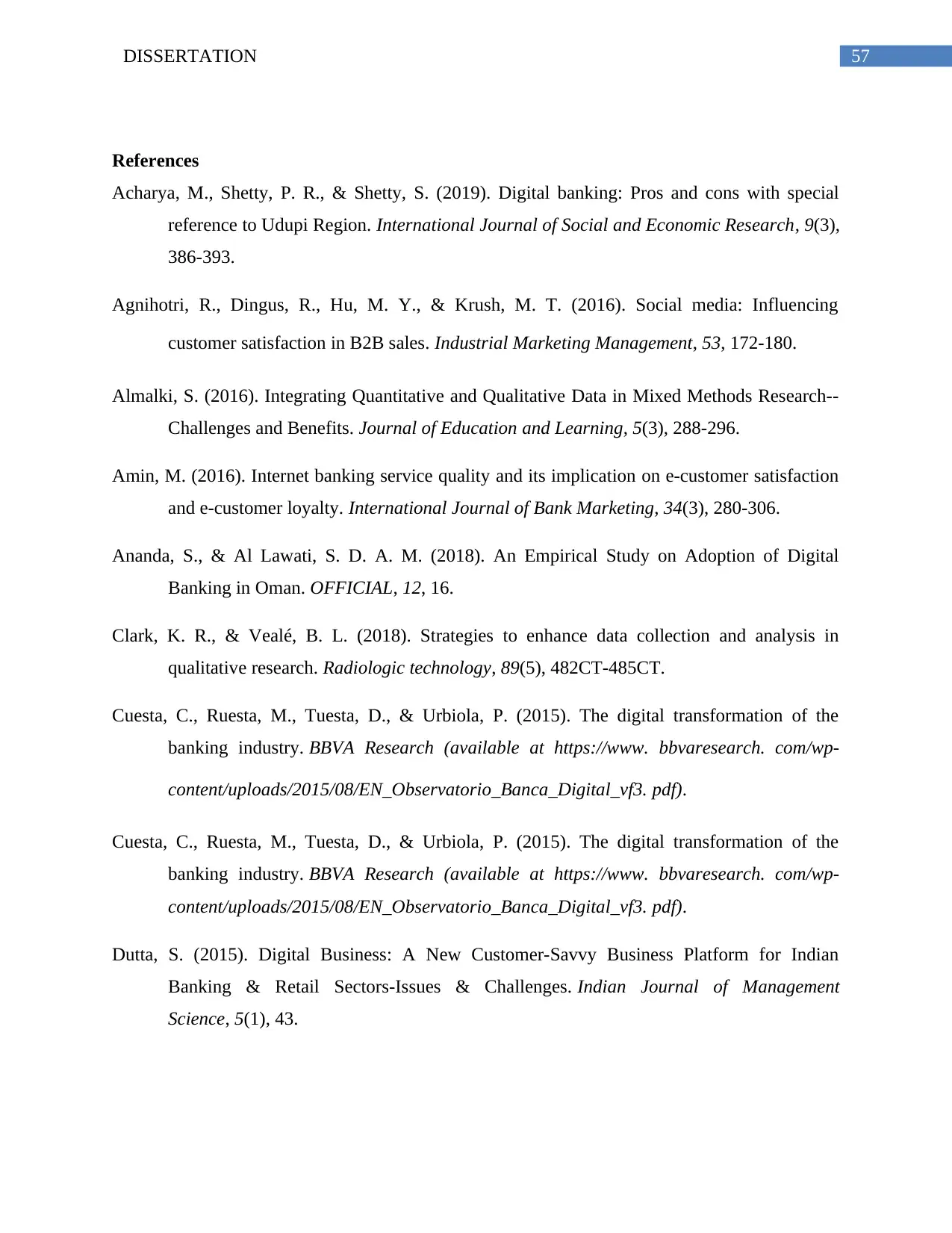
References
Acharya, M., Shetty, P. R., & Shetty, S. (2019). Digital banking: Pros and cons with special
reference to Udupi Region. International Journal of Social and Economic Research, 9(3),
386-393.
Agnihotri, R., Dingus, R., Hu, M. Y., & Krush, M. T. (2016). Social media: Influencing
customer satisfaction in B2B sales. Industrial Marketing Management, 53, 172-180.
Almalki, S. (2016). Integrating Quantitative and Qualitative Data in Mixed Methods Research--
Challenges and Benefits. Journal of Education and Learning, 5(3), 288-296.
Amin, M. (2016). Internet banking service quality and its implication on e-customer satisfaction
and e-customer loyalty. International Journal of Bank Marketing, 34(3), 280-306.
Ananda, S., & Al Lawati, S. D. A. M. (2018). An Empirical Study on Adoption of Digital
Banking in Oman. OFFICIAL, 12, 16.
Clark, K. R., & Vealé, B. L. (2018). Strategies to enhance data collection and analysis in
qualitative research. Radiologic technology, 89(5), 482CT-485CT.
Cuesta, C., Ruesta, M., Tuesta, D., & Urbiola, P. (2015). The digital transformation of the
banking industry. BBVA Research (available at https://www. bbvaresearch. com/wp-
content/uploads/2015/08/EN_Observatorio_Banca_Digital_vf3. pdf).
Cuesta, C., Ruesta, M., Tuesta, D., & Urbiola, P. (2015). The digital transformation of the
banking industry. BBVA Research (available at https://www. bbvaresearch. com/wp-
content/uploads/2015/08/EN_Observatorio_Banca_Digital_vf3. pdf).
Dutta, S. (2015). Digital Business: A New Customer-Savvy Business Platform for Indian
Banking & Retail Sectors-Issues & Challenges. Indian Journal of Management
Science, 5(1), 43.
Paraphrase This Document
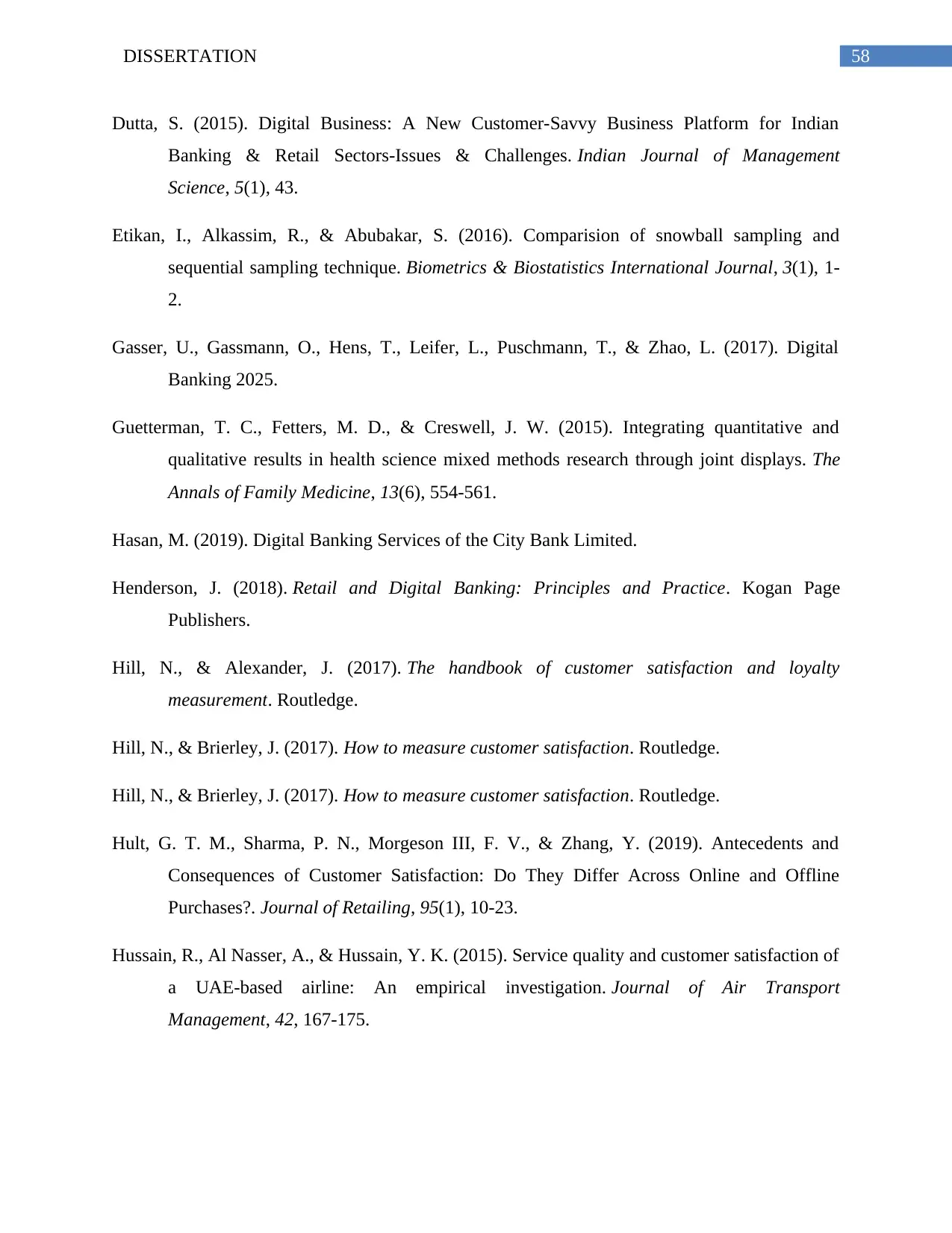
Dutta, S. (2015). Digital Business: A New Customer-Savvy Business Platform for Indian
Banking & Retail Sectors-Issues & Challenges. Indian Journal of Management
Science, 5(1), 43.
Etikan, I., Alkassim, R., & Abubakar, S. (2016). Comparision of snowball sampling and
sequential sampling technique. Biometrics & Biostatistics International Journal, 3(1), 1-
2.
Gasser, U., Gassmann, O., Hens, T., Leifer, L., Puschmann, T., & Zhao, L. (2017). Digital
Banking 2025.
Guetterman, T. C., Fetters, M. D., & Creswell, J. W. (2015). Integrating quantitative and
qualitative results in health science mixed methods research through joint displays. The
Annals of Family Medicine, 13(6), 554-561.
Hasan, M. (2019). Digital Banking Services of the City Bank Limited.
Henderson, J. (2018). Retail and Digital Banking: Principles and Practice. Kogan Page
Publishers.
Hill, N., & Alexander, J. (2017). The handbook of customer satisfaction and loyalty
measurement. Routledge.
Hill, N., & Brierley, J. (2017). How to measure customer satisfaction. Routledge.
Hill, N., & Brierley, J. (2017). How to measure customer satisfaction. Routledge.
Hult, G. T. M., Sharma, P. N., Morgeson III, F. V., & Zhang, Y. (2019). Antecedents and
Consequences of Customer Satisfaction: Do They Differ Across Online and Offline
Purchases?. Journal of Retailing, 95(1), 10-23.
Hussain, R., Al Nasser, A., & Hussain, Y. K. (2015). Service quality and customer satisfaction of
a UAE-based airline: An empirical investigation. Journal of Air Transport
Management, 42, 167-175.
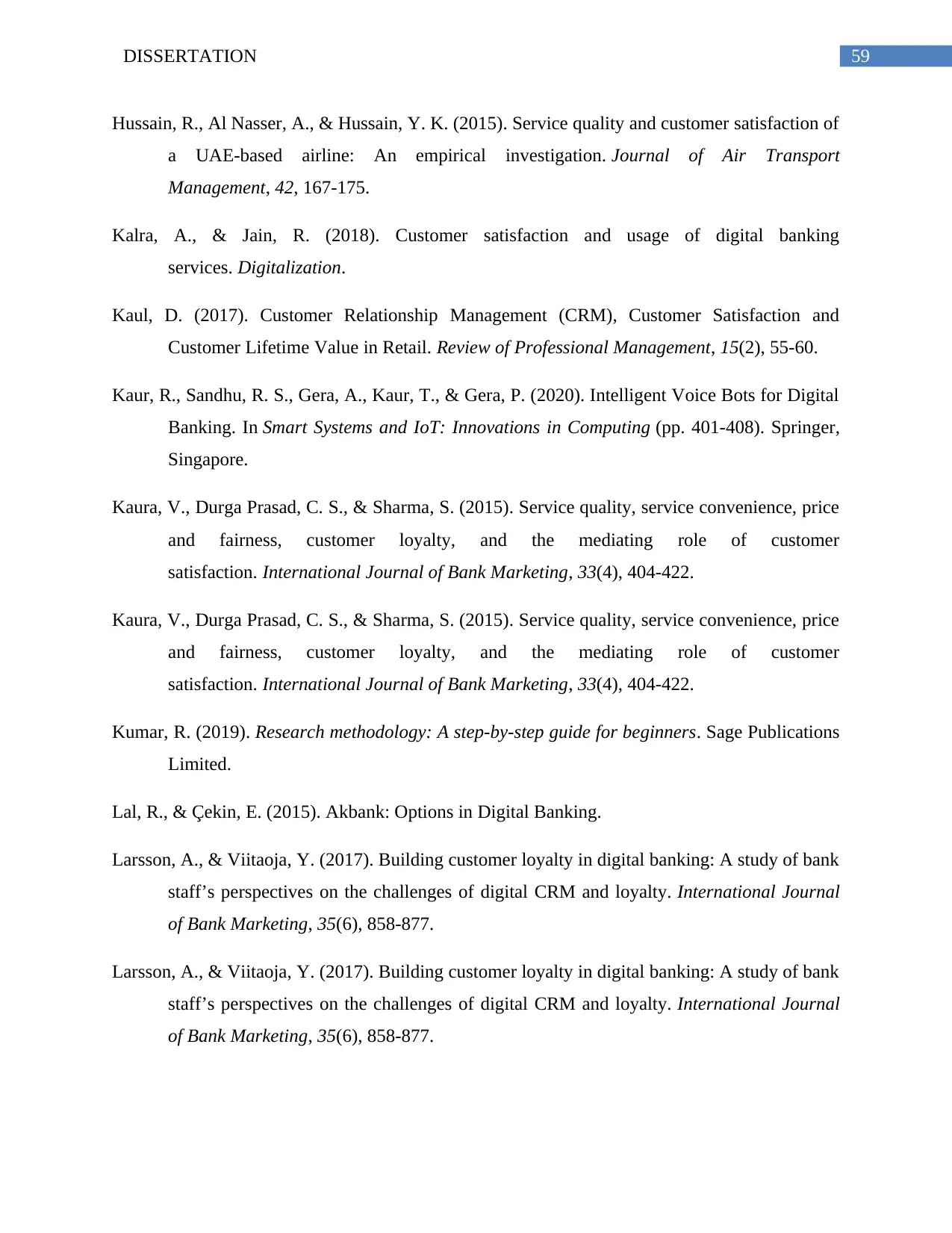
Hussain, R., Al Nasser, A., & Hussain, Y. K. (2015). Service quality and customer satisfaction of
a UAE-based airline: An empirical investigation. Journal of Air Transport
Management, 42, 167-175.
Kalra, A., & Jain, R. (2018). Customer satisfaction and usage of digital banking
services. Digitalization.
Kaul, D. (2017). Customer Relationship Management (CRM), Customer Satisfaction and
Customer Lifetime Value in Retail. Review of Professional Management, 15(2), 55-60.
Kaur, R., Sandhu, R. S., Gera, A., Kaur, T., & Gera, P. (2020). Intelligent Voice Bots for Digital
Banking. In Smart Systems and IoT: Innovations in Computing (pp. 401-408). Springer,
Singapore.
Kaura, V., Durga Prasad, C. S., & Sharma, S. (2015). Service quality, service convenience, price
and fairness, customer loyalty, and the mediating role of customer
satisfaction. International Journal of Bank Marketing, 33(4), 404-422.
Kaura, V., Durga Prasad, C. S., & Sharma, S. (2015). Service quality, service convenience, price
and fairness, customer loyalty, and the mediating role of customer
satisfaction. International Journal of Bank Marketing, 33(4), 404-422.
Kumar, R. (2019). Research methodology: A step-by-step guide for beginners. Sage Publications
Limited.
Lal, R., & Çekin, E. (2015). Akbank: Options in Digital Banking.
Larsson, A., & Viitaoja, Y. (2017). Building customer loyalty in digital banking: A study of bank
staff’s perspectives on the challenges of digital CRM and loyalty. International Journal
of Bank Marketing, 35(6), 858-877.
Larsson, A., & Viitaoja, Y. (2017). Building customer loyalty in digital banking: A study of bank
staff’s perspectives on the challenges of digital CRM and loyalty. International Journal
of Bank Marketing, 35(6), 858-877.
⊘ This is a preview!⊘
Do you want full access?
Subscribe today to unlock all pages.

Trusted by 1+ million students worldwide
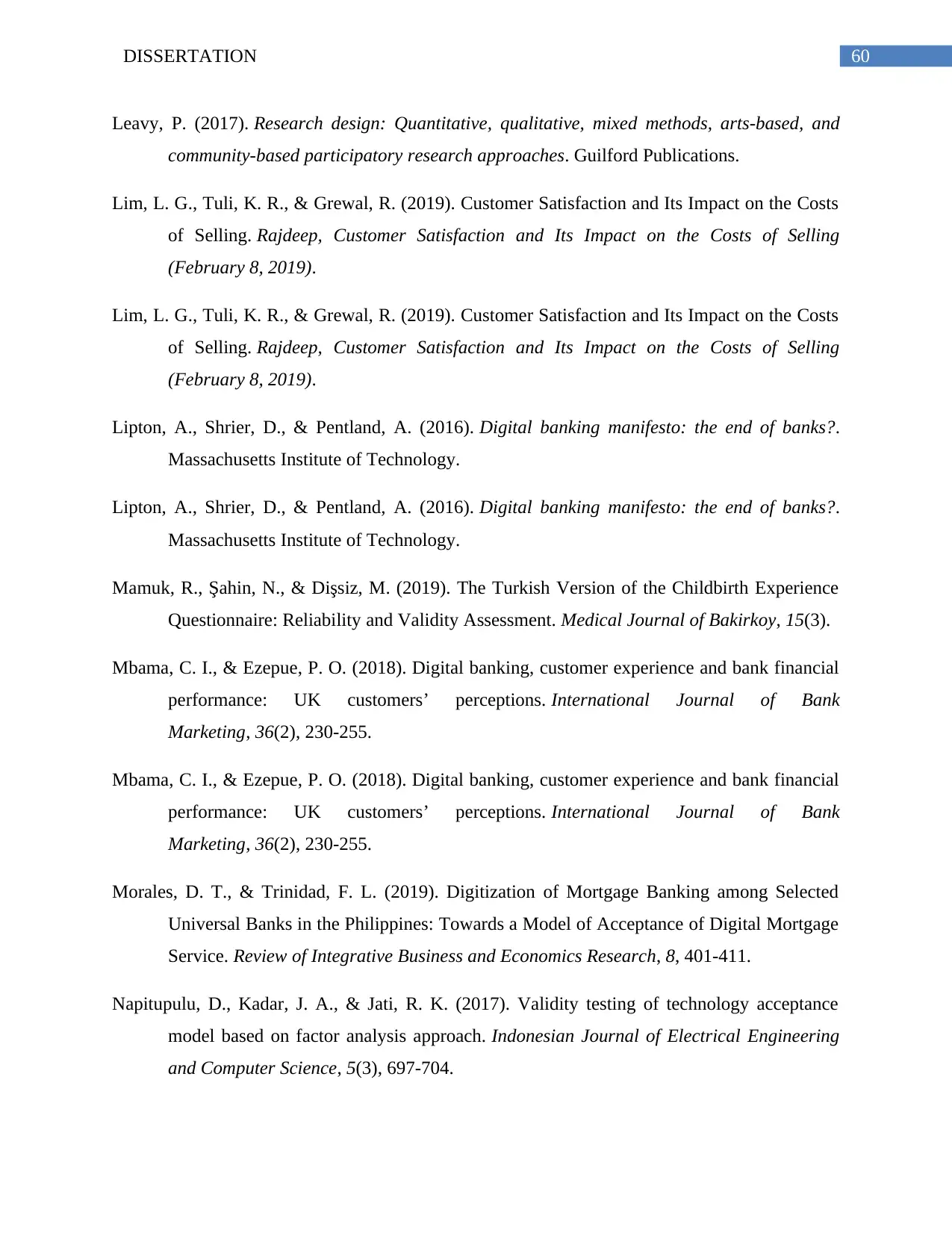
Leavy, P. (2017). Research design: Quantitative, qualitative, mixed methods, arts-based, and
community-based participatory research approaches. Guilford Publications.
Lim, L. G., Tuli, K. R., & Grewal, R. (2019). Customer Satisfaction and Its Impact on the Costs
of Selling. Rajdeep, Customer Satisfaction and Its Impact on the Costs of Selling
(February 8, 2019).
Lim, L. G., Tuli, K. R., & Grewal, R. (2019). Customer Satisfaction and Its Impact on the Costs
of Selling. Rajdeep, Customer Satisfaction and Its Impact on the Costs of Selling
(February 8, 2019).
Lipton, A., Shrier, D., & Pentland, A. (2016). Digital banking manifesto: the end of banks?.
Massachusetts Institute of Technology.
Lipton, A., Shrier, D., & Pentland, A. (2016). Digital banking manifesto: the end of banks?.
Massachusetts Institute of Technology.
Mamuk, R., Şahin, N., & Dişsiz, M. (2019). The Turkish Version of the Childbirth Experience
Questionnaire: Reliability and Validity Assessment. Medical Journal of Bakirkoy, 15(3).
Mbama, C. I., & Ezepue, P. O. (2018). Digital banking, customer experience and bank financial
performance: UK customers’ perceptions. International Journal of Bank
Marketing, 36(2), 230-255.
Mbama, C. I., & Ezepue, P. O. (2018). Digital banking, customer experience and bank financial
performance: UK customers’ perceptions. International Journal of Bank
Marketing, 36(2), 230-255.
Morales, D. T., & Trinidad, F. L. (2019). Digitization of Mortgage Banking among Selected
Universal Banks in the Philippines: Towards a Model of Acceptance of Digital Mortgage
Service. Review of Integrative Business and Economics Research, 8, 401-411.
Napitupulu, D., Kadar, J. A., & Jati, R. K. (2017). Validity testing of technology acceptance
model based on factor analysis approach. Indonesian Journal of Electrical Engineering
and Computer Science, 5(3), 697-704.
Paraphrase This Document
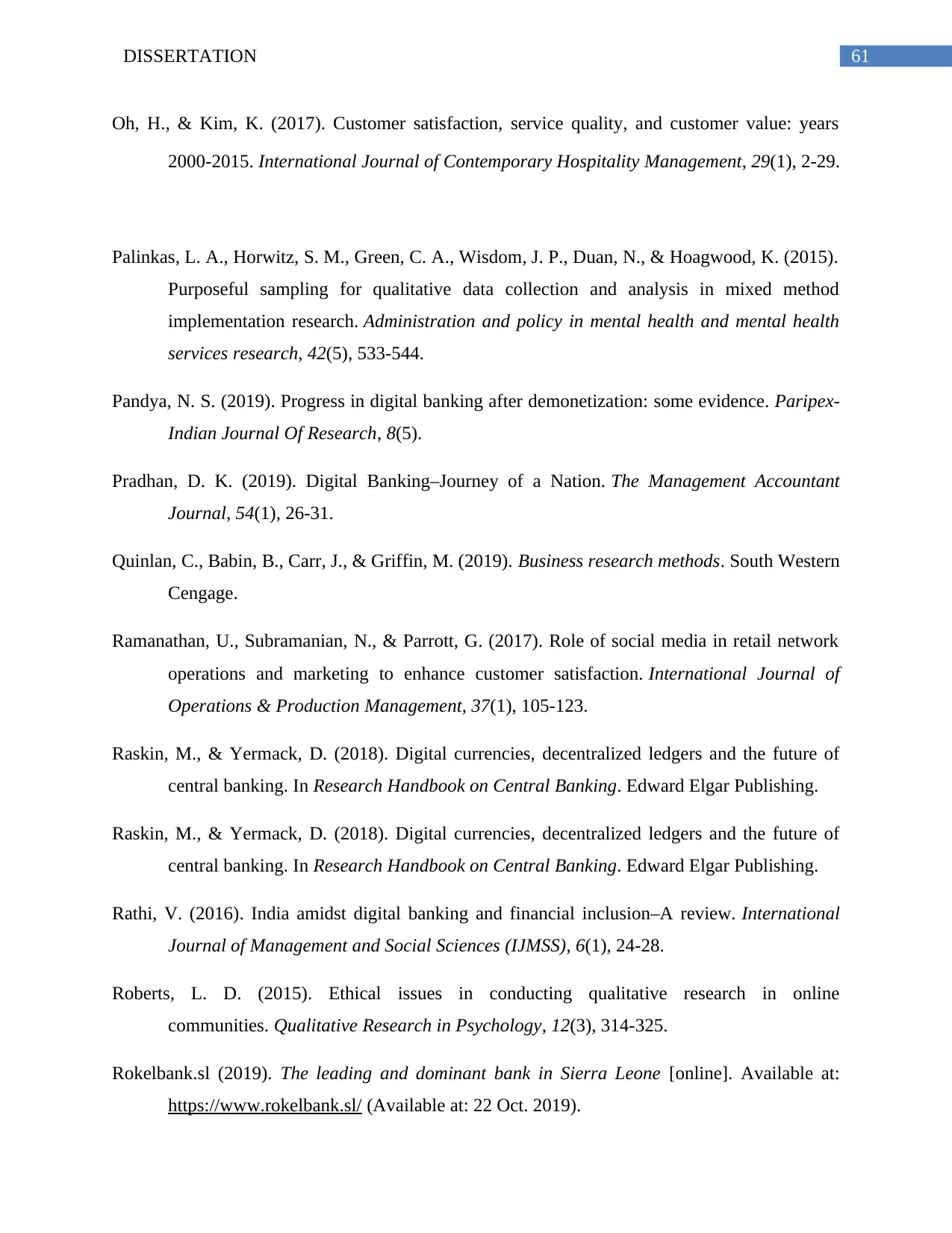
Oh, H., & Kim, K. (2017). Customer satisfaction, service quality, and customer value: years
2000-2015. International Journal of Contemporary Hospitality Management, 29(1), 2-29.
Palinkas, L. A., Horwitz, S. M., Green, C. A., Wisdom, J. P., Duan, N., & Hoagwood, K. (2015).
Purposeful sampling for qualitative data collection and analysis in mixed method
implementation research. Administration and policy in mental health and mental health
services research, 42(5), 533-544.
Pandya, N. S. (2019). Progress in digital banking after demonetization: some evidence. Paripex-
Indian Journal Of Research, 8(5).
Pradhan, D. K. (2019). Digital Banking–Journey of a Nation. The Management Accountant
Journal, 54(1), 26-31.
Quinlan, C., Babin, B., Carr, J., & Griffin, M. (2019). Business research methods. South Western
Cengage.
Ramanathan, U., Subramanian, N., & Parrott, G. (2017). Role of social media in retail network
operations and marketing to enhance customer satisfaction. International Journal of
Operations & Production Management, 37(1), 105-123.
Raskin, M., & Yermack, D. (2018). Digital currencies, decentralized ledgers and the future of
central banking. In Research Handbook on Central Banking. Edward Elgar Publishing.
Raskin, M., & Yermack, D. (2018). Digital currencies, decentralized ledgers and the future of
central banking. In Research Handbook on Central Banking. Edward Elgar Publishing.
Rathi, V. (2016). India amidst digital banking and financial inclusion–A review. International
Journal of Management and Social Sciences (IJMSS), 6(1), 24-28.
Roberts, L. D. (2015). Ethical issues in conducting qualitative research in online
communities. Qualitative Research in Psychology, 12(3), 314-325.
Rokelbank.sl (2019). The leading and dominant bank in Sierra Leone [online]. Available at:
https://www.rokelbank.sl/ (Available at: 22 Oct. 2019).
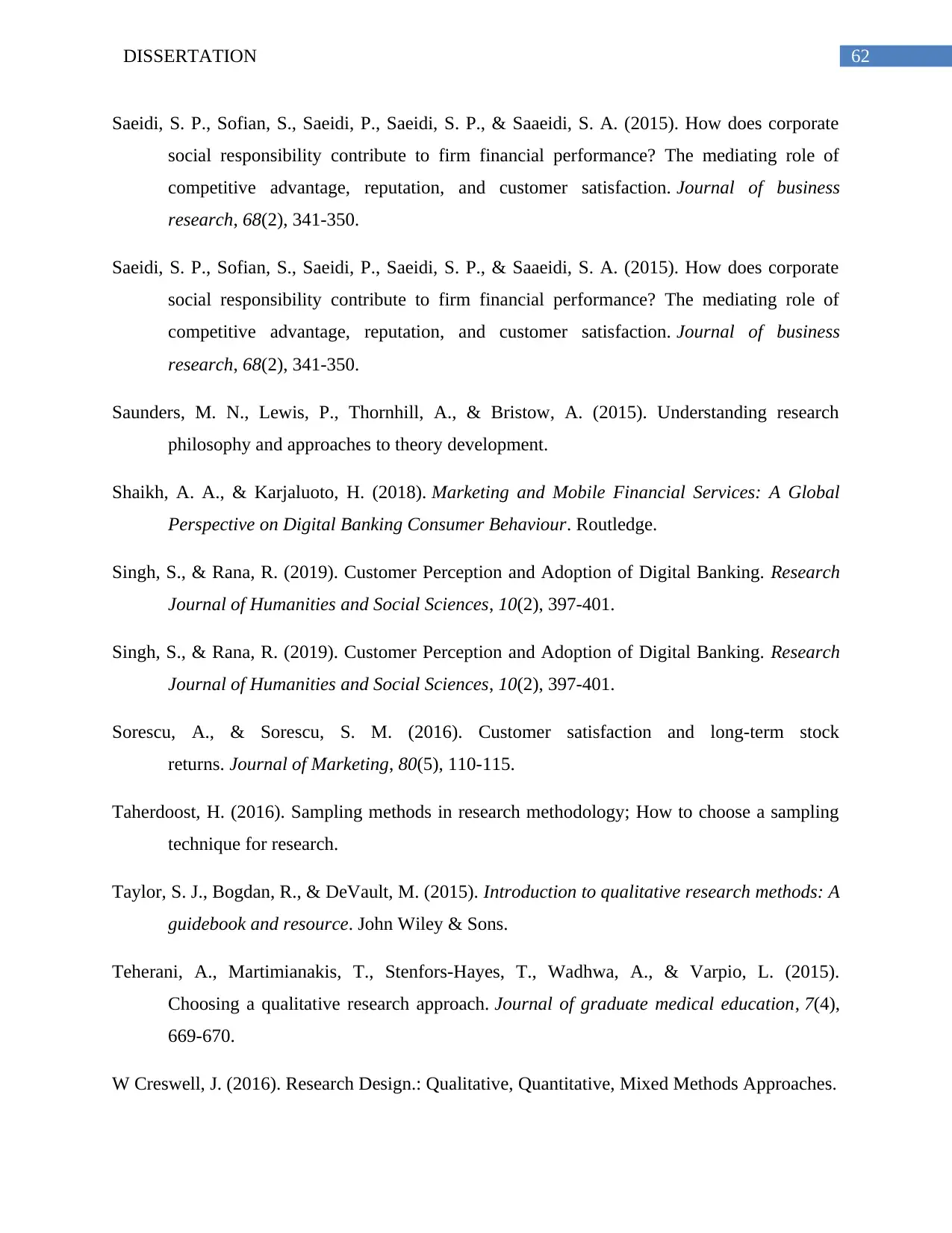
Saeidi, S. P., Sofian, S., Saeidi, P., Saeidi, S. P., & Saaeidi, S. A. (2015). How does corporate
social responsibility contribute to firm financial performance? The mediating role of
competitive advantage, reputation, and customer satisfaction. Journal of business
research, 68(2), 341-350.
Saeidi, S. P., Sofian, S., Saeidi, P., Saeidi, S. P., & Saaeidi, S. A. (2015). How does corporate
social responsibility contribute to firm financial performance? The mediating role of
competitive advantage, reputation, and customer satisfaction. Journal of business
research, 68(2), 341-350.
Saunders, M. N., Lewis, P., Thornhill, A., & Bristow, A. (2015). Understanding research
philosophy and approaches to theory development.
Shaikh, A. A., & Karjaluoto, H. (2018). Marketing and Mobile Financial Services: A Global
Perspective on Digital Banking Consumer Behaviour. Routledge.
Singh, S., & Rana, R. (2019). Customer Perception and Adoption of Digital Banking. Research
Journal of Humanities and Social Sciences, 10(2), 397-401.
Singh, S., & Rana, R. (2019). Customer Perception and Adoption of Digital Banking. Research
Journal of Humanities and Social Sciences, 10(2), 397-401.
Sorescu, A., & Sorescu, S. M. (2016). Customer satisfaction and long-term stock
returns. Journal of Marketing, 80(5), 110-115.
Taherdoost, H. (2016). Sampling methods in research methodology; How to choose a sampling
technique for research.
Taylor, S. J., Bogdan, R., & DeVault, M. (2015). Introduction to qualitative research methods: A
guidebook and resource. John Wiley & Sons.
Teherani, A., Martimianakis, T., Stenfors-Hayes, T., Wadhwa, A., & Varpio, L. (2015).
Choosing a qualitative research approach. Journal of graduate medical education, 7(4),
669-670.
W Creswell, J. (2016). Research Design.: Qualitative, Quantitative, Mixed Methods Approaches.
⊘ This is a preview!⊘
Do you want full access?
Subscribe today to unlock all pages.

Trusted by 1+ million students worldwide

Zablah, A. R., Carlson, B. D., Donavan, D. T., Maxham III, J. G., & Brown, T. J. (2016). A
cross-lagged test of the association between customer satisfaction and employee job
satisfaction in a relational context. Journal of Applied Psychology, 101(5), 743.
Related Documents
Your All-in-One AI-Powered Toolkit for Academic Success.
+13062052269
info@desklib.com
Available 24*7 on WhatsApp / Email
![[object Object]](/_next/static/media/star-bottom.7253800d.svg)
© 2024 | Zucol Services PVT LTD | All rights reserved.





